Sanyo Electric Co SCP-PRO200 Cellular/ PCS CDMA Phone with Bluetooth User Manual Sprint CDMA QX UG 6a VI 3 052806
Sanyo Electric Co Ltd Cellular/ PCS CDMA Phone with Bluetooth Sprint CDMA QX UG 6a VI 3 052806
Users Manual

Phone User Guide
www.sprint.com
© 2007 Sprint Nextel. All rights reserved. SPRINT, the NEXTEL name and
logo, and other trademarks are trademarks of Sprint Nextel. SANYO is a
registered trademark of SANYO Electric Co., Ltd.
PRO-200 by SANYO®

Table of Contents
Introduction . . . . . . . . . . . . . . . . . . . . . . . . . . . . . . . . . . . . . .i
Your Phone’s Menu . . . . . . . . . . . . . . . . . . . . . . . . . . . . . . .iii
Section 1: Getting Started . . . . . . . . . . . . . . . . . . . . . . . . . .1
1A. Setting Up Service . . . . . . . . . . . . . . . . . . . . . . . . . . . . . . . . .2
Setting Up Your Phone . . . . . . . . . . . . . . . . . . . . . . . . . . . . . . . . . . . . . . .3
Getting Started With Sprint Service . . . . . . . . . . . . . . . . . . . . . . . . . . .4
Setting Up Your Voicemail . . . . . . . . . . . . . . . . . . . . . . . . . . . . . . . . . . . .6
Sprint Account Passwords . . . . . . . . . . . . . . . . . . . . . . . . . . . . . . . . . . .7
Getting Help . . . . . . . . . . . . . . . . . . . . . . . . . . . . . . . . . . . . . . . . . . . . . . . .8
Section 2: Using Your Phone . . . . . . . . . . . . . . . . . . . . . . .11
2A. Phone Basics . . . . . . . . . . . . . . . . . . . . . . . . . . . . . . . . . . . . .12
Your Phone . . . . . . . . . . . . . . . . . . . . . . . . . . . . . . . . . . . . . . . . . . . . . . . .13
Viewing the Display Screen . . . . . . . . . . . . . . . . . . . . . . . . . . . . . . . . .17
Features of Your Phone . . . . . . . . . . . . . . . . . . . . . . . . . . . . . . . . . . . . .20
Turning Your Phone On and Off ..............................22
Using Your Phone’s Battery and Charger . . . . . . . . . . . . . . . . . . . . .23
Using the Holster . . . . . . . . . . . . . . . . . . . . . . . . . . . . . . . . . . . . . . . . . .26
Navigating Through Phone Menus . . . . . . . . . . . . . . . . . . . . . . . . . .27
Displaying Your Phone Number . . . . . . . . . . . . . . . . . . . . . . . . . . . . .28
Entering Text . . . . . . . . . . . . . . . . . . . . . . . . . . . . . . . . . . . . . . . . . . . . . .29
Using GPS Navigation . . . . . . . . . . . . . . . . . . . . . . . . . . . . . . . . . . . . . .35
2B. Making and Answering Calls . . . . . . . . . . . . . . . . . . . . . . .36
Making and Answering Calls . . . . . . . . . . . . . . . . . . . . . . . . . . . . . . . .37
Using Nextel Direct Connect . . . . . . . . . . . . . . . . . . . . . . . . . . . . . . . .50
Making and Answering Direct Connect Calls . . . . . . . . . . . . . . . . .50
Using Team DC . . . . . . . . . . . . . . . . . . . . . . . . . . . . . . . . . . . . . . . . . . . . .56
2C. Controlling Your Phone’s Settings . . . . . . . . . . . . . . . . . .59
Sound Settings . . . . . . . . . . . . . . . . . . . . . . . . . . . . . . . . . . . . . . . . . . . .60
DisplaySettings . . . . . . . . . . . . . . . . . . . . . . . . . . . . . . . . . . . . . . . . . . . .66
Location Settings . . . . . . . . . . . . . . . . . . . . . . . . . . . . . . . . . . . . . . . . . .71

Messaging Settings . . . . . . . . . . . . . . . . . . . . . . . . . . . . . . . . . . . . . . . .72
Airplane Mode . . . . . . . . . . . . . . . . . . . . . . . . . . . . . . . . . . . . . . . . . . . . .78
TTY Use With Sprint Service . . . . . . . . . . . . . . . . . . . . . . . . . . . . . . . .79
Phone Setup Options . . . . . . . . . . . . . . . . . . . . . . . . . . . . . . . . . . . . . . .80
2D. Setting Your Phone’s Security . . . . . . . . . . . . . . . . . . . . . .86
Accessing the Security Menu . . . . . . . . . . . . . . . . . . . . . . . . . . . . . . . .87
Using Your Phone’s Lock Feature . . . . . . . . . . . . . . . . . . . . . . . . . . . . .87
Restricting Calls . . . . . . . . . . . . . . . . . . . . . . . . . . . . . . . . . . . . . . . . . . . .89
Using Special Numbers . . . . . . . . . . . . . . . . . . . . . . . . . . . . . . . . . . . . .90
Deleting Phone Content . . . . . . . . . . . . . . . . . . . . . . . . . . . . . . . . . . . .91
Resetting the Browser . . . . . . . . . . . . . . . . . . . . . . . . . . . . . . . . . . . . . .92
Resetting My Favorites . . . . . . . . . . . . . . . . . . . . . . . . . . . . . . . . . . . . .92
Resetting Your Phone . . . . . . . . . . . . . . . . . . . . . . . . . . . . . . . . . . . . . . .93
Resetting Default Settings . . . . . . . . . . . . . . . . . . . . . . . . . . . . . . . . . .93
Security Features for Sprint Power Vision . . . . . . . . . . . . . . . . . . . .94
2E. Controlling Your Roaming Experience . . . . . . . . . . . . . . .95
Understanding Roaming . . . . . . . . . . . . . . . . . . . . . . . . . . . . . . . . . . .96
Setting Your Phone’s Roam Mode . . . . . . . . . . . . . . . . . . . . . . . . . . .98
Using Call Guard . . . . . . . . . . . . . . . . . . . . . . . . . . . . . . . . . . . . . . . . . . .99
Using Data Roam Guard . . . . . . . . . . . . . . . . . . . . . . . . . . . . . . . . . . .101
2F. Managing History . . . . . . . . . . . . . . . . . . . . . . . . . . . . . . .102
Viewing History . . . . . . . . . . . . . . . . . . . . . . . . . . . . . . . . . . . . . . . . . .103
History Thread . . . . . . . . . . . . . . . . . . . . . . . . . . . . . . . . . . . . . . . . . . . .104
History Details . . . . . . . . . . . . . . . . . . . . . . . . . . . . . . . . . . . . . . . . . . . .105
History Menu Options . . . . . . . . . . . . . . . . . . . . . . . . . . . . . . . . . . . .106
Making a Call From History . . . . . . . . . . . . . . . . . . . . . . . . . . . . . . . .107
Saving a Phone Number From History . . . . . . . . . . . . . . . . . . . . . .108
Saving a Group Connect From History . . . . . . . . . . . . . . . . . . . . . .108
Making a New Group Connect From History . . . . . . . . . . . . . . . .109
Prepending a Phone Number From History . . . . . . . . . . . . . . . . .109
Deleting History ..........................................110
2G. Using Contacts . . . . . . . . . . . . . . . . . . . . . . . . . . . . . . . . . .111
About Contacts . . . . . . . . . . . . . . . . . . . . . . . . . . . . . . . . . . . . . . . . . . .112

Displaying the Contacts List . . . . . . . . . . . . . . . . . . . . . . . . . . . . . . .113
Creating a New Contacts Entry . . . . . . . . . . . . . . . . . . . . . . . . . . . . .113
Finding Contacts Entries . . . . . . . . . . . . . . . . . . . . . . . . . . . . . . . . . .115
Displaying the Details Screen . . . . . . . . . . . . . . . . . . . . . . . . . . . . . .116
Editing a Contacts Entry . . . . . . . . . . . . . . . . . . . . . . . . . . . . . . . . . . .118
Contacts Menu Descriptions . . . . . . . . . . . . . . . . . . . . . . . . . . . . . . .122
Secret Contacts Entries . . . . . . . . . . . . . . . . . . . . . . . . . . . . . . . . . . . .125
Dialing Sprint Services . . . . . . . . . . . . . . . . . . . . . . . . . . . . . . . . . . . .126
Mobile Sync . . . . . . . . . . . . . . . . . . . . . . . . . . . . . . . . . . . . . . . . . . . . . .127
2H. Using the Phone’s Calendar and Tools . . . . . . . . . . . . . .129
Using Your Phone’s Calendar . . . . . . . . . . . . . . . . . . . . . . . . . . . . . . .130
Using Your Phone’s Tools . . . . . . . . . . . . . . . . . . . . . . . . . . . . . . . . . .136
Personal Information Management . . . . . . . . . . . . . . . . . . . . . . . .139
2I. Using Your Phone’s Voice Services . . . . . . . . . . . . . . . . .141
Using Voice-Activated Dialing . . . . . . . . . . . . . . . . . . . . . . . . . . . . .142
Managing Voice Memos . . . . . . . . . . . . . . . . . . . . . . . . . . . . . . . . . . .144
Setting Up Screen Call . . . . . . . . . . . . . . . . . . . . . . . . . . . . . . . . . . . . .147
2J. Using Bluetooth . . . . . . . . . . . . . . . . . . . . . . . . . . . . . . . .150
Turning Bluetooth On and Off . . . . . . . . . . . . . . . . . . . . . . . . . . . . .151
Using the Bluetooth Settings Menu . . . . . . . . . . . . . . . . . . . . . . . .152
Bluetooth Profiles . . . . . . . . . . . . . . . . . . . . . . . . . . . . . . . . . . . . . . . .153
Pairing Bluetooth Devices . . . . . . . . . . . . . . . . . . . . . . . . . . . . . . . . .155
Using the Trusted Devices Options . . . . . . . . . . . . . . . . . . . . . . . . .156
Sending Data via Bluetooth . . . . . . . . . . . . . . . . . . . . . . . . . . . . . . .157
Printing Data via Bluetooth . . . . . . . . . . . . . . . . . . . . . . . . . . . . . . . .158
Section 3: Sprint Service Features . . . . . . . . . . . . . . . . .159
3A. Sprint Service Features: The Basics . . . . . . . . . . . . . . . .160
Using Voicemail . . . . . . . . . . . . . . . . . . . . . . . . . . . . . . . . . . . . . . . . . .161
Using SMSText Messaging . . . . . . . . . . . . . . . . . . . . . . . . . . . . . . . .169
Using SMS Voice Messaging . . . . . . . . . . . . . . . . . . . . . . . . . . . . . . .172
Using Caller ID . . . . . . . . . . . . . . . . . . . . . . . . . . . . . . . . . . . . . . . . . . . .174
Responding to Call Waiting . . . . . . . . . . . . . . . . . . . . . . . . . . . . . . . .174
Making a Three-Way Call . . . . . . . . . . . . . . . . . . . . . . . . . . . . . . . . . .175

Using Call Forwarding . . . . . . . . . . . . . . . . . . . . . . . . . . . . . . . . . . . . .176
3B. Sprint Power Vision . . . . . . . . . . . . . . . . . . . . . . . . . . . . . .177
Sprint Power Vision Applications . . . . . . . . . . . . . . . . . . . . . . . . . . .178
Getting Started With Sprint Power Vision . . . . . . . . . . . . . . . . . . .179
Accessing Messaging . . . . . . . . . . . . . . . . . . . . . . . . . . . . . . . . . . . . .185
Downloading Premium Services Content . . . . . . . . . . . . . . . . . . .189
Exploring the Web . . . . . . . . . . . . . . . . . . . . . . . . . . . . . . . . . . . . . . . .193
Sprint Power Vision FAQs . . . . . . . . . . . . . . . . . . . . . . . . . . . . . . . . . .197
3C. Sprint Voice Command . . . . . . . . . . . . . . . . . . . . . . . . . . .199
Getting Started With SprintVoice Command . . . . . . . . . . . . . . .200
Creating Your Own Address Book . . . . . . . . . . . . . . . . . . . . . . . . . .201
Making a Call With Sprint Voice Command . . . . . . . . . . . . . . . . .202
Accessing Information Using Sprint Voice Command . . . . . . . .203
Section 4: Safety and Warranty Information . . . . . . . .205
4A. Important Safety Information . . . . . . . . . . . . . . . . . . . .206
General Precautions . . . . . . . . . . . . . . . . . . . . . . . . . . . . . . . . . . . . . .207
Maintaining Safe Use of and Access to Your Phone . . . . . . . . . .208
Using Your Phone With a Hearing Aid Device . . . . . . . . . . . . . . . .210
Caring for the Battery . . . . . . . . . . . . . . . . . . . . . . . . . . . . . . . . . . . . .212
Radio Frequency (RF) Energy . . . . . . . . . . . . . . . . . . . . . . . . . . . . . . .213
Owner’s Record . . . . . . . . . . . . . . . . . . . . . . . . . . . . . . . . . . . . . . . . . . .216
Phone Guide Proprietary Notice . . . . . . . . . . . . . . . . . . . . . . . . . . .216
4B. Manufacturer’s Warranty . . . . . . . . . . . . . . . . . . . . . . . .217
Manufacturer’s Warranty . . . . . . . . . . . . . . . . . . . . . . . . . . . . . . . . .218
Index . . . . . . . . . . . . . . . . . . . . . . . . . . . . . . . . . . . . . . . . . .221


Introduction
This Phone User Guide introduces you to Sprint® service and
all the features of your new phone. It’s divided into four
sections:
⽧Section 1: Getting Started
⽧Section 2: Using Your Phone
⽧Section 3: Sprint Service Features
⽧Section 4: Safety and Warranty Information
Throughout this guide, you’ll find tips that highlight special
shortcuts and timely reminders to help you make the most
of your new phone and service.The Table of Contents and
Index will also help you quickly locate specific information.
You’ll get the most out of your phone if you read each section.
However, if you’d like to get right to a specific feature, simply
locate that section in the Table of Contents and go directly to
that page. Follow the instructions in that section, and you’ll
be ready to use your phone in no time.
WARNING Please refer to the Important Safety Information section
on page 206 to learn about information that will help
you safely use your phone. Failure to read and follow
the Important Safety Information in this phone guide
may result in serious bodily injury, death, or property
damage.
Phone
Guide
Note
Because of updates in phone software, this printed
guide may not be the most current version for your
phone. Visit www.sprint.com and log on to My Sprint
Wireless to access the most recent version of the phone
user guide.
i

Want to keep track of
your minutes?
It’s easy to check right
from your phone!
You’ll hear a summary of your service plan minutes and
the minutes remaining in your current billing cycle, along
with your phone’s individual usage if you’re on a shared
plan. You’ll also hear a summary of your account balance
and your most recent payment information.
From the Sprint Power VisionSM Home Page, select My
Account (Option 0). You’ll see many helpful categories
including Payment Due, Current Usage, and Plan Overview.
Select a topic to display the latest information.
Dial
Use Your Phone’s Web Browser
Note
Reported minutes and balances are estimates only. Please
consult your Sprint invoice for actual minutes used.
ii

iii
Your Phone’s Menu
The following table outlines your phone’s menu structure.
For more information about using your phone’s menus, see
“Navigating Through Phone Menus”on page 27.
1: MISSED ALERTS
2: HISTORY
3: CONTACTS
4: MESSAGING
1: SEND MESSAGE
1: Text Message 2: VoiceSMS 3: Email
2: TEXT
3: PICTURE MAIL
4: VOICESMS
5: EMAIL
6: IM
1: Sprint Mail 2: AOL 3: MSN
4: Yahoo! 5: Other Messaging
7: CHAT &DATING
8: VOICEMAIL
1: Call Voicemail 2: Call:Speaker On 3: Details
4: Reset Indicator
9: SETTINGS
1: Notification 2: Message Reminder 3: Callback Number
4: Auto-Delete 5: Signature 6: Preset Messages
7: Drafts Alert 8: Delivery Receipt 9: VoiceSMS Options

5: MY CONTENT
1: APPLICATION MGR.
2: GAMES
1: Get New 2: My Content Manager
3: RINGERS
1: Get New 2: My Content Manager
4: SCREEN SAVERS
1: Get New 2: My Content Manager
5: APPLICATIONS
1: Get New 2: My Content Manager
6: IM & EMAIL
1: Get New 2: My Content Manager
7: CALL TONES
6: WEB
7: NAVIGATION
8: TOOLS
1: VOICE MEMO
1: Record 2: List 3: Screen Call
2: BLUETOOTH
3: CALENDAR
4: ALARM CLOCK
5: STOPWATCH
6: COUNTDOWN
7: WORLD CLOCK
8: CALCULATOR
9: UPDATE FIRMWARE
iv

9: SETTINGS
1: DISPLAY
1: Main Screen
1: Screensaver 2: Animation 3: Backlight
4: Background 5: Input Font 6: Foreground
7: Incoming Calls 8: Sleep Mode
2: Outer Screen
1: Backlight 2: Foreground 3: Sleep Mode
3: Contrast
4: Font Size
1: Main Screen 2: Outer Screen
5: Keypad Light
6: Language
7: Power Save Mode
8: Return to Idle
2: SOUNDS
1: Volume
1: Ringer 2: Earpiece 3: Headset
4: Speakerphone 5: Applications 6: Start-up/Pw-off
7: Advanced...
2: Ringer Type
1: Incoming Calls 2: Direct Connect 3: Messaging
4: Alarm 5: Power On 6: Power Off
7: Schedule
3: Alerts
1: Beep Each Minute 2: Out of Service 3: Connect
4: Signal Fade/Call Drop 5: Messaging 6: Call Alerts
4: Keytones
1: Tone Length 2: Tone Volume
5: Voice Guide
v

6: Vibrate Type
1: Incoming Calls 2: Messaging 3: Alarm
4: Schedule
3: DIRECT CONNECT
1: Permissions
2: Call Alerts
1: Repetition 2: Volume
3: Group Call Opt.
4: Headset Mode
1: Headset Button 2: Ringer Sound
5: Ringer Type
1: Incoming DC Call 2: Chirp
4: BLUETOOTH
1: On/Off
2: Visibility
3: Device Name
4: Device Info
5: Trusted Devices
6: Voice Priority
5: MESSAGING
1: Notification
2: Message Reminder
1: Text Message 2: Picture Mail 3: Voicemail
4: VoiceSMS 5: Email
3: Callback Number
4: Auto-Delete
5: Signature
6: Preset Messages
7: Drafts Alert
vi

8: Delivery Receipt
9: VoiceSMS Options
1: Speakerphone 2: From Name 3: Connect. Alert
6: TEXT ENTRY
1: Auto-Capital
2: Auto-Space
3: Input Language
4: My Words
5: T9 Settings
6: Default Input
7: Add Word
8: Auto-Complete
9: Help
7: PHONE INFO
1: Phone#/User ID
2: Icon Glossary
3: Version
4: Advanced
5: My Account
6: Update PRL
7: Update Firmware
8: MORE...
1: Accessibility
1: TTY 2: Input Font 3: Font Size
4: Vibrate Type
2: Airplane Mode
3: Browser
1: Bookmarks 2: Delete Web Cache 3: Delete Web Cookies
4: Edit Home Page
vii

viii
4: Call Setup
1: Auto-Answer 2: Abbrev. Dial 3: Call Answer
4: Contacts Match
5: Contacts
1: Speed Dial #’s 2: My Name Card 3: Services
6: Data
1: Enable/Disable Data 2: Net Guard 3: Update Profile
7: Headset Mode
1: Headset Button 2: Ringer Sound
8: Location
1: On/Off 2: NMEA Output
9: Power On to Alert
0: Restrict and Lock
1: Voice 2: Data 3: Lock My Phone
*: Roaming
1: Set Mode 2: Call Guard 3: Data Roaming
#:Security
1: Lock My Phone 2: Change LockCode 3: Special Numbers
4: Edit Contacts List 5: Delete/Reset
Navigation Keys (Default Settings)
1: Left Navigation (Calendar) 2: Right Navigation (My Content)
3: Up Navigation (Messaging) 4: Down Navigation (Direct ConnectCall History)
Side Key Guard
Mobile Sync
IN USE MENU
Press Options (right softkey) to display the following options:
1: Three-Way Call 2: Main Menu 3: Save Phone#
4: Go to Contacts 5: Call Memo Rec. 6: Phone Info

Getting Started
Section 1

Section 1A
Setting Up Service
In This Section
⽧Setting Up Your Phone (page 3)
⽧Getting Started With Sprint Service (page 4)
⽧Setting Up Your Voicemail (page 6)
⽧Sprint Account Passwords (page 7)
⽧Getting Help (page 8)
Setting up service on your new phone is quick and easy. This
section walks you through the necessary steps to set up,
turn on, and unlock your phone; set up your voicemail;
establish passwords; and contact Sprint for assistance with
your Sprint service.
2 Section 1A: Setting Up Service

Setting Up Service
Setting Up Your Phone
1. Install the battery (if necessary).
䡲Slide the battery cover latch into its unlock position
and slide the battery cover downward to remove it.
䡲Insert the battery into the opening, making sure the
connectors align. Gently press down to secure the
battery.
䡲Replace the battery cover and press up until you hear
a click. Lock the battery cover by sliding the latch into
its locked position.
2. Press to turn the phone on.
䡲Your phone will turn on, search for Sprint service,
and enter standby mode.
䡲If your phone is not yet activated, or if it is locked, see
“Getting Started With Sprint Service”on the
following page for more information.
3. Make your first call.
䡲Use your keypad to enter a phone number.
䡲Press .
Note Your phone’s battery should have enough charge to turn on
your phone, find a signal, set up your voicemail, and make a
call. You should fully charge your battery as soon as possible.
See “Charging the Battery”on page 25 for details.
Section 1A: Setting Up Service 3

Getting Started With Sprint Service
Determining If Your Phone Is Already Activated
If you purchased your phone at a Sprint Store, it is probably
activated, unlocked, and ready to use. If you received your
phone in the mail, it probably has been activated; all you need
to do is unlock it. (See page 5.)
To determine your activation status:
䊳Press > Settings > Phone Info > Phone#/User ID.
If My Phone# displays 000-000-#### and User ID displays
<Empty>, your phone is not yet activated.
Activating Your Phone
If your phone is not activated, you can activate it yourself.
To activate your phone:
1. Press to turn the phone on. (The activation display
will appear.)
2. Follow the onscreen instructions to activate your phone.
䡲If activation is successful, you will see “Your device
has been activated!”and your phone will be ready
to use.
䡲If activation is unsuccessful, please wait while your
phone retries (up to five times).
⽧If activation is still unsuccessful, press >
Settings > More… > Data > Update Profile.
Wait for your profile to update, and then follow
the instructions above to determine your
activation status.
Note: Be sure that you are in the Sprint coverage area (not roaming)
and that your phone is receiving a strong signal (see page 17)
before starting the activation.
4 Section 1A: Setting Up Service
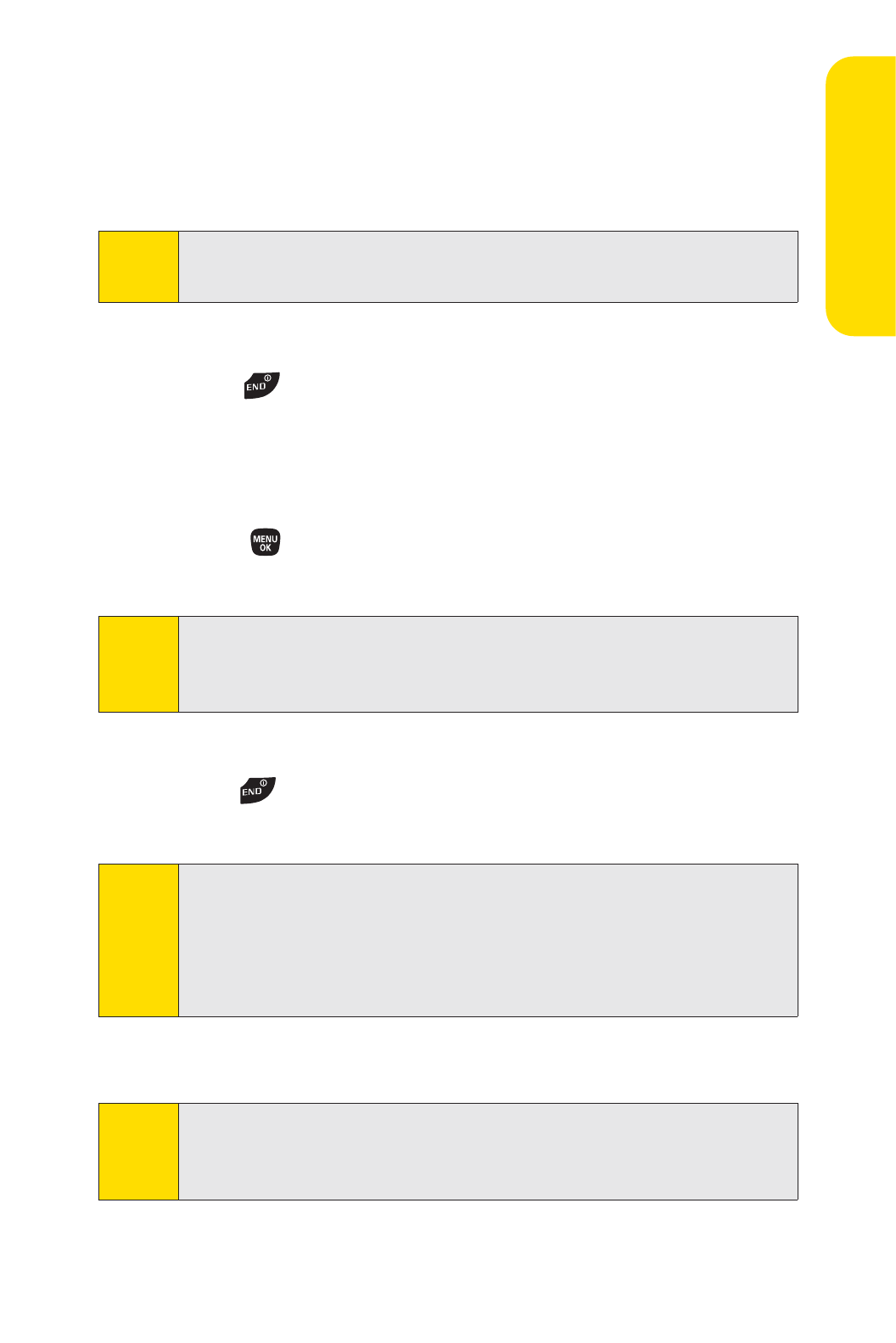
Setting Up Service
⽧If activation is still unsuccessful, please call
Sprint Customer Service at 1-800-SPRINT1
(1-800-777-4681) from another phone for
assistance.
Activating Your Phone If You Have Canceled the Activation
If you press while activating your phone, the activation will
be canceled and you will be required to activate it from the
main menu.
To activate your phone from the main menu:
1. Select > Settings > More… > Data > Update Profile.
2. Follow the onscreen instructions.
Unlocking Your Phone
1. Press to turn the phone on.
2. Press Unlock (left softkey).
3. Enter your four-digit lock code. (For security purposes,
the code is not visible as you type.)
Tip If you can’t recall your lock code, try using the last four digits
of your wireless phone number. If this doesn’t work, call Sprint
Customer Service at 1-800-SPRINT1 (1-800-777-4681).
Note To select a softkey, press the softkey button directly below the
softkey text that is displayed at the bottom left and bottom
right of your phone’s display screen. Softkey actions change
according to the screen you’re viewing and will not be
displayed if there is no corresponding action available.
Note: If the phone is not activated after having performed the steps
above, please call Sprint Customer Service at 1-800-SPRINT1
(1-800-777-4681).
Note: Do not press END while the phone is being activated.
Pressing END cancels the activation process.
Section 1A: Setting Up Service 5

Setting UpYour Voicemail
All unanswered calls to your phone are automatically
transferred to your voicemail, even if your phone is in use or
turned off. Therefore, you will want to set up your voicemail
and personal greeting as soon as your phone is activated.
1. From standby mode, press and hold .
2. Follow the system prompts to:
䡲Create your passcode.
䡲Record your name announcement.
䡲Record your greeting.
䡲Choose whether to activate One-Touch Message
Access (a feature that lets you access messages
simply by pressing and holding , bypassing the
need for you to enter your passcode).
For more information about using your voicemail, see “Using
Voicemail”on page 161.
Note Voicemail Passcode
If you are concerned about unauthorized access to your
voicemail account, Sprint recommends that you enable your
voicemail passcode (do not activate One-Touch Message
Access).
6 Section 1A: Setting Up Service

Setting Up Service
Sprint Account Passwords
As a Sprint customer, you enjoy unlimited access to your
personal account information, your voicemail account, and
your Sprint Power Vision account. To ensure that no one else
has access to your information, you will need to create
passwords to protect your privacy.
Account Password
If you are the account owner, you’ll have an account password
to sign on to www.sprint.com and to use when calling Sprint
Customer Service. If you are not the account owner (if
someone else receives the bill for your Sprint service), you can
get a sub-account password at www.sprint.com.
Voicemail Password
You’ll create your voicemail password (or passcode) when you
set up your voicemail. See “Setting Up Your Voicemail”on
page 6 for more information on your voicemail password.
Sprint Power Vision Password
With your Sprint Power Vision phone, you may elect to set up
an optional Sprint Power Vision password to control Vision
access and authorize Premium Services purchases.
For more information, or to change your passwords, sign
on to www.sprint.com or call Sprint Customer Service at
1-800-SPRINT1 (1-800-777-4681).
Section 1A: Setting Up Service 7

Getting Help
Visit www.sprint.com
You can go online to:
䢇Access your account information.
䢇Check your minutes used (depending on your Sprint
service plan).
䢇View and pay your bill.
䢇Enroll in Sprint online billing and automatic payment.
䢇Purchase accessories.
䢇Shop for the latest Sprint phones.
䢇View available Sprint service plans and options.
䢇Learn more about Sprint Power Vision and other great
products like Sprint Picture Mail, games, ringers, screen
savers, and more.
Reaching Sprint Customer Service
You can reach Sprint Customer Service many different ways:
䢇Dial on your phone.
䢇Sign on to your account at www.sprint.com.
䢇Call us toll-free at 1-800-SPRINT1 (1-800-777-4681)
(Consumer customers) or 1-800-927-2199 (Business
customers).
䢇Write to us at Sprint Customer Service, P.O. Box 8077,
London, KY 40742.
8 Section 1A: Setting Up Service

Setting Up Service
Receiving Automated Billing Information
Your phone lets you access billing information on your Sprint
account. This information includes balance due, payment
received, invoicing cycle, and an estimate of the number of
minutes used since your last invoicing cycle.
To access automated billing information:
䊳Press .
Sprint 411
Sprint 411 gives you access to a variety of services and
information through your phone, including residential,
business, and government listings; movie listings or
showtimes; driving directions, restaurant reservations, and
major local event information. You can get up to three pieces
of information per call, and the operator can automatically
connect your call at no additional charge.
There is a per-call charge to use Sprint 411, and you will be
billed for airtime.
To call Sprint 411:
䊳Press .
Note This service may not be available in all Affiliate areas.
Section 1A: Setting Up Service 9

10 Section 1A: Setting Up Service
Sprint Operator Services
Sprint Operator Services provides assistance when placing
collect calls or when placing calls billed to a local telephone
calling card or third party.
To access Sprint Operator Services:
䊳Press .
For more information or to see the latest in products and
services, visit us online at www.sprint.com.

Using Your Phone
Section 2

12 Section 2A: Phone Basics
Section 2A
Phone Basics
In This Section
⽧Your Phone (page 13)
⽧Viewing the Display Screen (page 17)
⽧Features of Your Phone (page 20)
⽧Turning Your Phone On and Off (page 22)
⽧Using Your Phone’s Battery and Charger (page 23)
⽧Using the Holster (page 26)
⽧Navigating Through Phone Menus (page 27)
⽧Displaying Your Phone Number (page 28)
⽧Entering Text(page 29)
⽧Using GPS Navigation (page 35)
Your phone is packed with features that simplify your life and
expand your ability to stay connected to the people and
information that are important to you.This section will guide
you through the basic functions and calling features of your
phone.
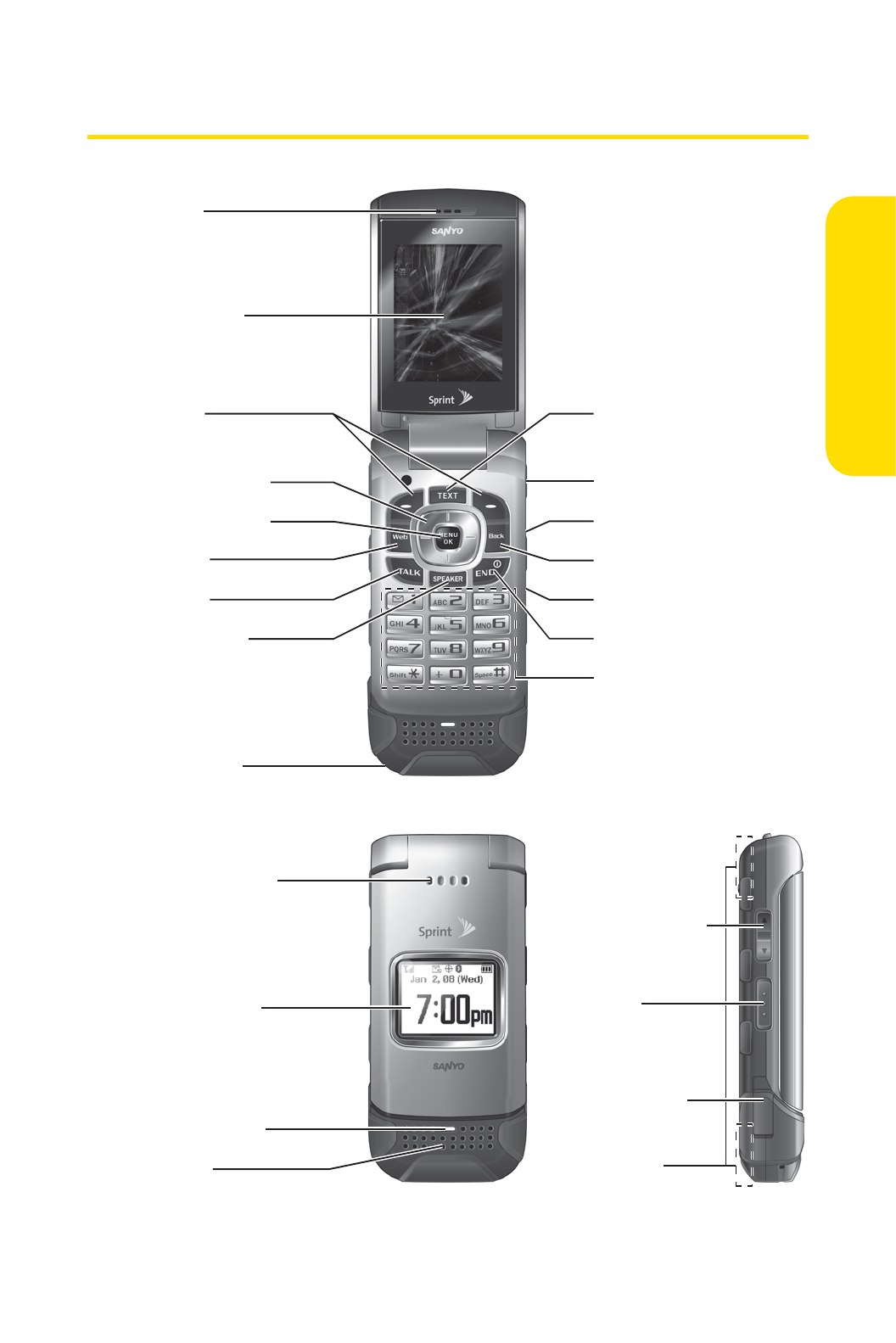
Section 2A: Phone Basics 13
Your Phone
15. Headset Jack
19. LED Indicator
4. Navigation Key
7. TALK Key
3. Softkeys
5. MENU/OK Key
2. Main Screen
1. Earpiece
17. Speakerphone
Microphone 21. Side Volume
Key
22. Direct
Connect Key
23. Micro-USB
Connector
24. Internal
Antenna
6. Web Key
8. SPEAKER Key
14. Side Call Key
13. Back Key
12. Side End Key
16. TEXT Key
20. Speaker
18. Outer Screen
9. Microphone
11. END/POWER Ke
y
10. Keypad
Phone Basics

14 Section 2A: Phone Basics
Key Functions
1. Earpiece lets you hear the caller and automated prompts.
2. Main Screen displays all the information needed to operate
your phone, such as the call status, the Contacts list, the
date and time, and the signal and battery strength.
3. Softkeys let you select softkey actions or menu items
corresponding to the bottom left and right lines on the
main screen.
4. Navigation Key scrolls through the phone’s menu options
and acts as a shortcut key from standby mode.
Default settings are:
Right: My Content, Left: Calendar,
Up: Messaging, Down: Direct Connect Call History
5. MENU/OK Key lets you access the phone’s menus and
select the highlighted choice when navigating through a
menu.
6. Web Key lets you access the Web browser.
7. TALK Key allows you to place or receive calls, answer Call
Waiting, use Three-Way Calling, or activate Voice Dial.
8. SPEAKER Key lets you turn the speakerphone on and off
during a call. You can also use it to answer the call in
speakerphone mode.
9. Microphone allows other callers to hear you clearly when
you are speaking to them. CAUTION! Make sure you do not
cover the microphone with your hand while talking.
10. Keypad lets you enter numbers, letters, and characters,
and navigate within menus. You can use the numeric
keypad for speed dialing. (See “Using Speed Dialing” on
page 49.)

Section 2A: Phone Basics 15
11. END/POWER Key lets you turn the phone on or off, end a
call, or return to standby mode. While in the main menu,
it returns the phone to standby mode and cancels your
input.
12. Side End Key ends a call while the phone is closed. This key
can also be used to display the recent call history when the
phone is closed.
13. Back Key deletes characters from the display in text entry
mode. When in a menu, pressing the Back key returns you
to the previous menu. This key also allows you to return to
the previous screen in a Sprint Power Vision session.
14. Side Call Key lets you place calls without opening the phone.
Press to make a voice dial or to redial with the phone closed.
15. Headset Jack allows you to plug in an optional headset for
convenient, hands-free conversations. CAUTION! Inserting
an accessory into the incorrect jack may damage the phone.
16. TEXT Key gives you quick access to the Send Text screen for
sending messages.
17. Speakerphone Microphone receives your voice input while
in speakerphone mode.
18. Outer Screen lets you monitor the phone’s status and see
who’s calling without opening the phone.
19. LED Indicator lets you show your phone’s connection and
charging status at a glance.
20. Speaker lets you hear the different ringers and sounds. You
can mute the ringer when receiving incoming calls by
pressing or any of the side keys. The speaker also lets
you hear the caller’s voice in speakerphone mode.
Phone Basics

16 Section 2A: Phone Basics
21. Side Volume Key allows you to adjust the ringer volume in
standby mode (with the phone open) or adjust the voice
volume during a call. The volume key can also be used to
scroll up or down to navigate through the different
menu options.
22. Direct Connect Key lets you make Direct Connect Calls.
(See “Making and Answering Direct Connect Calls”on
page 50.)
23. Micro-USB Connector allows you to connect a phone
charger or other accessories to your phone. CAUTION!
Inserting an accessory into the incorrect connector may
damage the phone.
24. Internal Antenna facilitates reception and transmission. To
maximize performance, do not obstruct while using the
phone. (See page 37.)
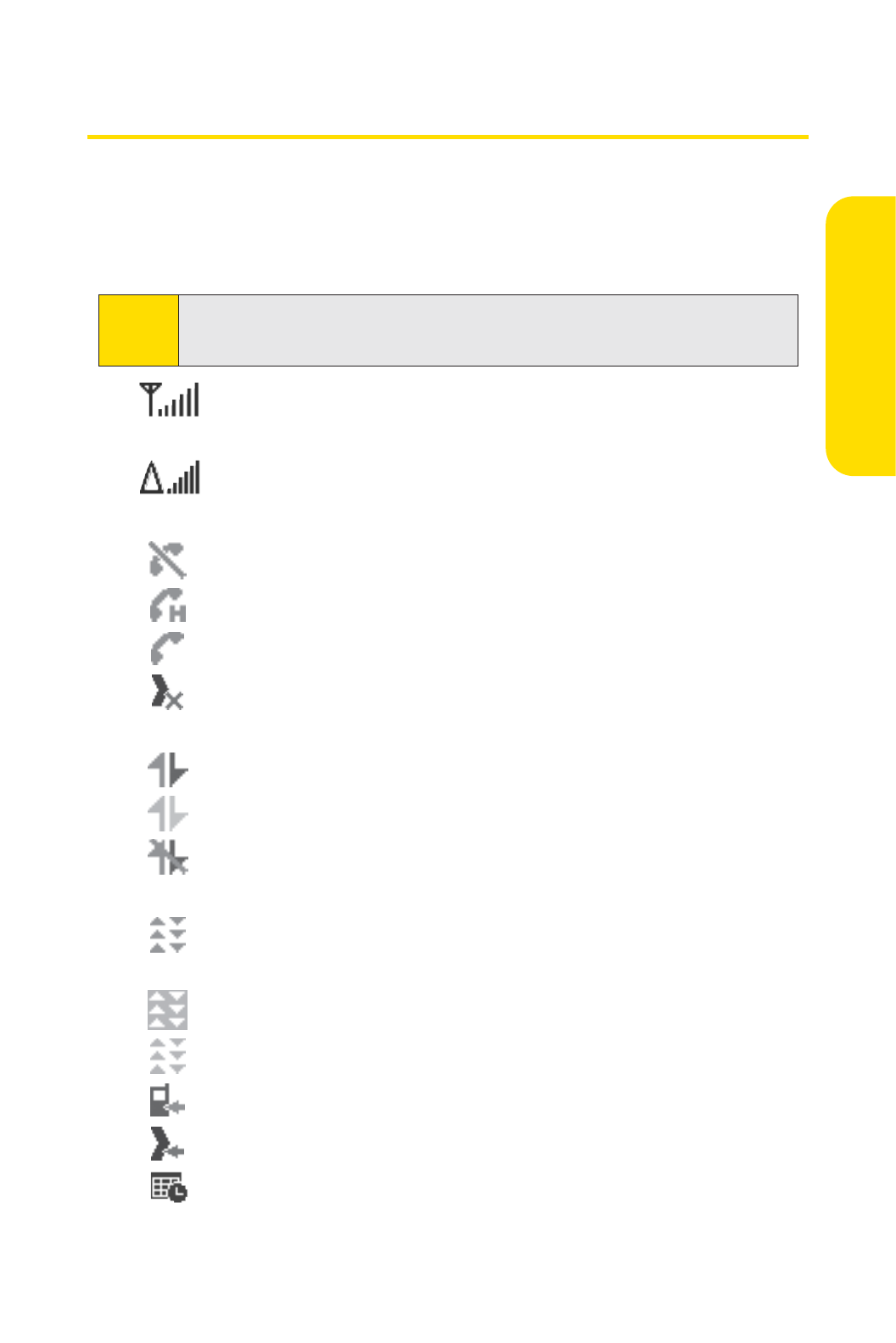
Section 2A: Phone Basics 17
Viewing the Display Screen
Your phone’s display screen provides information about your
phone’s status and options. This list identifies the symbols you’ll
see on your phone’s display screen:
indicates your current signal strength. (The more
lines you have, the stronger your signal.)
indicates you are “roaming”off the Sprint National
Network.
means your phone cannot find a signal.
means the call is on hold.
tells you a call is in progress.
indicates the Nextel Direct Connect service is
disabled.
indicates Sprint Vision access is active.
indicates Sprint Vision access is dormant.
indicates your phone is not currently able to access
SprintVision service features.
indicates Sprint Power Vision status. (The icon is
animated while service is active.)
indicates Sprint Power Vision service is available.
indicates Sprint Power Vision service is dormant.
indicates you have missed voice calls.
indicates you have missed Direct Connect calls.
indicates you have scheduled events or call alarms.
Tip To view a list of your phone’s icons and descriptions, from the
main menu select Settings > Phone Info > Icon Glossary.
Phone Basics

18 Section 2A: Phone Basics
indicates you have alarm clock or countdown
notifications.
indicates you have new SMS Voice messages.
indicates you have new SMS Text messages.
indicates you have new picture messages.
indicates you have new voicemail messages. (Press
and hold to call your voicemail box.)
indicates you have new email messages.
indicates you have alert messages from Java
applications activated in the background.
indicates you have urgent messages.
indicates you have two or more different types of
missed calls, scheduled events, call alarms, or alarm
clock or countdown notifications.
indicates you have a new Mobile Sync alert.
indicates the Bluetooth feature is enabled (blue icon).
indicates the handset is discoverable by another
Bluetooth device.
indicates the handset is connected to a Bluetooth
device (green icon).
indicates the handset is communicating with a
Bluetooth device.
indicates access to a secure site.
indicates the level of your battery charge. The more
black bars you see, the more power you have left.
(The icon is animated while the battery is charging.)
indicates your battery is charging in “Power Off”
state.

Section 2A: Phone Basics 19
indicates volume level 1 to 8 and vibrate feature are
set.
indicates 1-beep feature is set.
indicates 1-beep and vibrate feature are set.
indicates all ringer settings are off.
indicates all ringer settings are off and the vibrate
feature is set.
indicates all the sound settings except applications
volume are off and the vibrate feature is set.
indicates all the sound settings are off.
indicates the Location feature of your phone is
enabled.
indicates the Location feature of your phone is
disabled.
indicates you have a new voice message when Screen
Call is activated.
indicates the Screen Call Auto setting is on.
indicates your phone is operating in TTY mode.
indicates the alarm clock or countdown setting is on.
indicates Direct Connect speaker is set to on.
indicates Direct Connect speaker is set to off.
indicates the speakerphone mode is set to on.
indicates a call is in progress using the Bluetooth
device.
indicates the Car Kit device is set to on.
indicates the wired Headset device is set to on.
Phone Basics

20 Section 2A: Phone Basics
Features of Your Phone
The PRO-200 by SANYO is lightweight, easy to use, and
reliable, and it offers many features and service options.
This list previews some of those features and provides page
numbers where you can find out more:
䢇Digital dual-band capability allows you to make and
receive calls while on the Sprint National Network and to
roam on other 1900 and 800 MHz digital networks where
Sprint has implemented roaming agreements (page 95).
䢇SMS Text Messaging (page 169) and SMS Voice Messaging
(page 172) provide quick and convenient messaging
capabilities.
䢇SprintVoice Command lets you dial phone numbers by
speaking a name or a phone number (page 199).
䢇Your Contacts list allows you to store up to 600 entries,
with up to seven phone numbers per entry (page 112).
䢇The built-in Calendar offers several personal information
management features to help you manage your busy
lifestyle (page 130).
䢇The Location feature works in connection with available
location-based services (page 71).
䢇T9 Text Input lets you quickly type messages with one
keypress per letter (see page 31).
䢇Speed dial lets you dial phone numbers with one keypress
or two keypresses (see page 49).
䢇Games, ringers, screen savers, and other applications can
be downloaded to make your phone as unique as you are
(page 189). Additional charges may apply.

Section 2A: Phone Basics 21
䢇The built-in Bluetooth technology allows you to connect
wirelessly to a number of Bluetooth devices to share
information more easily than ever before (page 150).
䢇Nextel Direct Connect calling allows you to quickly
connect with co-workers, family and friends with just one
keypress anywhere on the network (page 50).
䢇Your phone allows you to run multiple applications
simultaneously (page 192).
䢇The built-in GPS Navigation feature lets you view your
approximate location and use available applications to
navigate roadways throughout the country (page 35).
Additional charges may apply.
Phone Basics

22 Section 2A: Phone Basics
Turning Your Phone On and Off
Turning Your Phone On
䊳Press .
Once your phone is on, it may display “Looking for service...,”
When your phone finds a signal, it automatically enters
standby mode – the phone’s idle state. At this point, you are
ready to begin making and receiving calls.
If your phone is unable to find a signal after five seconds of
searching, a Power Save feature is automatically activated.
When a signal is found, your phone automatically returns to
standby mode.
In Power Save mode, your phone searches for a signal
periodically without your intervention. You can also initiate a
search for Sprint service by pressing any key (when your
phone is turned on).
Turning Your Phone Off
䊳Press and hold for two seconds until you see the
powering down animation on the display screen.
Your screen remains blank while your phone is off (unless the
battery is charging).
Tip The Power Save feature conserves your battery power when
you are in an area where there is no signal.

Section 2A: Phone Basics 23
Using Your Phone’s Battery and Charger
Sprint-approved or SANYO-approved batteries and
accessories can be found at Sprint Stores or through SANYO;
or call 1-866-343-1114 to order. They’re also available at
www.sprint.com.
Battery Capacity
Your phone is equipped with a Lithium Ion (Li-Ion) battery.
It allows you to recharge your battery before it is fully drained.
The battery provides up to 4.9 hours of continuous digital
talk time.
When there are approximately two minutes of talk time left,
the phone sounds an audible alert and then turns off.
Tip Watch your phone’s battery level indicator and charge the
battery before it runs out of power.
Note Long backlight settings, searching for service, vibrate mode,
browser use, and other variables may reduce the battery’s talk
and standby times.
WARNING Use only Sprint-approved or SANYO-approved batteries
and chargers with your phone. The failure to use a
Sprint-approved or SANYO-approved battery and
charger may increase the risk that your phone will
overheat, catch fire, or explode, resulting in serious
bodily injury, death, or property damage.
Phone Basics
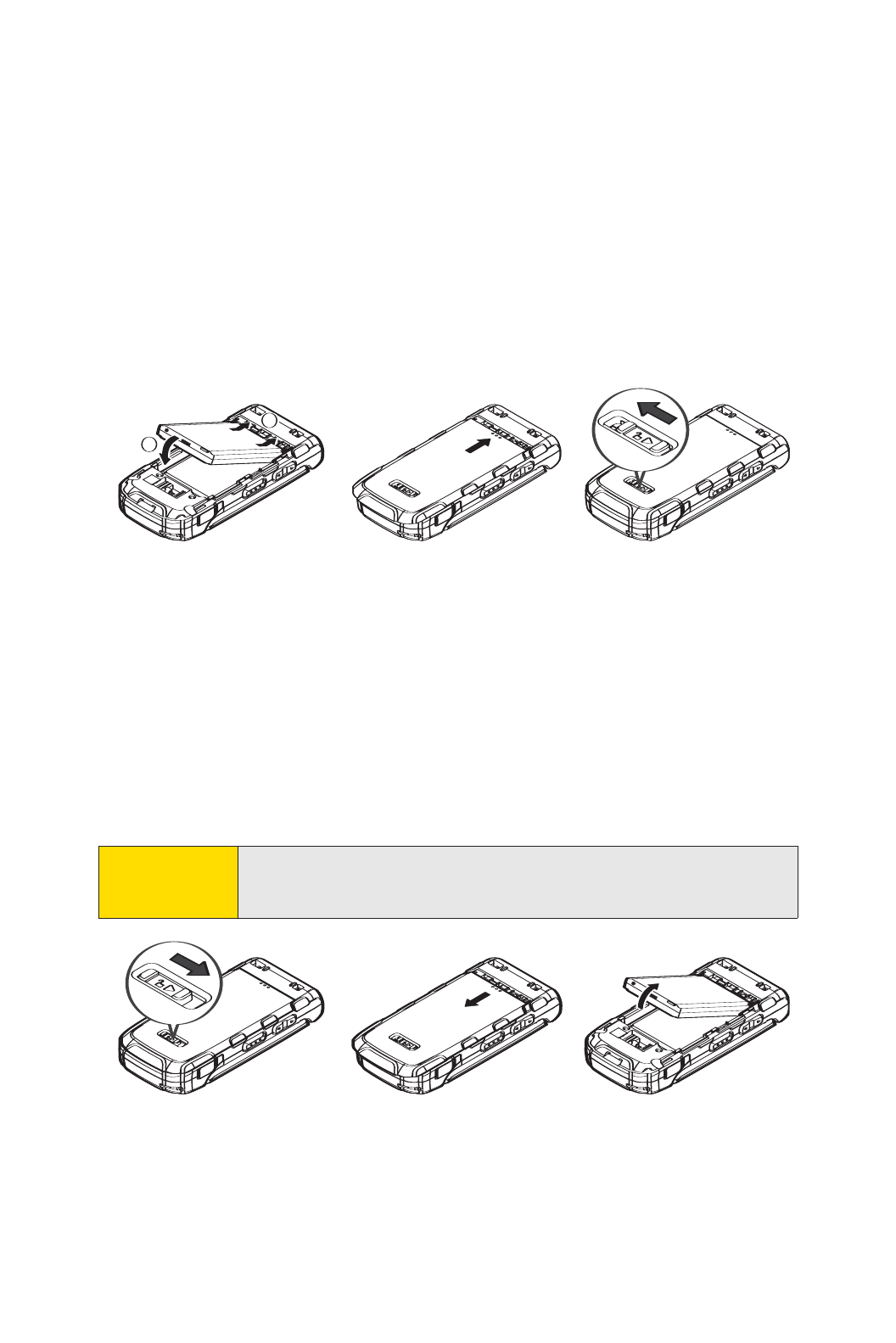
24 Section 2A: Phone Basics
Installing the Battery
1. Insert the battery into the opening, making sure the
connectors align. Gently press down to secure the battery.
2. Replace the battery cover and press up until you hear a
click.
3. Lock the battery cover by sliding the latch into its locked
position.
Removing the Battery
1. Make sure the power is off so that you don’t lose any
stored numbers or messages.
2. Slide the battery cover latch into its unlock position and
slide the battery cover downward to remove it.
3. Lift up the battery and remove it from the phone.
WARNING Do not handle a damaged or leaking Li-Ion battery as
you can be burned.
2
1

Section 2A: Phone Basics 25
Charging the Battery
Charge your battery as soon as possible so you can begin using
your phone.
Keeping track of your battery’s charge is important. If your
battery level becomes too low, your phone automatically
turns off, and you will lose any information you were just
working on. For a quick check of your battery level, glance at
the battery charge indicator located in the upper-right corner
of your phone’s display screen. If the battery charge is getting
too low, the battery icon ( ) appears and the phone displays
a warning message.
Always use a Sprint-approved or SANYO-approved desktop
charger, travel charger, or vehicle power adapter to charge
your battery.
Using the Phone Charger
1. Plug the phone charger into an electrical outlet.
2. Open the micro-USB connector cover located on the
lower left side of your phone.
3. Plug the other end of the phone charger into the micro
USB connector.
䡲Ared indicator light means the battery is charging.
䡲Agreen indicator light means the battery charging is
complete.
With the Sprint-approved Li-Ion battery, you can recharge the
battery before it becomes completely run down.
Phone Basics
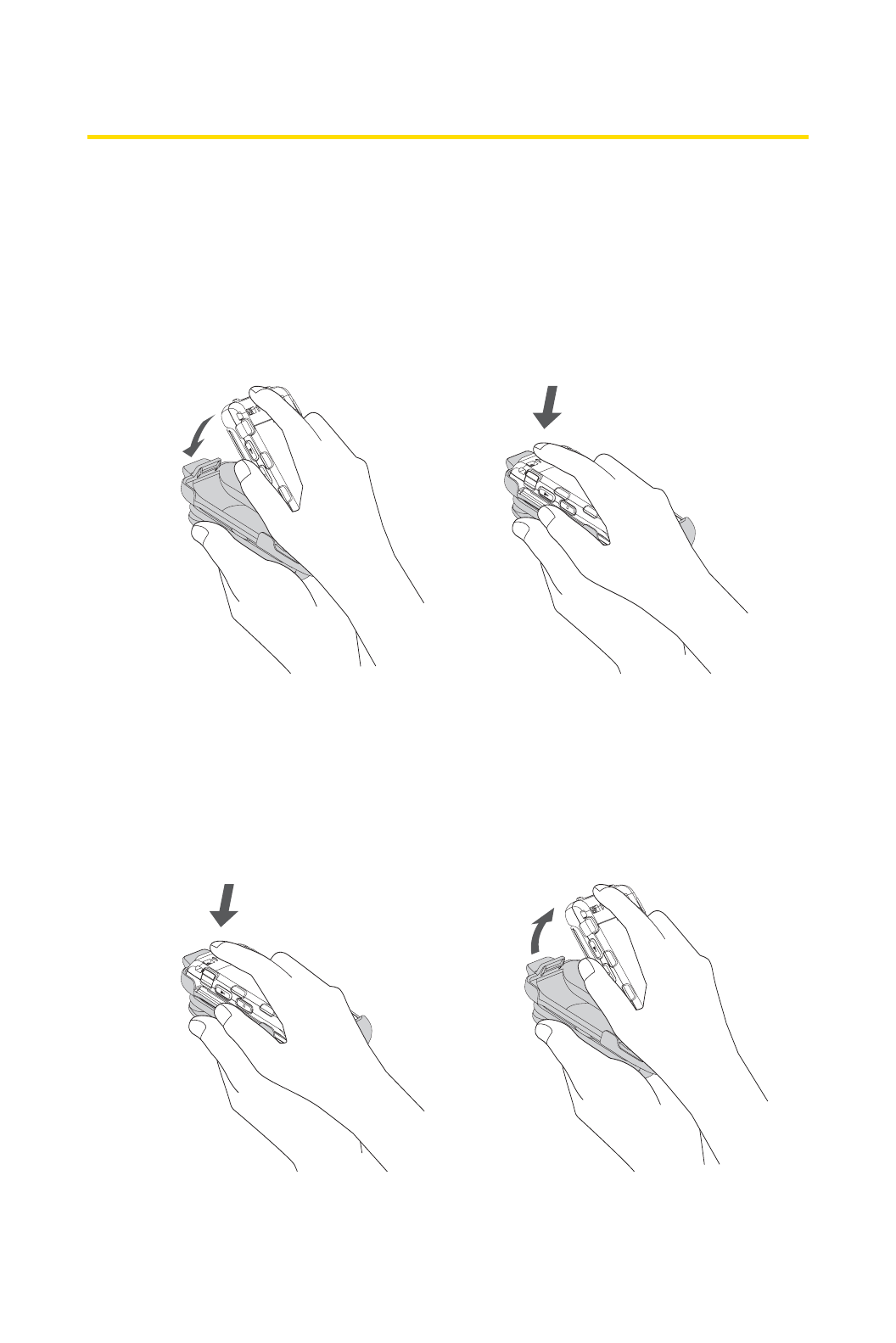
26 Section 2A: Phone Basics
Using the Holster
Attaching the phone to the holster
1. With the front of the phone facing the holster, insert the
bottom of the phone into the holster.
2. Press the phone down into the holster until it snaps into
place.
Removing the phone from the holster
1. With your forefinger, push against the holster’s top plate
while gripping the phone at the sides.
2. The phone can now be easily removed from the holster.

Section 2A: Phone Basics 27
Navigating Through Phone Menus
The navigation key on your phone lets you scroll through
menus quickly and easily. The scroll bar at the right of the
menu keeps track of your position in the menu at all times.
To navigate through a menu, press the navigation key up or
down. If you are in a first-level menu, such as Settings, you
may also navigate to the next or previous first-level menu by
pressing the navigation key right or left.
For a diagram of your phone’s menu, please see “Your Phone’s
Menu”on page iii.
Selecting Menu Items
As you navigate through the menu, menu options are
highlighted. In list view, select any numbered option by
pressing the corresponding number on the phone’s keypad.
You may also select any item by highlighting it and
pressing .
For example, if you want to display your volume settings:
1. Press to access the main menu.
2. Select Settings by pressing or by highlighting it and
pressing .
3. Select Sounds by pressing or by highlighting it and
pressing .
4. Select Volume by pressing or by highlighting it and
pressing .
5. Select Ringer by pressing or by highlighting it and
pressing .
Note For the purposes of this guide, the above steps condense into
“PressMENU > Settings > Sounds > Volume > Ringer.”
Phone Basics
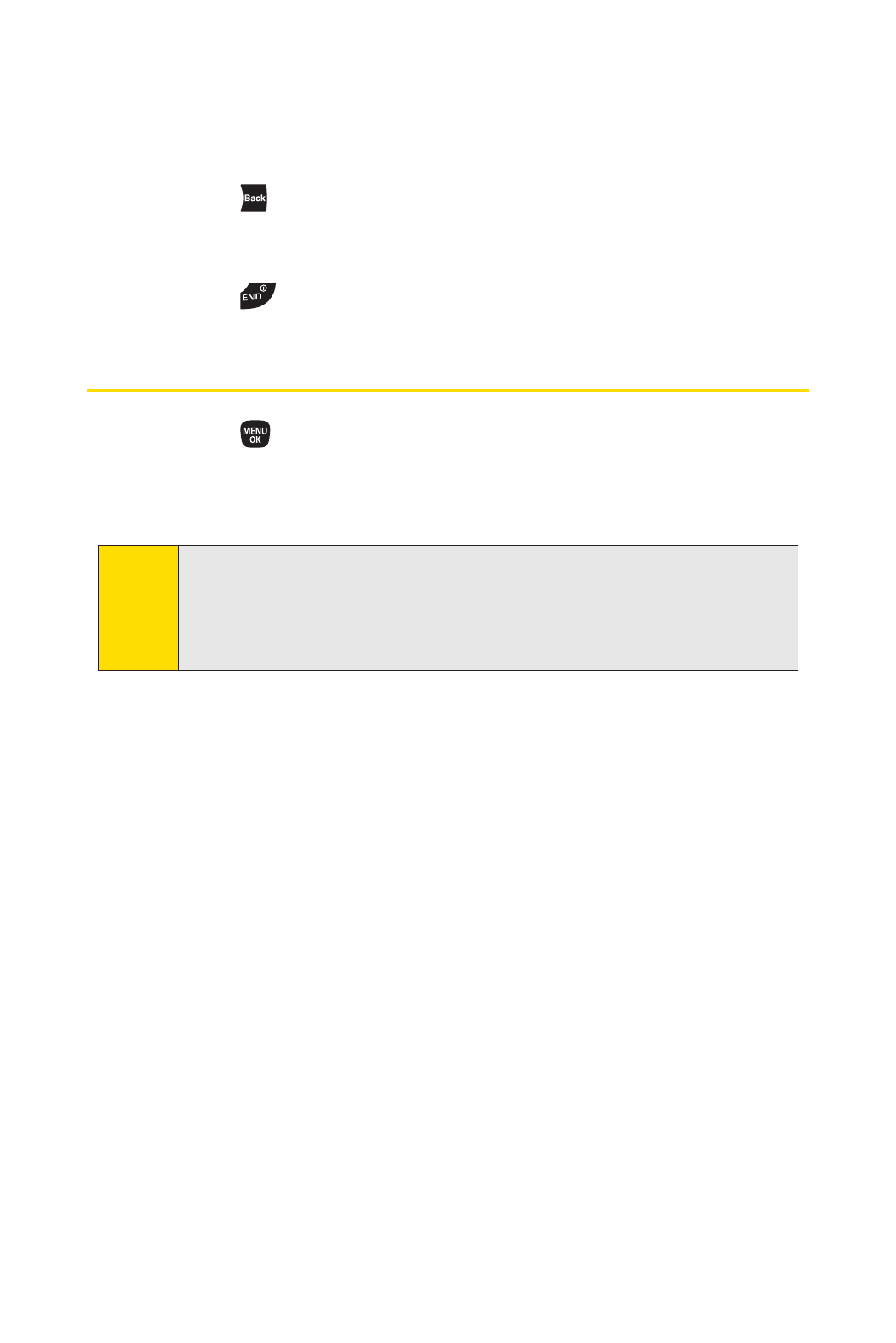
28 Section 2A: Phone Basics
Backing Up Within a Menu
To go to the previous menu:
䊳Press .
To return to standby mode:
䊳Press .
Displaying Your Phone Number
䊳Press > Settings > Phone Info > Phone#/User ID.
(Your phone number and other information about your
phone and account will be displayed.)
Tip You can also display your phone number through the
Contacts menu. Press MENU > Settings > More... > Contacts >
My Name Card.To send your contact information using
Bluetooth, press Options (right softkey) > Send Card.

Section 2A: Phone Basics 29
Entering Text
Selecting a Text Input Mode
Your phone provides convenient ways to enter words, letters,
punctuation, and numbers whenever you are prompted to
enter text (for example, when adding a Contacts entry or
when using Sprint Mail and SMS Text Messaging).
1. From a screen where you can enter text, press the right
softkey to change the text input mode.
2. Select one of the following options:
䡲T9 Word to enter text using a predictive text system
that reduces the number of keypresses required
while entering a word. (See page 31.)
䡲Alphabet to enter characters by using the Alphabet
mode. (See page 33.)
䡲SYMBOL to enter symbols. (See page 34.)
䡲SMILEYS to enter smile icons. (See page 34.)
䡲Emoticons to enter “emoticons.”(See page 34.)
䡲Web Shortcuts to enter Web shortcuts (for example,
www., http://, or .com).
䡲Preset Messages to enter preset messages.
(See page 34.)
䡲Recent Messages to enter messages used recently.
䡲Paste List to paste copied or cut text (if applicable).
䡲Fr. Schedule List to extract the schedule items you
have added to your Calendar. (See page 130.)
Note The menus displayed vary according to the entry field. If you
see triangles on the right of the menu, you can press the right
and left navigation keys to switch between related menus.
Phone Basics

30 Section 2A: Phone Basics
䡲From To Do List to extract the To Do items you have
added to your Calendar. (See page 134.)
䡲NUMBER to enter numbers.
䡲Signature to enter your signature. (See page 73.)
䡲Select Language to select the language (English or
Spanish).
䡲Delete All to delete all text (if applicable).
䡲SelectText to select stored text for copying or cutting
(if applicable).
䡲Add Word to store words that you frequently use.
(See page 31.)
䡲Text Options to display the Text Entry settings menu.
(See page 34.)
Tip When entering text, press the *(Shift) key to change letter
capitalization (ABC > abc > Abc).

Section 2A: Phone Basics 31
Entering Characters Using T9 Text Input
T9 Text Input lets you enter text by pressing keys just once per
letter. (To select the T9 Word mode when entering text, see
“Selecting a Text Input Mode”on page 29.)
T9 Text Input uses an intuitive word database to analyze the
letters you enter and create a suitable word. (The word may
change as you type.)
1. Select the T9 Word text input mode. (See “Selecting a
Text Input Mode”on page 29.)
2. Press the corresponding keys once per letter to enter
a word. (For example, to enter the word “Bill,”press
.) (If you make a mistake, press to
erase a single character. Press and hold to erase an
entire word.)
3. To accept a word and insert a space, press .
Adding a Word to the T9 Database
If a word you want to enter is not displayed as an option when
you are using T9 Text Input, add it to the database.
1. Select the Add Word text input mode. (See “Selecting a
Text Input Mode”on page 29.)
2. Enter the word using Alphabet Mode and press Save (left
softkey). (See “Entering Characters Using Alphabet
Mode”on page 33.) The word will appear as an option
the next time you scroll through options during T9 Text
Input.
Phone Basics

32 Section 2A: Phone Basics
To edit or delete the words you have added:
1. Press > Settings > Text Entry > My Words.
2. Select a word and press Options (right softkey).
3. To select an option, highlight it and press .
䡲Edit to edit a word in My Words.
䡲Delete to delete a word in My Words.
Customizing the T9 Settings
1. Press > Settings > Text Entry > T9 Settings.
2. Select an option and press .
䡲Next WordPrediction to automatically display the
word that may follow the current text input.
䡲WordCompletion to show the completed words that
match the keys you have entered without entering
the whole word.
䡲Word Scan to allow T9 text input to recognize words
by searching Contacts entries and messages.
䡲Word Choice List to display the word choice list.
䡲Show after enter to select when (after 1-3 digits) to
display the word choice list.The word choice list will
be displayed based on the number of digits you
selected.
䡲Show after wait to select how many seconds the
phone should wait to display the word choice list.
For more information about T9 Text Input, visit the Nuance
Web site at www.nuance.com/t9/textinput/.
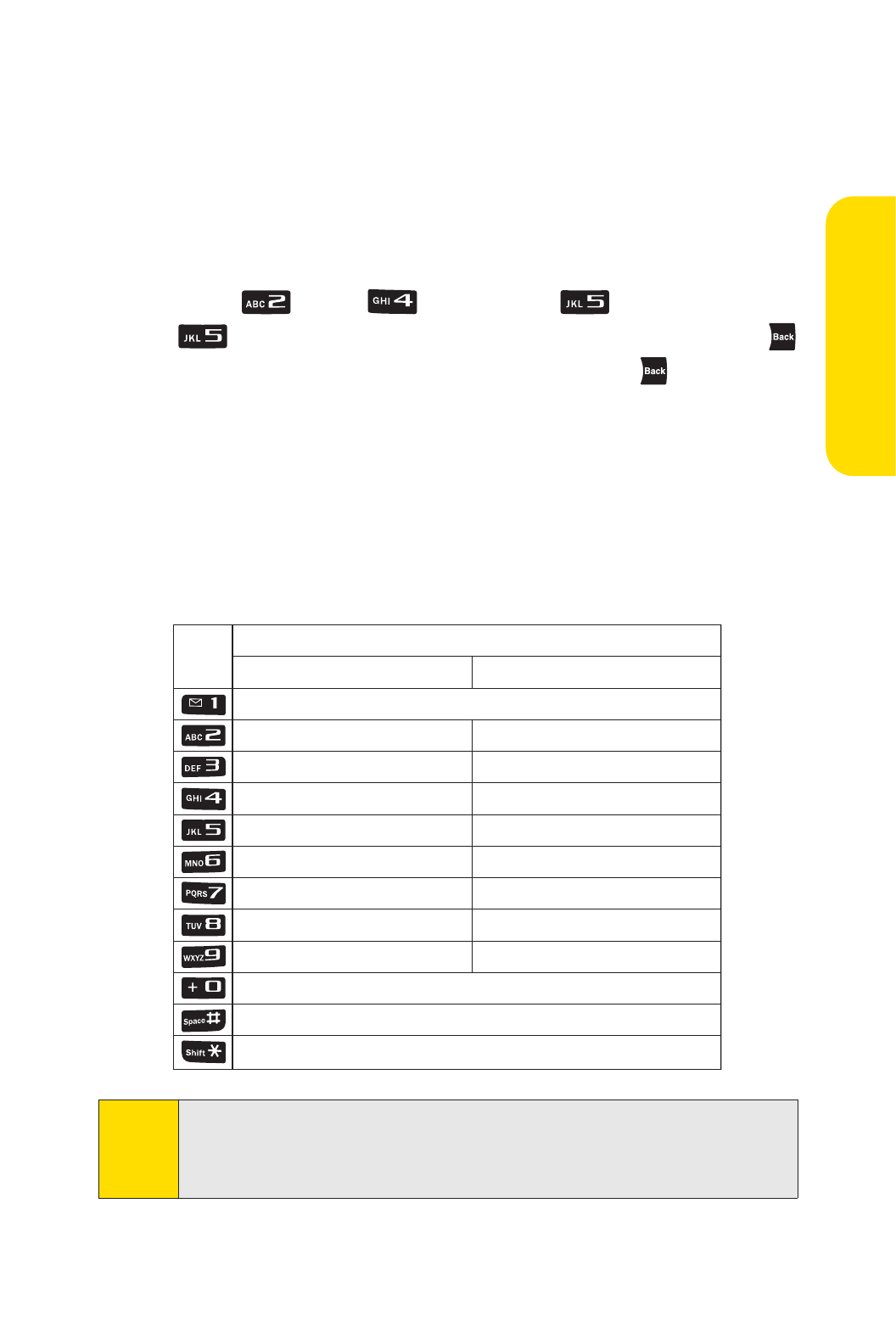
Section 2A: Phone Basics 33
Entering Characters Using Alphabet Mode
1. Select the Alphabet mode. (See “Selecting a Text Input
Mode”on page 29.)
2. Press the corresponding keys repeatedly until the correct
letter appears. (For example, to enter the word “Bill,”
press twice, three times, three times, and
three times again.) (If you make a mistake, press
to erase a single character. Press and hold to erase an
entire word.)
By default, the first letter of an entry is capitalized and the
following letters are lowercased. After a character is entered,
the cursor automatically advances to the next space after two
seconds or when you enter a character on a different key.
Characters scroll in the following order:
Tip The initial letters of words following spaces can be either
upper- or lowercase depending on shift mode. You can change
the shift mode by pressing *(Shift).
English Sequence
Upper Case
Key
.,@1?!
*
#/
ABC2
DEF3
GHI4
JKL5
MNO6
PQRS7
TUV8
WXYZ9
abc2
def3
ghi4
jkl5
mno6
pqrs7
tuv8
wxyz9
0
Space
One-character- shifted Caps Lock Unshifted
Lower Case
Phone Basics
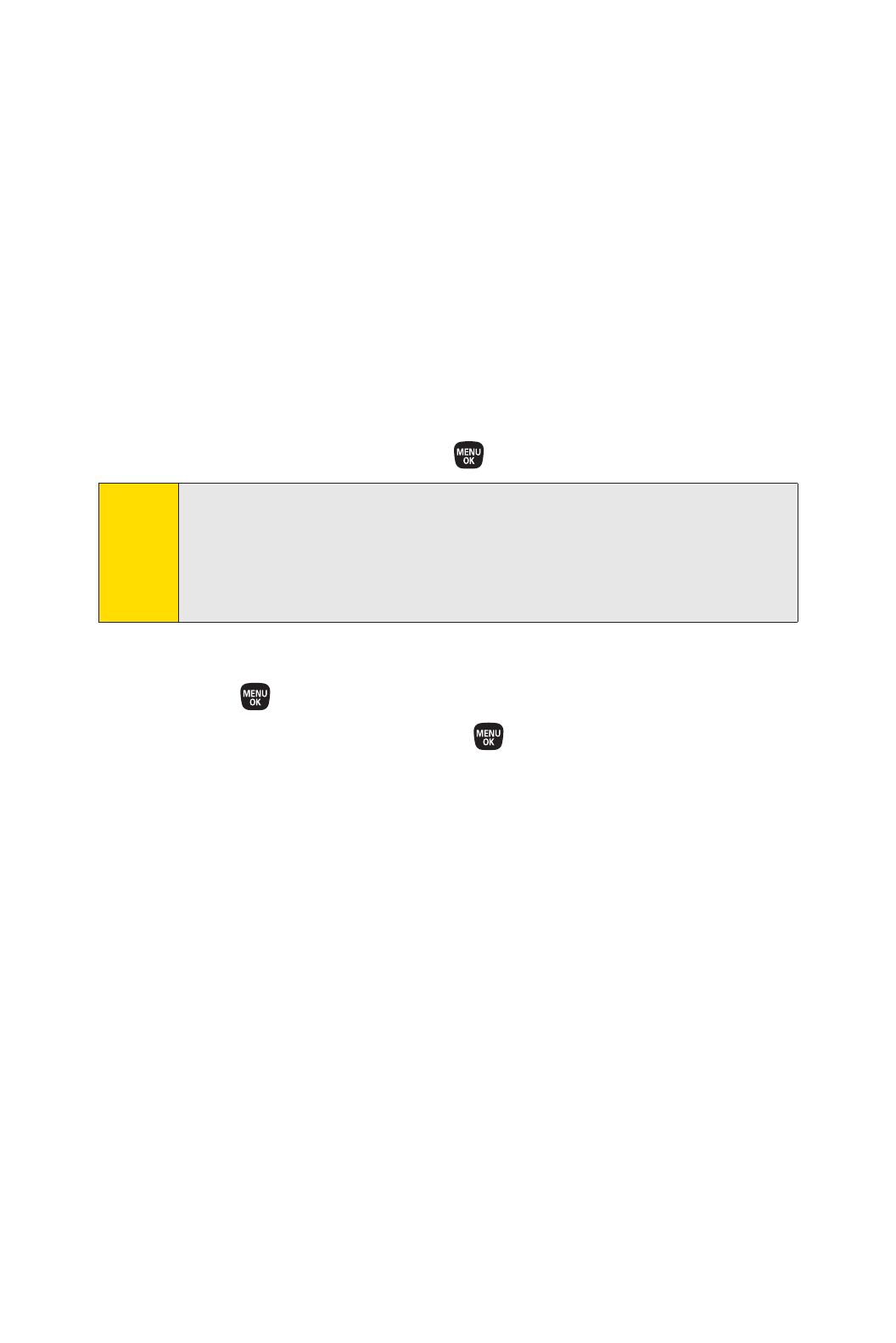
34 Section 2A: Phone Basics
Entering Symbols, Smileys, Emoticons, and
Preset Messages
Alternate text entry methods can help speed your messaging
and Web browsing. These methods, including SYMBOL,
SMILEYS, Emoticons, or Preset Messages are all accessed the
same way.
1. Select a text entry method (such as SYMBOL,SMILEYS,
Emoticons, or Preset Messages). (See “Selecting a Text
Input Mode”on page 29.)
2. Use your keypad or navigation key to select the desired
text or symbol and press .
Setting Text Entry Options
1. Press > Settings > Text Entry.
2. Select an option and press .
䡲Auto-Capital to turn auto-capitalization on or off.
䡲Auto-Space to turn auto-spacing on or off after T9
words you enter.
䡲Input Language to select the language (English or
Spanish).
䡲My Words to add or edit a word in the T9 database
(see page 32).
䡲T9 Settings to customize the T9 settings (see page 32).
䡲Default Input to selectT9 word, Alphabet, or Retain
Mode for the initial entry mode.
䡲Add Word to store words that you use frequently
(see page 31).
䡲Auto-Complete to automatically display words that
may follow the current text input.
䡲Help to see the T9 instructions page.
Note Preset messages make composing text messages easier by
allowing you to enter quick messages, such as “Meet me at,”
“Let’s get lunch,”or a customized message of your own. (For
more information on preset messages, please see “Managing
Preset Messages”on page 75.)
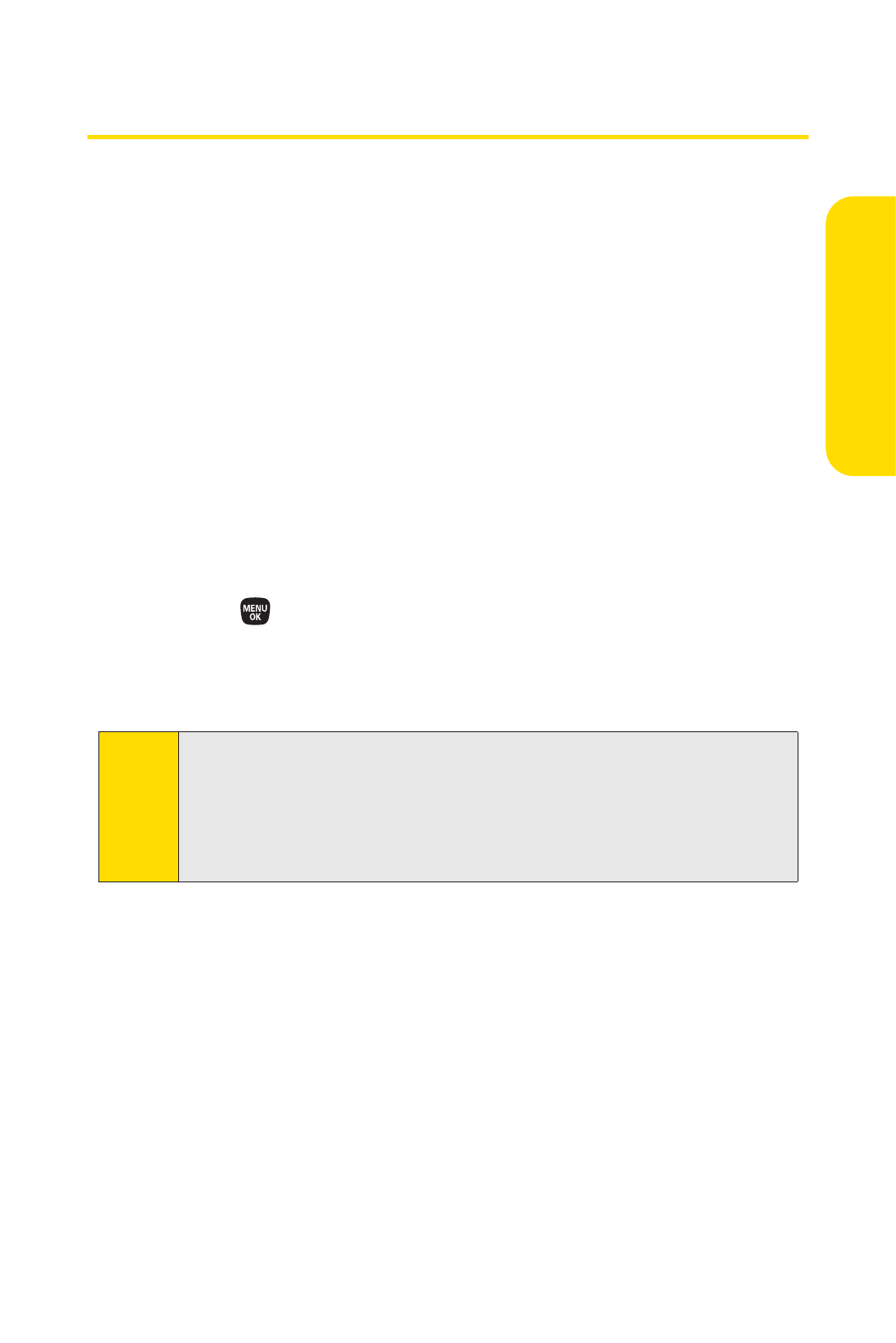
Section 2A: Phone Basics 35
Using GPS Navigation
Your phone comes with built-in GPS navigation.
This feature provides audible and visual driving directions
with full-color moving maps, including voice entry of
destinations, traffic alerts in major cities, a low-price gas
finder, and more. You can view your approximate location and
use available applications to navigate roadways throughout
the country.
Activating GPS Navigation
You can access GPS navigation right from your phone’s main
menu, anywhere on the Sprint network.
To activate GPS Navigation application:
1. Press > Navigation. (The GPS navigation application
launches and displays the main menu.)
2. Follow the onscreen instructions.
Note TeleNavTM Unlimited is an optional service that gives you
audible and visual turn-by-turn driving instructions from your
phone. It requires a data plan and will incur a monthly
subscription fee. Please contact Sprint Customer Service for
more details.
Phone Basics

36 Section 2B: Making and Answering Calls
Section 2B
Making and Answering Calls
In This Section
⽧Making and Answering Calls (page 37)
⽧Using Nextel Direct Connect (page 50 )
⽧Making and Answering Direct Connect Calls (page 50)
⽧Using Team DC (page 56)
Your PRO-200 by SANYO offers many different ways to connect
to your friends, family and co-workers. In addition to digital
cellular phone calls, you can make Nextel Direct Connect®
calls to both individuals and groups, and send Call Alerts.
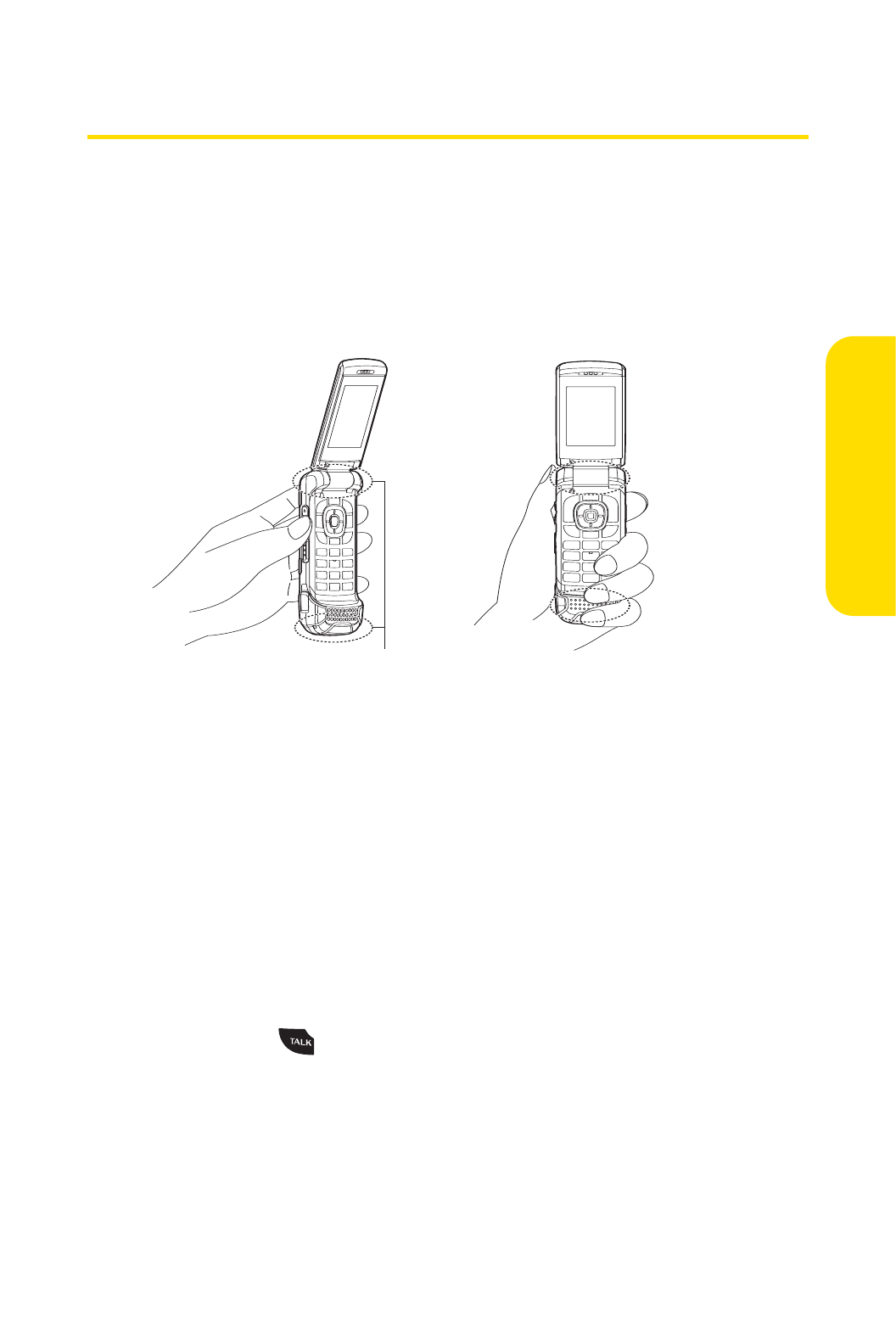
Section 2B: Making and Answering Calls 37
Making and Answering Calls
Holding Your Phone
To maximize performance, do not obstruct the internal
antenna area. Also make sure you do not cover the
microphone with your hand while talking.
Types of Calls
Your phone offers two types of calls : digital cellular phone
calls and Direct Connect calls. With Direct Connect calls, you
can instantly connect with individuals and groups with just
one keypress.
Making Phone Calls
Placing a normal phone call from your wireless phone is as
easy as making a call from any landline phone. Enter the
number, press , and you’re on your way to clear calls.
Internal Antenna
Correct Incorrect
Making Calls

38 Section 2B: Making and Answering Calls
To make a call using your keypad:
1. Make sure your phone is on.
2. Enter a phone number from standby mode. (If you
make a mistake while dialing, press to erase the
numbers.)
3. Press . (To make a call when you are roaming
and Call Guard is enabled, see “Using Call Guard”on
page 99.)
4. Press or close the phone when you are finished.
To place a call with the phone closed:
1. Make sure your phone is on and the Side Key Guard
feature is disabled. (See “Setting the Side Key Guard”on
page 83.)
2. Press and hold on the right side of the phone.
3. Follow the system prompts. (The call will be made in
speakerphone mode unless you have a headset
attached to the phone.)
䡲Say the name of your registered Voice Dial entry.
(See “Using Voice-Activated Dialing”on page 142.)
Tip You can redial your most recent call using the Recent Calls list.
With the phone closed, press the side end key to display the
list and select the entry you want to call. Press the side call key
to make a call.
To redial your most recent call (outgoing, incoming, or
missed), press TALK twice.
When making calls off the Sprint National Network, always
dial using 11 digits (1 + area code + phone number).

Section 2B: Making and Answering Calls 39
You can also place calls from your phone by using Sprint Voice
Command (page 199), speed dialing numbers from your
Contacts (page 49), and using your History listings (page 107).
Dialing Options
When you enter numbers in standby mode, you will see a
variety of dialing options by pressing Options (right softkey).
To initiate an option, highlight it and press .
䢇Abbrev. Dial: Place call using the abbreviated dialing
feature. (See “Using Abbreviated Dialing”on page 47.)
䢇Call: Dial the phone number.
䢇Call:Speaker On: Dial the phone number in speakerphone
mode.
䢇Set DC Domain: To set the Direct Connect domain name.
(See “Setting a Domain Name”on page 117.)
䢇Save Phone#: Save the phone number in your Contacts.
(See “Saving a Phone Number”on page 45.)
䢇Go to Contacts: Display your Contacts list (if available).
䢇Find: Display Contacts entries that end with the digits you
entered. (See “Finding a Phone Number”on page 46.)
䢇HardPause: Insert a hard pause. (See “Dialing and Saving
Phone Numbers With Pauses”on page 46.)
䢇2-Sec. Pause: Insert a two-second pause. (See “Dialing and
Saving Phone Numbers With Pauses”on page 46.)
䢇Hyphen: Insert a hyphen. (Hyphens are generally for visual
appeal only; they are not necessary when entering
numbers.)
Making Calls

40 Section 2B: Making and Answering Calls
Answering Phone Calls
To answer an incoming call with the phone open:
1. Make sure your phone is on. (If your phone is off,
incoming calls go to voicemail.)
2. Press to answer an incoming call.(Depending on
your settings, you may also answer incoming calls by
opening the phone or by pressing any number key.
See “Call Answer Mode”on page 81.)
To answer an incoming call with the phone closed:
1. Make sure your phone is on. (If your phone is off,
incoming calls go to voicemail.)
2. When your phone rings or vibrates, press the side call key
( ) on the right side of the phone. (The call will be
answered in speakerphone mode.)
– or –
Open the phone to use the earpiece.
Your phone notifies you of incoming calls in the following
ways:
䢇The phone rings or vibrates.
䢇The indicator light flashes.
䢇The backlight illuminates.
䢇The screen displays an incoming call message.
If the incoming call is from a number stored in your Contacts,
the entry’s name is displayed. The caller’s phone number may
also be displayed, if available.

Section 2B: Making and Answering Calls 41
When receiving a call, the following options are also displayed
by pressing Options (right softkey).
䢇Call Guard to answer the call when you are in roaming
mode. (See “Using Call Guard”on page 99.)
䢇Answer or Answer:Speaker to answer the call.
䢇Select Audio to switch the call to a device (if available).
䢇Answer on Hold to put the call on hold.
䢇Screen Call to answer the call by using a prerecorded
announcement. (See “Setting Up Screen Call”on
page 147.)
䢇Quiet Ringer to mute the ringer (if available).
䢇Ignore with Text to ignore the call and send a text message
to the caller (if available).
Answering a Roam Call With Call Guard Enabled
Call Guard is an option that helps you manage your roaming
charges when making or receiving calls while outside the
Sprint National Network. Please see “Controlling Your
Roaming Experience”on page 95 for more information about
roaming.
䊳To answer the call, press , and then press to
proceed while the pop-up message is displayed.
(See “Using Call Guard”on page 99 for additional
information.)
Ending a Call
䊳Close the phone or press .
Tip When the phone is closed, you can end a call by pressing the
side end key.
Note When your phone is off, calls go directly to voicemail.
Making Calls

42 Section 2B: Making and Answering Calls
Missed Call Notification
When an incoming call is not answered, the Missed Call log is
displayed on your screen.
To display the Missed Call entry from the notification screen:
䊳Select the entry and press . (Select an option to
continue.)
To display a Missed Call entry from standby mode:
1. Press > Missed Alerts.
2. Select the entry you wish to view and press .
Calling Emergency Numbers
You can place calls to 911 (dial ), even if your
phone is locked or your account is restricted.
During an emergency call, press Options (right softkey) to
display your options. Select an option and press .
䢇Speaker On to activate speakerphone mode. (If you are in
speakerphone mode, the option is displayed as Speaker Off
to deactivate.)
䢇Unlock My Phone to unlock your phone (appears only if the
phone is locked).
䢇Close Menu to close the pop-up menu (appears only if the
phone is unlocked).
Tip Press My Phone (left softkey) to display your phone number
during an emergency call.
Note When you place an emergency call, your phone automatically
enters Emergency mode.
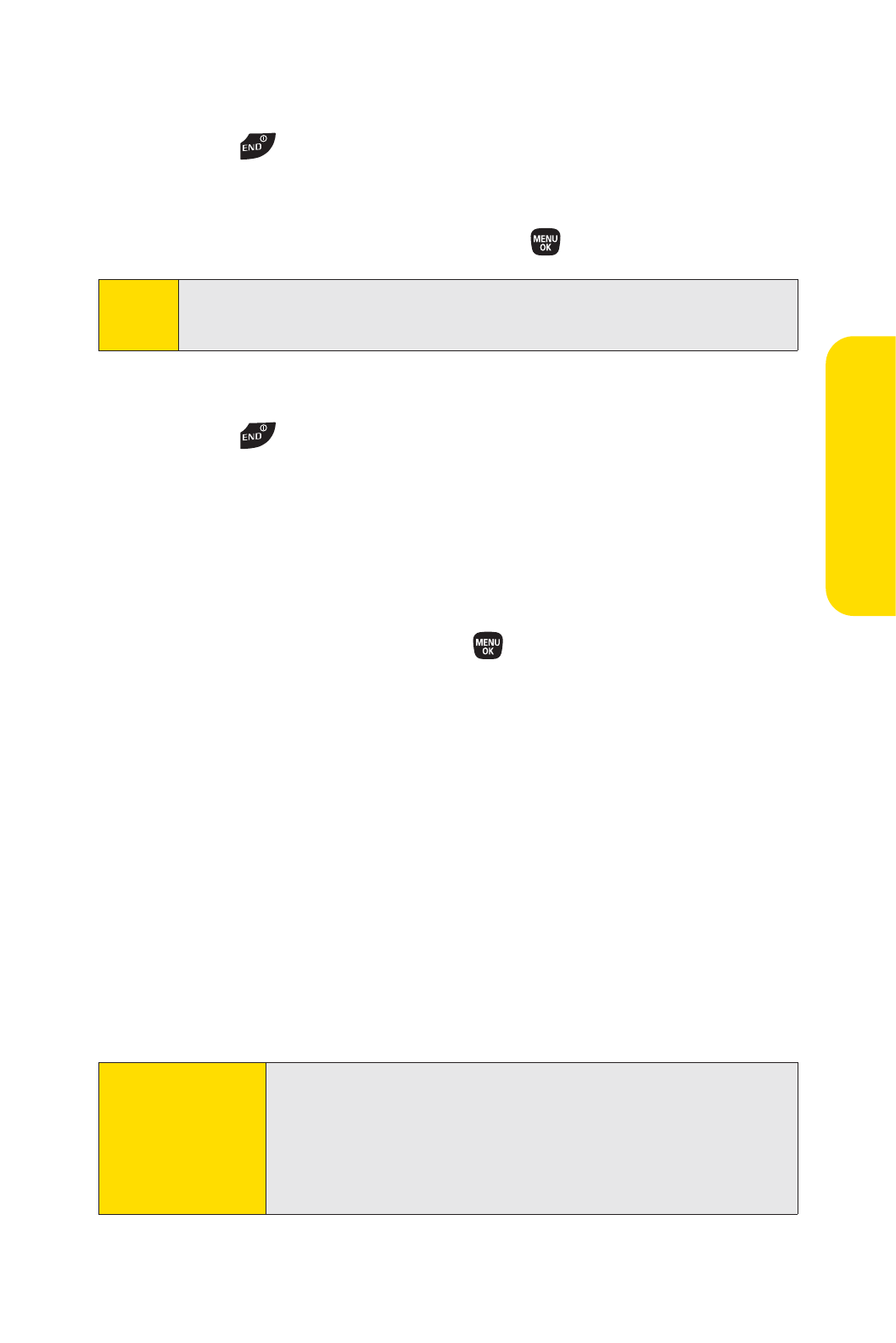
Section 2B: Making and Answering Calls 43
To exit Emergency mode:
1. Press to end a 911 call.
2. Press Options (right softkey) to display the options menu.
3. Select Exit Emergency and press .
To select Emergency mode options:
1. Press to end a 911 call.
2. Press Options (right softkey).
䡲Call 911 to call 911.
䡲Call 911:Speaker to call 911 in speakerphone mode.
䡲Exit Emergency to exit Emergency mode.
3. Select an option and press .
Enhanced 911 (E911) Information
This phone features an embedded Global Positioning System
(GPS) chip necessary for utilizing E911 emergency location
services where available.
When you place an emergency 911 call, the GPS feature of
your phone seeks information to calculate your approximate
location. Depending on several variables, including
availability and access to satellite signals, it may take up to
30 seconds or more to determine and report your
approximate location.
IMPORTANT Always report your location to the 911 operator when
placing an emergency call. Some designated
emergency call takers, known as Public Safety
Answering Points (PSAPs) may not be equipped to
receive GPS location information from your phone.
Note When you are in Emergency mode, you can exit only from the
options menu.
Making Calls

44 Section 2B: Making and Answering Calls
In-Call Options
Pressing Options (right softkey) during a call displays a list of
available in-call features. To select an option, press the
corresponding keypad number or select the option and
press . The following options may be available through the
Options menu:
䢇Transfer Audio to switch the call to an external device
(if applicable).
䢇Three-Way Call to call a third party.
䢇Main Menu to display the phone’s main menu.
䢇Save Phone# to save the phone number in your Contacts.
䢇Go to Contacts to display your Contacts list (if available).
䢇Call Memo Rec. to record the phone’s conversation.
䢇Phone Info to access the Phone Info menu.
During a call, the left softkey and the side call key ( )
function as the Mute button. Press and hold either to mute
the phone’s microphone for privacy. Press and hold either one
again to Unmute the phone.
Note You can turn the speakerphone on or off by pressing the
SPEAKER key during a phone call.
Because of higher volume levels, do not place the phone near
your ear during speakerphone use.

Section 2B: Making and Answering Calls 45
End-of-Call Options
Once you have finished your call, the phone will display the
Recent History. From the Recent History, you can view the date
and time of the call, the phone number (if available), the entry
name (if the number is already in your Contacts), and the
duration of the call.
䢇Press Options (right softkey) to display the Recent History
options. (See “History Menu Options”on page 106 for
details.)
䢇Press Msg/Alert (left softkey) to send a text or VoiceSMS
message, or a Call Alert to the entry in a Recent History.
Saving a Phone Number
Your phone can store up to 600 Contacts entries. Contacts can
store up to a total of 700 phone numbers. Each entry’s name
can contain 64 characters. Your phone automatically sorts the
Contacts entries alphabetically. (For more information, see
“Using Contacts”on page 111.)
To save a number from standby mode:
1. Enter a phone number and press Options(right softkey) >
Save Phone#.
2. Select New Entry or Existing Entry and press .
3. If New Entry was selected, select a phone type, and then
use the numeric keypad to enter the new entry name
and press .
– or –
If Existing Entry was selected, select an existing entry to
which you want to save the number, and then select a
phone type and press .
4. Press Done (left softkey) to save the entry.
Making Calls

46 Section 2B: Making and Answering Calls
Finding a Phone Number
You can search Contacts entries for phone numbers that
contain a specific string of numbers.
1. Enter the last four or more digits of the number in
standby mode. (The more numbers you enter, the more
specific the search becomes.)
2. Press Options (right softkey)> Find. (All Contacts entries
matching the entered numbers will be displayed.)
3. To display the Contacts entry that contains the phone
number you entered, select the entry and press .
To dial the number, press .
Dialing and Saving Phone Numbers With Pauses
You can dial or save phone numbers with pauses for use with
automated systems, such as voicemail or credit card billing
numbers.
There are two types of pauses available on your phone:
䢇Hard Pause sends the next set of numbers when you
press .
䢇2-Sec. Pause automatically sends the next set of numbers
after two seconds.
To dial or save phone numbers with pauses:
1. Enter the phone number.
2. Press Options (right softkey) > Hard Pause or 2-Sec. Pause.
3. Enter additional numbers.
Note You can have multiple pauses in a phone number and
combine two-second and hard pauses.

Section 2B: Making and Answering Calls 47
4. Press to dial the number.
– or –
Press Options (right softkey) > Save Phone# to save the
number in your Contacts.
Using Abbreviated Dialing
Abbreviated Dialing is similar to speed dialing. You can use
either of the following abbreviated dialing features.
䢇Contacts Match – Retrieve any number saved in your
Contacts by entering only the last three to six digits of the
number. Press to dial the retrieved number. (See “To
activate the Contacts Match feature”on page 83.)
䢇Prepend –P
repend the first five or six digits (for example,
the area code and prefix) to any four or five digits you enter.
Pres
s
to dial the resulting number. (See page 83 to
register a prepend number and activate the Prepend
feature.)
To place a call using Contacts Match Abbreviated Dialing:
1. Enter the last three to six digits of a Contacts entry’s
phone number.
2. Press to call the displayed number. (If there is more
than one matched number in your Contacts, the Abbrev.
Dial list is displayed. Select the name you want to call
from the list, and then press to place a call.)
Note When dialing a number with a hard pause, press TALK to send
the next set of numbers.
Making Calls

48 Section 2B: Making and Answering Calls
To place a call using Prepend Abbreviated Dialing:
1. Enter the last four or five digits of the number.
2. Press .
Plus (+) Code Dialing
When placing international calls, use Plus Code Dialing to
automatically enter the international access code for your
location (for example, 011 for international calls made from
the United States). This feature is subject to network
availability.
1. Press and hold until a “+”is displayed on your phone
screen.
2. Dial the country code and phone number you’re calling,
and press . (The access code for international dialing
will automatically be dialed, followed by the country
code and phone number.)
Dialing From the Contacts List
1. Press >Contacts.
2. Select the entry you want to call and press to dial the
entry’s default phone number.
– or –
To dial another number from the entry, select the name
and press , and then select a number and press .
Shortcut From standby mode, press Contacts (right softkey) to
list entries.
Tip You can also place a call by pressing Options (right softkey) >
Abbrev. Dial after step 1 above.

Section 2B: Making and Answering Calls 49
Using Speed Dialing
You can store up to 98 numbers in your phone’s speed dial
memory to make contacting friends and family as easy as
pressing a button or two. With this feature, you can dial speed
dial entries using one keypress for locations 2–9 or two key
presses for locations 10–99. (For information on setting up
speed dial numbers, see “Assigning Speed Dial Numbers”on
page 119.)
To use One-Touch Dialing for speed dial locations 2–9:
䊳From standby mode, press and hold the appropriate key
for approximately two seconds. The display confirms
that the number has been dialed when it shows
“Connecting...”.
To use Two-Touch Dialing for speed dial locations 10–99:
1. Press the first digit.
2. Press and hold the second digit for approximately two
seconds. The display confirms that the number has been
dialed when it shows “Connecting...”.
Note Speed dialing is not available when you are roaming; when
you are roaming off the Sprint National Network, you must
always dial using eleven digits (1 + area code + number).
Making Calls

50 Section 2B: Making and Answering Calls
Using Nextel Direct Connect®
Nextel Direct Connect on your Sprint phone offers instant
two-way “walkie-talkie-style”communication between you
and your family, friends, and co-workers, all at the click of a
button. Get instant access to over 20 million people on the
world’s largest coast-to-coast PTT network.
The following Nextel Direct Connect services are available:
䢇Direct Connect® – Allows two-way radio communication
with other Direct Connect users.
䢇Group Connect® – Create and manage groups “on the fly”
or online to connect instantly with up to 20 other Direct
Connect users at the same time.*
䢇Team DCSM– Create a group online that allows nationwide
group calling with other Direct Connect users (with Sprint
phones only). With Team DC, all members can access the
most up-to-date group list on their phone.
* Later in 2008, users will be able to include Direct Connect users
with Nextel phones in their Group Connect groups.
Making and Answering Direct Connect
Calls
Making Direct Connect Calls
You can make a Direct Connect call by entering a Direct
Connect number manually or by selecting an entry containing
a Direct Connect number in your Contacts or Recent History.
(For information on saving Direct Connect numbers to
Contacts, see “Creating a New Contacts Entry”on page 113.)
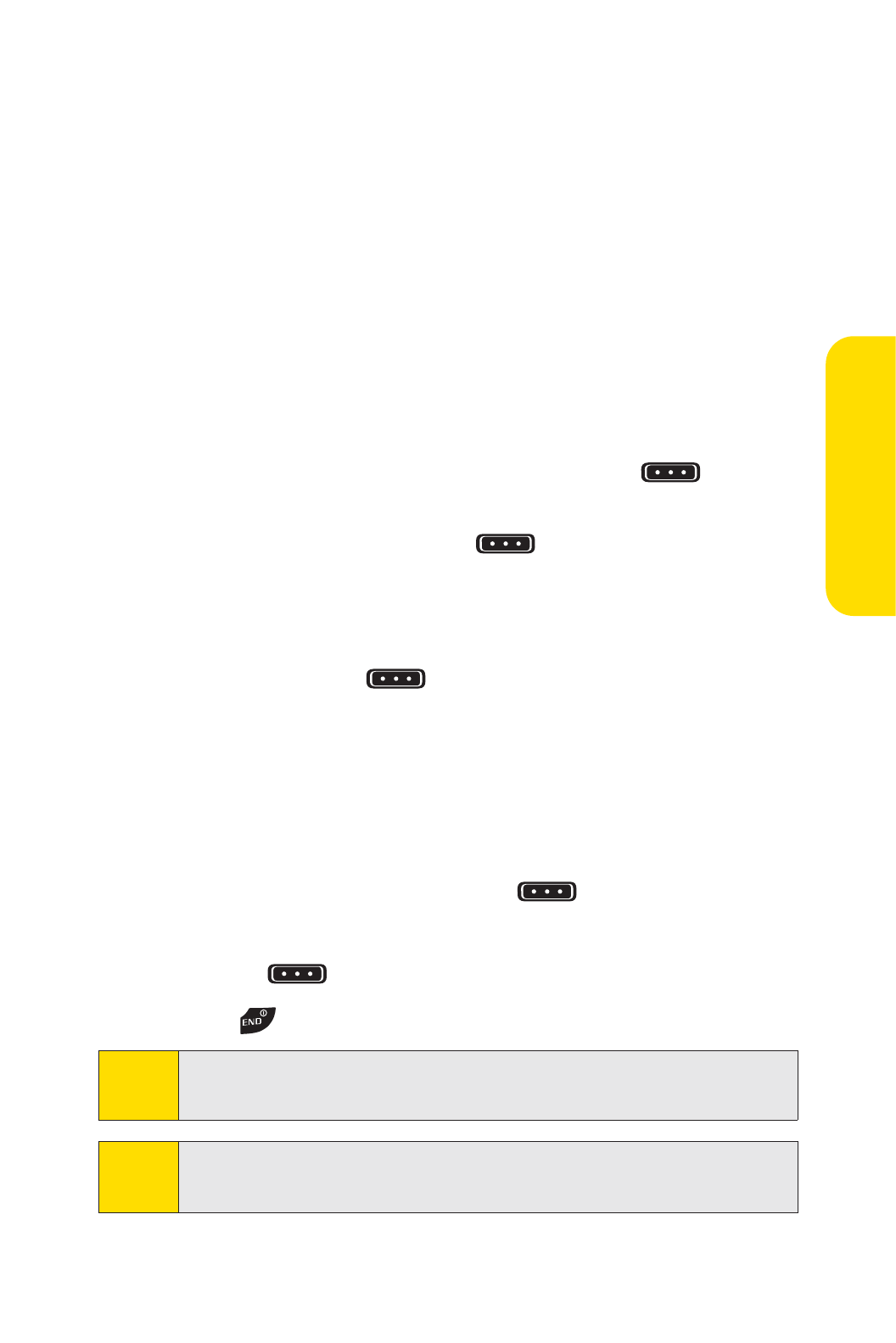
Section 2B: Making and Answering Calls 51
Making Calls
Making a Direct Connect Call by Entering a Number
1. Use your keypad to enter a Direct Connect number.
䡲The Direct Connect number may be the 10-digit
wireless phone number of the person you are calling.
– or –
䡲The Direct Connect number may have 3 parts – an
area ID, a network ID, and a member ID – with an
asterisk between each part (for example:
999*9999*999). When dialing or saving this type of
number, always include the asterisks (star key).
2. Press and release the Direct Connect key ( ) on the
side of your phone.
䡲Pressing and releasing “pings”the recipient.
The recipient’s phone emits an incoming tone and
displays your name or number. If available, he or she
can choose to respond and begin the conversation.
䡲You can hold and speak after you first press
and hear the tone, but your voice will be broadcast
instantly over the recipient’s speakerphone. Pinging
their phone by pressing and releasing may avoid
embarrassing interruptions.
3. After your party has responded and you hear the
incoming tone, press and hold and begin speaking
after the tone.
4. Release to listen.
5. Press to end the call.
Tip To display your Direct Connect number, press Menu > Settings >
Phone Info > Phone#/User ID.
Note All Direct Connect calls end automatically if there is no
activity on the call for several seconds.

52 Section 2B: Making and Answering Calls
Making a Direct Connect Call From Contacts:
1. Press Contacts (right softkey).
2. Select an entry and use the navigation key to highlight
the entry’s Direct Connect number or Mobile+DC number.
3. Press and release and continue the Direct Connect
call as described previously.
Making a Direct Connect Call From Recent History
1. Press >History.
2. Select an entry and press and release .
3. Continue the Direct Connect call as described previously.
Answering Direct Connect Calls
When you receive a Direct Connect call, you hear an incoming
tone or the phone vibrates. You then hear the caller’s voice
through the speakerphone. If available, the caller’s name or
Direct Connect number appear on the display.
1. When the caller has finished speaking, a tone sounds
and “Open”appears on the display. Press and hold
to reply.
2. Continue the Direct Connect call as described previously.
Shortcut To display a list of recent Direct Connect calls, press the
Direct Connect key in standby mode.

Section 2B: Making and Answering Calls 53
Using Call Alerts
Call Alerts let you notify someone that you want to
communicate with them using Direct Connect. When a user
receives a Call Alert, pressing the Direct Connect key places a
Direct Connect call directly to the sender.
To send a Call Alert:
1. Enter a Direct Connect number or select a number from
Recent History or Contacts.
2. Press Msg/Alert (left softkey) and select Call Alert.
(A prompt is displayed.)
䡲From the Call Alert prompt, you may attach a brief
preset text message. Press the navigation key right
or left from the prompt to scroll through available
messages.
Note Optional Call Alert preset text messages can only be received
by Direct Connect users with Sprint phones. They are not
compatible with Nextel phones.
Note Call Alerts continue to repeat for a set amount of time
(default is five minutes) or until the recipient returns the call
or ignores the alert. The default Call Alert time can be
adjusted in the Settings > Sounds > Alerts > Call Alerts menu.
Tip Be considerate. When you are in an area where incoming
Direct Connect calls may disturb others, or if you wish to
increase the privacy of your calls, please set your
speakerphone to Off and your ringer to vibrate. When the
speakerphone is off, Direct Connect calls use the phone’s
earpiece and microphone, while still utilizing the Direct
Connect key. You may also use an earbud or other handsfree
device for increased convenience.
Making Calls

54 Section 2B: Making and Answering Calls
3. Press and release . (The recipient’s phone will emit
an incoming tone and display an alert.)
To reply to a Call Alert:
1. With the Call Alert displayed, press and hold to
return the call.
2. Continue with the Direct Connect call as previously
detailed.
To ignore a Call Alert:
䊳Press Ignore (right softkey).
Setting Direct Connect Permissions
With Direct Connect, you can control which numbers can
reach your phone using Direct Connect.
1. Press > Settings > Direct Connect > Permissions.
2. Select an option and press .
䡲Accept all DC calls, except those from numbers I block.
This is the default option. All incoming Direct
Connect calls are accepted, other than those you add
to the Blocked DC #s list.
䡲Reject all DC calls, except those from numbers I allow.
All incoming Direct Connect calls are rejected, other
than those you add to the Allowed DC #s list.
3. Follow the instructions to add or edit the Blocked DC #s
or the Allowed DC #s list.
Tip You can also allow or block numbers directly from the
Contacts list or Recent History. From the Contacts or Recent
History list, press Options (right softkey) > Allow/Block DC Calls
and follow the onscreen instructions.

Section 2B: Making and Answering Calls 55
Making Group Connect Calls
Group Connect call allows you to communicate with up to 20
other members of a user-created group. For information on
creating groups and saving in your Contacts, see “Creating a
Group Connect Entry”on page 114.
1. Press Contacts (right softkey).
– or –
Press >History.
2. Select a group connect entry and press .
3. Continue the Group Connect call as if making a regular
Direct Connect call.
4. When you are finished, press to end the call.
Answering Group Connect Calls
When you receive a Group Connect call, you hear the incoming
tone or the phone vibrates. You then hear the caller’s voice
through the speakerphone. If available, the name of the group,
the caller’s name or Direct Connect number appear on the
display. Continue as if making a regular Direct Connect call.
Tip During a Group Connect call, you can view details about the
other group members, such as their name or Direct Connect
number by pressing Details (left softkey).
Note Only one person at a time may speak on a Group Connect call.
Making Calls

56 Section 2B: Making and Answering Calls
Using Team DC
Team DC lets Direct Connect users make group calls to up to 34
other users nationwide. With Team DC, any Direct Connect on
Sprint user can create a Team DC group online, which is then
pushed automatically to all the group members’phones. Once
the Team DC group has been created and distributed, any
member of the group can make a Team DC call to the entire
group. If the user who created the group makes any changes to
the group, updates are sent to the members’phones.
Setting Up a Team DC Group
Team DC groups are created online by a team leader. Only the
Team DC group creator or an account administrator may
modify the group member list.
1. Sign on to your account at www.sprint.com.
2. From your account summary page, click My Online Tools >
Sprint Mobile Sync > My Contacts > Add Group > TeamDC.
3. Add Team DC members directly (using Direct Connect
numbers) or select individual members or groups from
your Contacts list.
4. Click Set Talker Priority to select a Talker Priority for each
group member. (Default is Medium.)
䡲You can assign a priority of Low,Medium, or High to
each member.
䡲During a Team DC call, members with a higher Talker
Priority can “break in” when members with a lower
priority are speaking.
Note The Team DC feature is only available to Sprint users. Direct
Connect users with Nextel phones cannot be included in
Team DC groups.

Section 2B: Making and Answering Calls 57
5. Click Save to save the Team DC group and distribute it to
the other group members.
Making a Team DC Call
1. Press Contacts (right softkey).
– or –
Press >History.
2. Select a Team DC group and press .
3. Continue the Team DC call as any other Direct Connect
or Group Connect call.
4. When you are finished, press to end the call. (When
you end a Team DC call that you initiated, all other
participants are dropped from the call.)
Note Group Termination Options:By default, when the originator of
a Group Connect or Team DC call ends the call, all other
participants are disconnected as well. When available, you
will be able to select a setting in Settings > Direct Connect >
Group Call Opt. to allow Group Connect and Team DC calls you
initiate to remain active after you leave the call.
Note Talker Priority: The optional Team DC “Talker Priority” feature
lets you define a priority level (Low, Medium, or High) for each
member of a Team DC group. When a Team DC call is active,
members with a higher priority may interrupt a member with
a lower prioity while he or she is speaking. By default, all
members of a Team DC group are assigned a “Medium”
priority level.
Making Calls
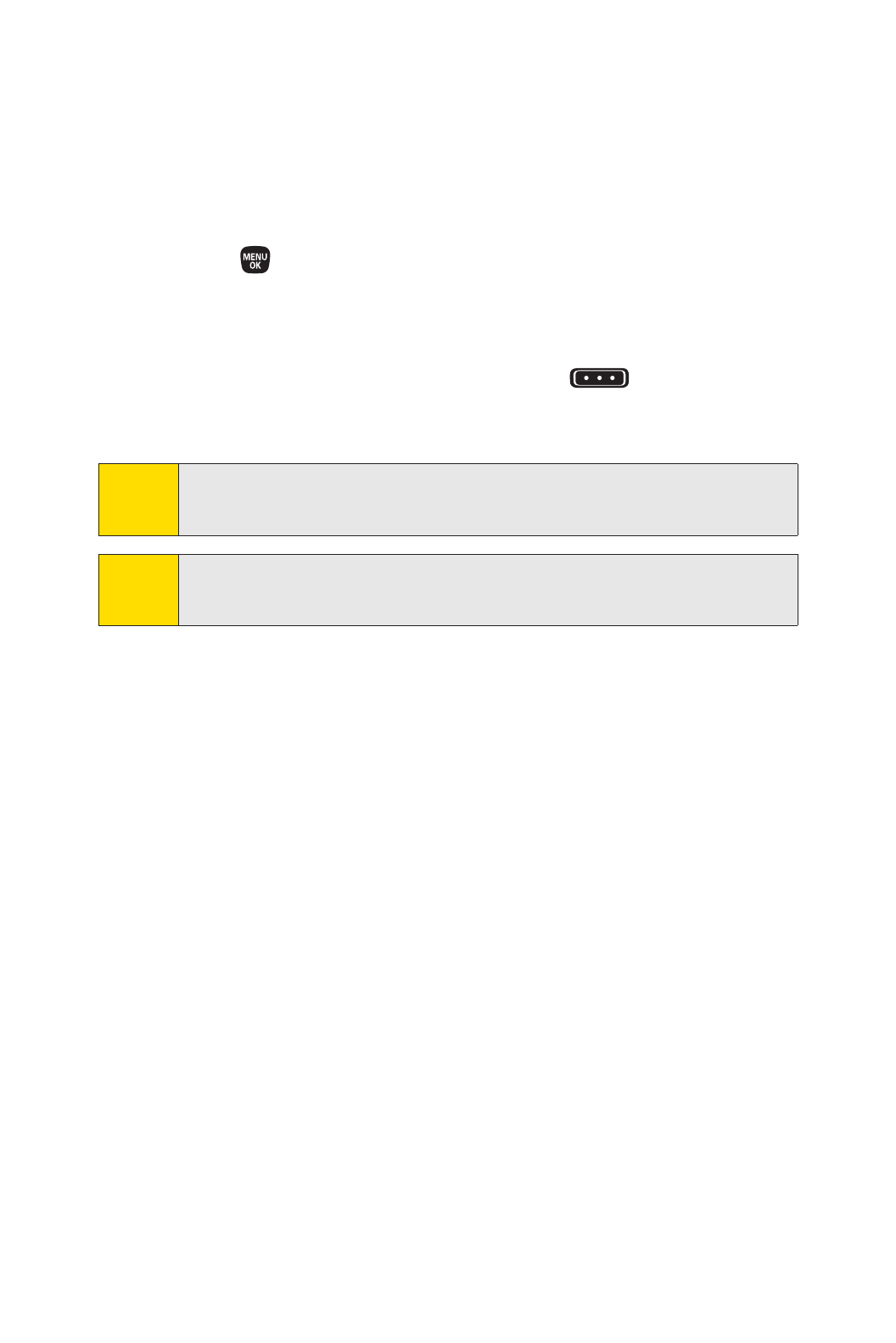
58 Section 2B: Making and Answering Calls
Joining or Rejoining a Team DC Call
If a member of a Team DC call is not available at the beginning
of a call, or if a member drops off the call temporarily, they may
rejoin the in-progress Team DC call.
1. Press >History.
– or –
Press Contacts (right softkey).
2. Select the Team DC entry and press .
3. Continue the Team DC call as described previously.
Team DC Call Information
During a Team DC call, the following information may appear
on your screen:
䢇The name of the group.
䢇The name or Direct Connect number of the person
speaking.
䢇The number of Team DC members who are connected on
the call out of the number invited (for example, 4 out of 6).
You can view a complete list of group members for your active
Team DC call by pressing Details (left softkey).
Note If the Team DC call has already ended, pressing the Direct
Connect key initiates a new Team DC call.
Tip You may also join or rejoin a Team DC call from your Contacts.
Select the Team DC group and press the Direct Connect key.

Section 2C: Controlling Your Phone’s Settings 59
Section 2C
Controlling Your Phone’s Settings
In This Section
⽧Sound Settings (page 60)
⽧Display Settings (page 66)
⽧Location Settings (page 71)
⽧Messaging Settings (page 72)
⽧Airplane Mode (page 78)
⽧TTY Use With Sprint Service (page 79)
⽧Phone Setup Options (page 80)
You can customize your phone to sound, look, and operate just
the way you want it to. This section describes how to change
your phone’s settings to best suit your needs. Take a few
moments to review these options and to adjust or add
settings that are right for you.
Your Phone’s Settings

60 Section 2C: Controlling Your Phone’s Settings
Sound Settings
Ringer Types
Ringer types help you identify incoming calls and messages.
You can assign ringer types to individual Contacts entries,
types of calls, and types of messages.
Selecting Ringer Types for Incoming Calls
Your phone provides a variety of ringer options that allow you
to customize your ring and volume settings. These options
allow you to identify incoming calls by the ring.
1. Press > Settings > Sounds > Ringer Type >
Incoming Calls.
2. Select With Caller ID or Without Caller ID and press .
3. Select Downloads or Other Ringers. (The list of available
ringers is displayed.)
4. Use your navigation key to scroll through the available
ringers. A sample ringer will sound as you highlight each
option.
5. Press to assign a ringer.
Setting Ringer Types for Direct Connect Calls
Your phone provides a variety of ringer types that allow you to
customize your ringer settings.
1. Press > Settings > Sounds > Ringer Type > Direct Connect.
2. Select Incoming DC Call or Chirp and press .
3. Use your navigation key to scroll through the available
ringers. A sample ringer will sound as you highlight each
option.
4. Press to assign a ringer.

Section 2C: Controlling Your Phone’s Settings 61
Selecting Ringer Types for Messages
1. Press > Settings > Sounds > Ringer Type > Messaging.
2. Select Text Message,Picture Mail,Voicemail,VoiceSMS,or
Email.
3. Select Downloads or Other Ringers. (The list of available
ringers is displayed.)
4. Use your navigation key to scroll through the available
ringers. A sample ringer will sound as you highlight each
option.
5. Press to assign a ringer.
Selecting a Ringer Type for Alarms, Power On/Off Tone, or
Scheduled Events
1. Press > Settings > Sounds > Ringer Type.
2. Select Alarm,Power On,Power Off, or Schedule.
3. Use your navigation key to scroll through the available
ringers.
4. Press to assign a ringer.
Your Phone’s Settings

62 Section 2C: Controlling Your Phone’s Settings
Selecting Vibrate Types
With this feature, you can select vibrate types for incoming
calls, messages, alarms, and scheduled events.
1. Press > Settings > Sounds > Vibrate Type.
2. Select Incoming Calls,Messaging,Alarm, or Schedule.
䡲Incoming Calls: select With Caller ID or
Without Caller ID.
䡲Messaging: select Text Message,Picture Mail,
Voicemail,VoiceSMS, or Email.
3. Select a vibrate type and press .
Selecting a Key Tone
Your phone offers a number of options for selecting the
audible tones accompanying a keypress.
1. Press > Settings > Sounds > Keytones.
2. Select an option and press .
䡲Tone Length to select a key tone length. (Longer tone
lengths may be better for tone recognition when
dialing voicemail or other automated systems.)
䡲Tone Volume to select a keypress volume level.
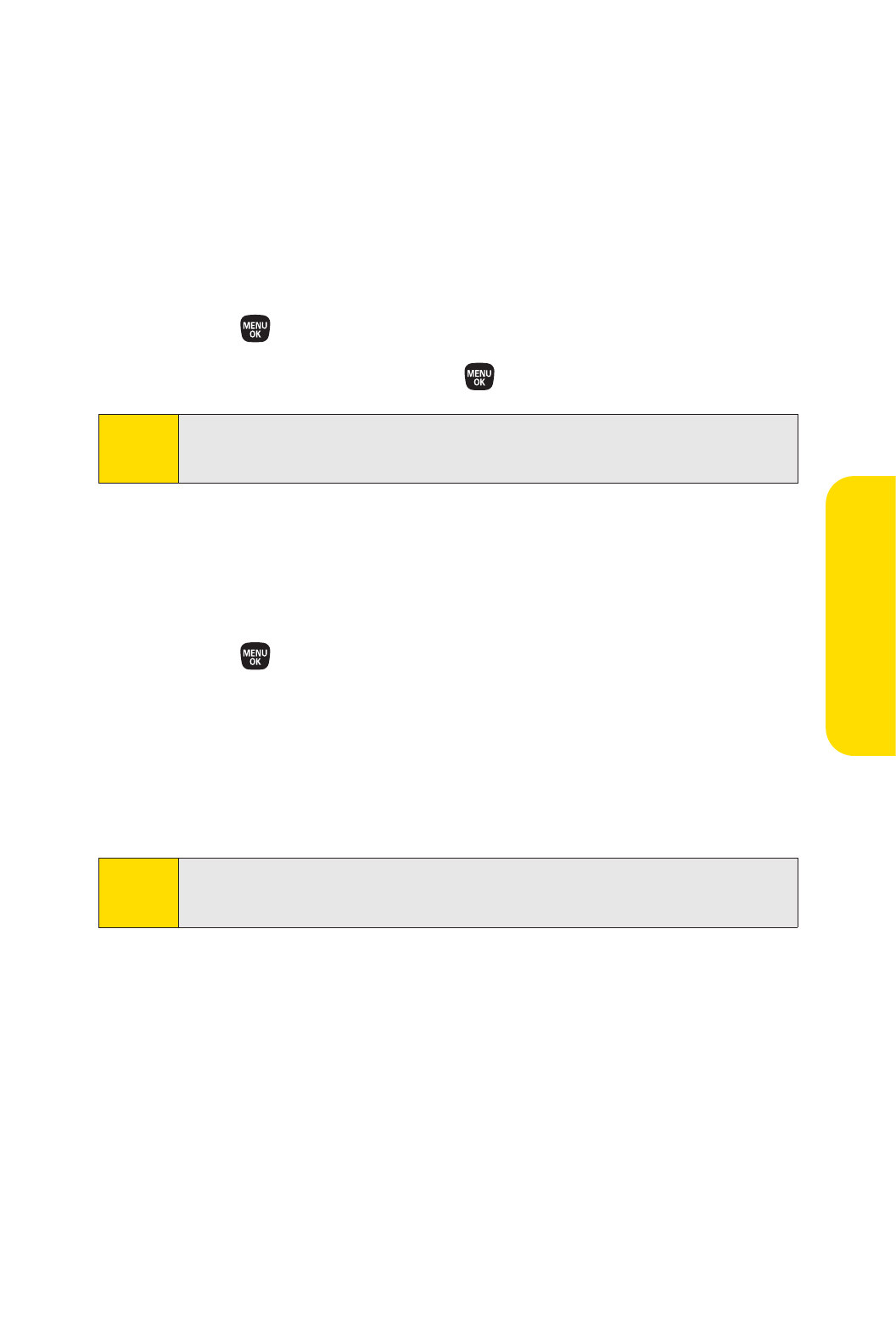
Section 2C: Controlling Your Phone’s Settings 63
Setting Up Voice Guide
Voice Guide activates both voice prompt and keypress echo
functions. With this feature on, you can hear voice prompts
when using voice-activated dialing, Voice Memo, Screen Call
setting, etc. and hear the numbers that you press on the
keypad. (The default setting is Off).
1. Press > Settings > Sounds > Voice Guide.
2. Select On or Off and press .
Adjusting the Phone’s Volume Settings
Adjust your phone’s volume settings to suit your needs and
your environment.
1. Press > Settings > Sounds > Volume.
2. Select Ringer,Earpiece,Headset,Speakerphone,
Applications, or Start-up/Pw-off.
3. Using the navigation key, choose a volume level, and
press Done (left softkey).
Tip You can adjust the ringer volume in standby mode (or the
earpiece volume during a call) by using the side volume key.
Note When the ringer volume is set to Silence All or Vibrate All, voice
prompts cannot be heard.
Your Phone’s Settings

64 Section 2C: Controlling Your Phone’s Settings
Adjusting the Alert Volume Settings
You can set the alert volume separately from the ringer
volume setting.
1. Press > Settings > Sounds > Volume> Advanced...
2. Select Alarms,Text Message,Picture Mail,Voicemail,
VoiceSMS,Email, or Call Alerts.
3. Using the navigation key, select Separate Vol.
䡲You can make the ringer vibrate at any volume level
by checking the box next to Always Vibrate.
4. Press the navigation key left or right to choose a volume
level, and press Done (left softkey).
Alert Notification
Set your phone to alert you with an audible tone when you
change service areas, once a minute during a voice call, or
when a call has been connected.
1. Press > Settings > Sounds > Alerts.
2. Select Beep Each Minute,Out of Service,Connect,
Signal Fade/Call Drop,Messaging, or Call Alerts and
press .
3. Use your navigation key to select a setting and press .

Section 2C: Controlling Your Phone’s Settings 65
Silence All
The Silence All option allows you to mute all sounds without
turning your phone off.
To activate Silence All:
䊳With the phone open, press the side volume key down
repeatedly in standby mode. (The screen will display
“Silence All.”)
To deactivate Silence All:
䊳With the phone open, press the side volume key up
repeatedly to select a volume level.
Your Phone’s Settings
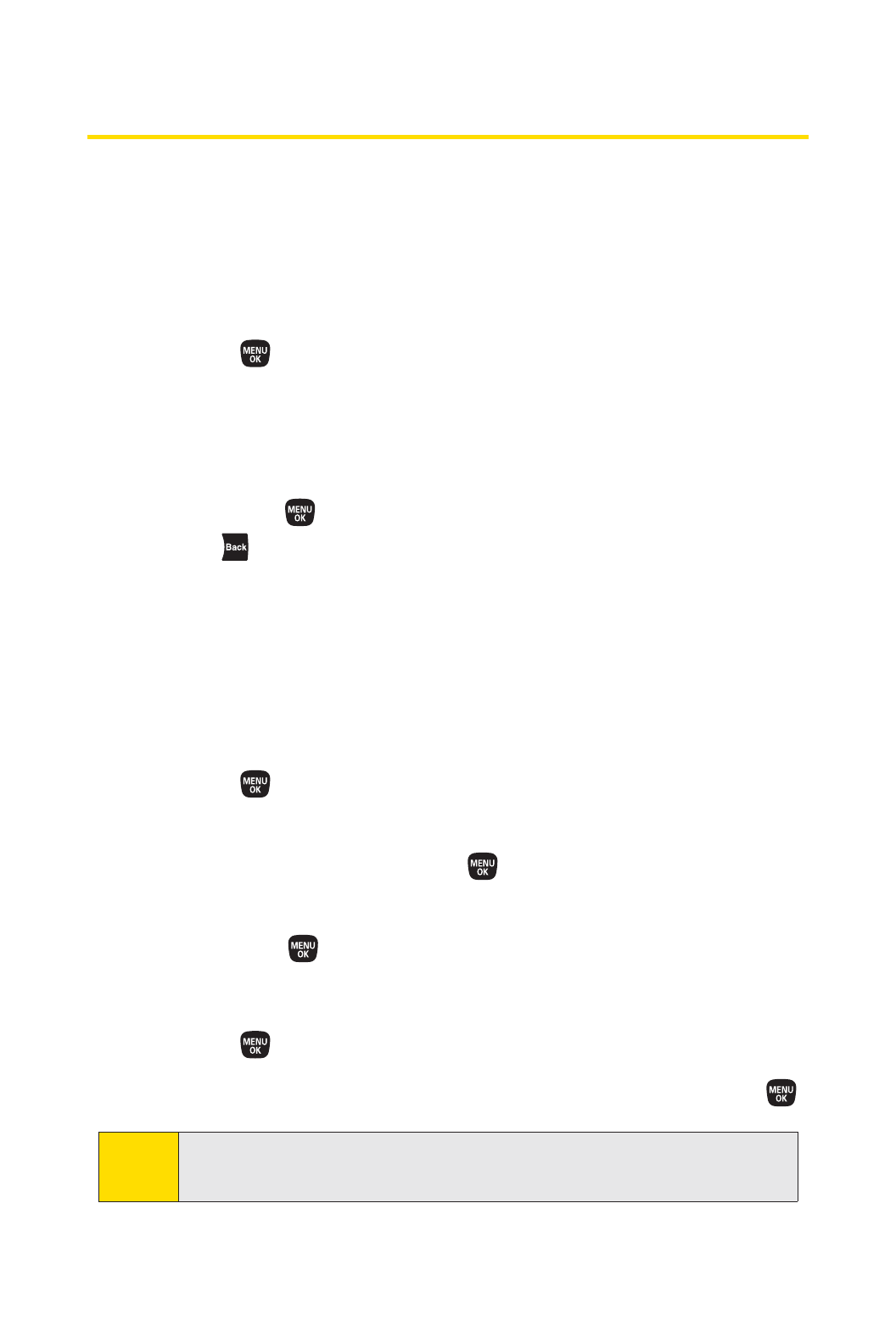
66 Section 2C: Controlling Your Phone’s Settings
Display Settings
Changing the Text Greeting
A text greeting is displayed on your phone’s screen in standby
mode. Choose the phone’s default greeting (“Sprint”), or enter
your own custom greeting.
1. Press > Settings > Display > Main Screen >
Foreground > Greeting.
2. Select Default or Custom.
䡲If you select Custom, enter a custom greeting and
press . (See “Entering Text”on page 29.) (Use the
key to erase the existing greeting.)
Changing the Backlight Time Length
Select how long the display screen and keypad remain backlit
after any keypress is made.
To change the Backlight setting:
1. Press > Settings > Display > Main Screen or
Outer Screen.
2. Select Backlight and press .
3. Select Dim Only,Always On, or a preset length of time
and press .
To change the Keypad Light setting:
1. Press > Settings > Display > Keypad Light.
2. Select AlwaysOff or a preset length of time and press .
Note Long backlight settings reduce the battery’s talk and standby
times .

Section 2C: Controlling Your Phone’s Settings 67
Changing the Display Screen Animation
Your new phone offers options for what you see on the display
screen during various phone functions.
1. Press > Settings > Display > Main Screen > Animation.
2. Select Outgoing Calls or Service Search.
3. Select an option (Preset,Downloads, or Off), and press .
Changing the Display for Incoming Calls
You can set a color or downloaded image for the Incoming
Calls display.
1. Press > Settings > Display > Main Screen >
Incoming Calls.
2. Select an option (Preset,Downloads, or Off) and press .
3. Select a color or an image and press .
Changing the Screen Saver
Your phone offers you the option of displaying a screen saver
while in standby mode.
1. Press > Settings > Display > Main Screen > Screensaver.
2. Select an option (Preset,Downloads, or Off) and press .
3. Select a screen saver and press .
Your Phone’s Settings

68 Section 2C: Controlling Your Phone’s Settings
Changing the Contrast
Adjust your screen’s contrast (brightness) to suit your
surroundings.
1. Press > Settings > Display > Contrast.
2. Press your navigation key up or down to adjust the
screen contrast and press .
Changing the Phone’s Menu Style
Choose how your phone’s menu is displayed on the screen.
1. Press to access the main menu, and then press
Options (right softkey) > Change View.
2. Select a menu style (Grid View or ListView) and press .
Changing the Background
Customize your phone’s display appearance by selecting a
color scheme to reflect your personality.
1. Press > Settings > Display > Main Screen > Background.
2. Select an option and press .
Changing the Clock Display
Choose whether you want your phone’s clock to be displayed
in standby mode.
1. Press > Settings > Display > Main Screen or
Outer Screen.
2. Select Foreground > Clock/Calendar.
3. Select a display option and press .
4. Press OK (left softkey) to apply the setting.

Section 2C: Controlling Your Phone’s Settings 69
Changing the Text Font Size
This setting allows you to adjust the Main Screen font size
(when viewing messages or browsing on the Web) and the
Outer Screen font size (when viewing names).
1. Press > Settings > Display > Font Size.
2. Select an option and press .
䡲Main Screen to select Messaging or Browser.
䡲Outer Screen to select Names.
3. Select a font size and press .
Changing the Input Font
Adjust the font when entering text (for example, when
adding a Contacts entry).
1. Press > Settings > Display > Main Screen > Input Font.
2. Select Phone#s,Messaging, or Others.
3. Select an input font size and press .
Setting Return to Standby Mode
This feature allows you to select how you return to standby
mode.
1. Press > Settings > Display > Return to Idle.
2. A message appears. Press OK (left softkey) to continue.
3. Select Automatically or End Key and press .
䡲Automatically to return to standby mode
automatically when no key is pressed for 30 seconds.
䡲End Key to return to standby mode by pressing .
Note The End Key setting affects the battery’s talk and standby
times.
Your Phone’s Settings

70 Section 2C: Controlling Your Phone’s Settings
Power Save Mode
This feature helps conserve your battery power by setting the
Main Screen and Outer Screen backlights to “Dim Only,”the
Main Screen sleep mode to “after 30 sec.,”and the Outer
Screen sleep mode to “after 5 sec.”
1. Press > Settings > Display > Power Save Mode.
2. A message appears. Press OK (left softkey) to continue.
3. Select On or Off and press .
Sleep Mode
This feature helps conserve your battery power by restricting
the display.
1. Press > Settings > Display.
2. Select Main Screen or Outer Screen.
3. Select Sleep Mode and press .
4. Select a time interval before the phone goes into sleep
mode and press . (Select Off to deactivate this
feature.)
Display Language
You can choose to display your phone’s onscreen menus in
English or in Spanish.
1. Press > Settings > Display > Language.
2. Select English or Español and press .
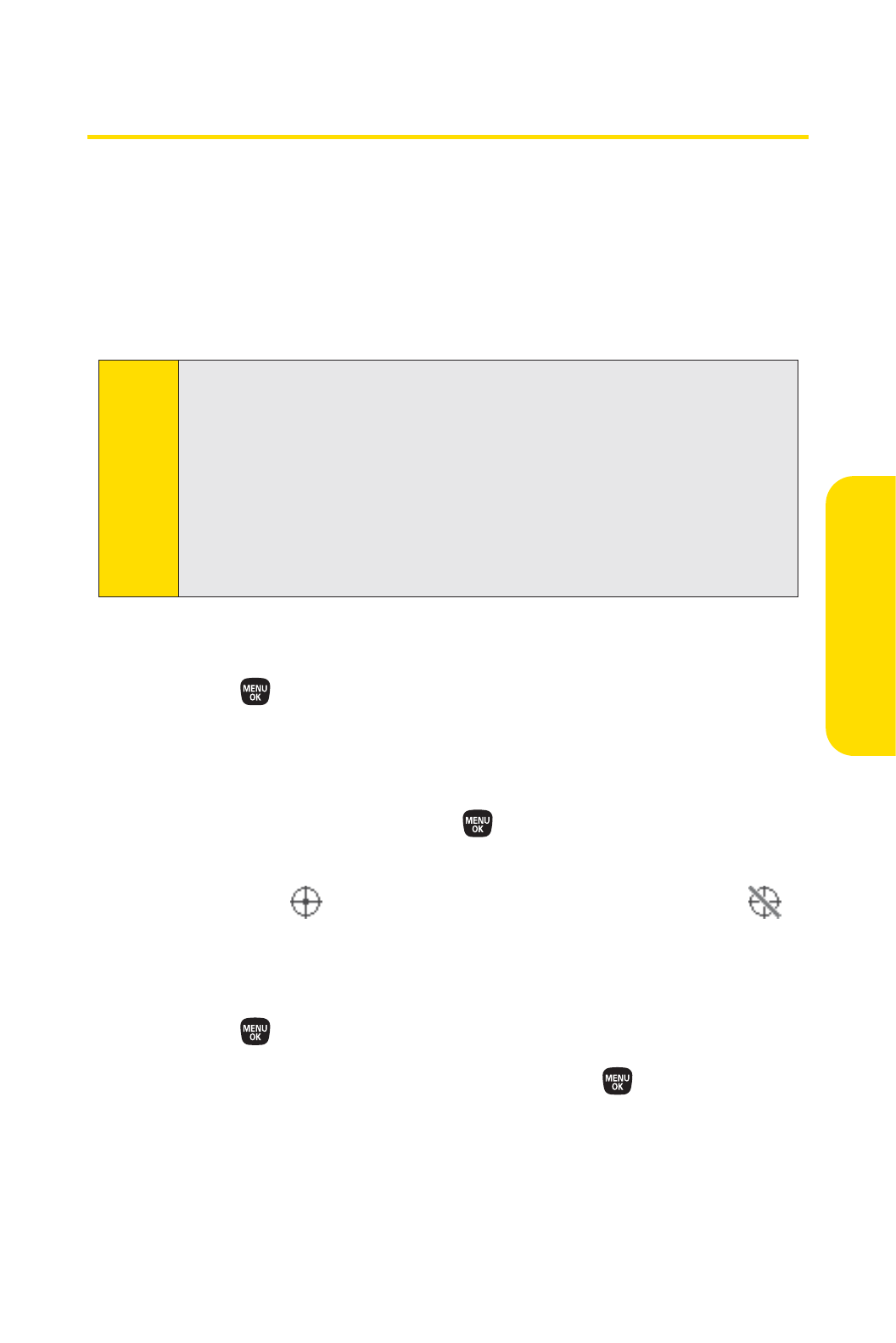
Section 2C: Controlling Your Phone’s Settings 71
Location Settings
Your phone is equipped with a Location feature for use in
connection with location-based services.
The Location feature allows the network to detect your
position. Turning Location off will hide your location from
everyone except 911.
To enable your phone’s Location feature:
1. Press > Settings > More... > Location > On/Off.
(The Location disclaimer will be displayed.)
2. Read the disclaimer and pressOK (left softkey).
3. Select On or Off and press .
When the Location feature is on, your phone’s standby screen
will display the icon. When Location is turned off, the
icon will be displayed.
To send the GPS log to other devices:
1. Press > Settings > More... > Location > NMEA Output.
2. Select Bluetooth,USB, or Off and press .
Note Turning Location on will allow the network to detect your
position using GPS technology, making some Sprint
applications and services easier to use. Turning Location off
will disable the GPS location function for all purposes except
911, but will not hide your general location based on the cell
site serving your call. No application or service may use your
location without your request or permission. GPS-enhanced
911 is not available in all areas.
Your Phone’s Settings

72 Section 2C: Controlling Your Phone’s Settings
Messaging Settings
Staying connected to your friends and family has never been
easier. With your phone’s advanced messaging capabilities,
you can send and receive many different kinds of text
messages without placing a voice call. (For more information,
see “Accessing Messaging”on page 185.)
Messaging settings make text messaging easier by letting you
decide how you would like to be notified of new messages,
create a signature with each sent message, and create your
own preset messages.
Setting Message Notification
When you receive a message, your phone notifies you by
displaying an icon on your display screen. You can also choose
to be notified with a message notification on your display
screen.
1. Press > Settings > Messaging > Notification.
2. Select Msgs and Icon or Icon Only.
Tip To access the Messaging Settings menu, you can also press
MENU > Messaging > Settings.

Section 2C: Controlling Your Phone’s Settings 73
SMS Text Messages
Adding a Customized Signature
Add a customized signature to each message you send.
1. Press > Settings > Messaging > Signature.
2. Select On in the Signature field. (If you do not wish to
attach a signature to your outgoing messages, select
Off.)
3. Enter your signature in the Text field. (See “Entering
Text”on page 29.)
4. Press OK (left softkey) >Save(left softkey).
Setting Message Reminders
When new messages arrive, you can choose to have your
phone notify you by playing an audible alert.
1. Press > Settings > Messaging > Message Reminder.
2. Select Text Message,Picture Mail,Voicemail,VoiceSMS,or
Email and press .
3. Select Repeat or Ringer Length and press .
4. Using the navigation key or your keypad, select a setting
and press .
Your Phone’s Settings
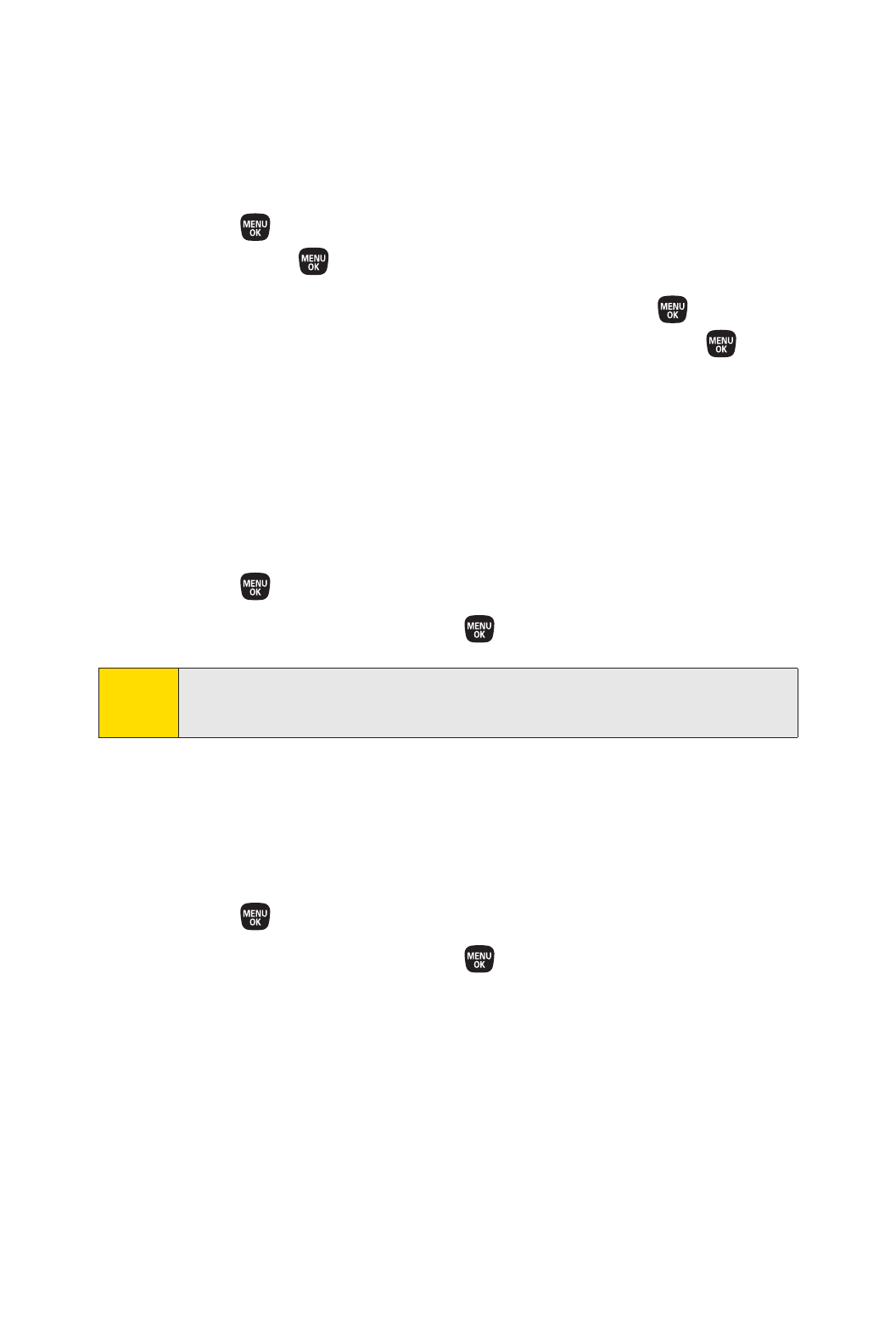
74 Section 2C: Controlling Your Phone’s Settings
Setting a Callback Number
With this feature, you can notify your recipients of your
callback number with a text message.
1. Press > Settings > Messaging > Callback Number, and
then press again.
2. Select None,My Phone#, or Other and press . (If you
select Other, enter a callback number and press >
Done [left softkey]).
Setting Delivery Confirmation
You can set your phone to receive a delivery message
confirming that your message was successfully delivered to
the recipient.
1. Press > Settings > Messaging > Delivery Receipt.
2. Select On or Off and press .
Setting Drafts Alert
With this feature, when you try to send an SMS Text message,
you are reminded if there are unsent messages in the Drafts
folder.
1. Press > Settings > Messaging > Drafts Alert.
2. Select On or Off and press .
Note The Delivery Receipt feature may not currently be supported
by the network.

Section 2C: Controlling Your Phone’s Settings 75
Managing Preset Messages
Your phone is loaded with 20 preset messages, in English and
in Spanish, to help make sending text messages easier.
Customize or delete these messages, such as “Where are
you?,”“Let’s get lunch,”and “Meet me at”to suit your needs,
or add your own messages to the list.
To edit or delete a preset message:
1. Press > Settings > Messaging > Preset Messages.
(The list of preset messages will be displayed.)
2. To edit or delete a message, select it and press Options
(right softkey).
3. Select Edit, edit the message (see “Entering Text”on
page 29), and press .
– or –
Select Delete > Yes (left softkey) to delete the message.
(You can also reset all messages by selecting
Reset All Msgs > Yes [left softkey].)
To change the language of the preset messages:
1. Press > Settings > Messaging > Preset Messages.
2. Press Options (right softkey) > Select Language.
3. Select English or Spanish.
Your Phone’s Settings

76 Section 2C: Controlling Your Phone’s Settings
SMS Voice Messages
Setting the Speakerphone
You can set the speakerphone on or off for SMS Voice
messaging. By default, the speakerphone is set to On.
1. Press > Settings > Messaging > VoiceSMS Options >
Speakerphone.
2. Select On or Off and press .
Setting the Sender’s Name
With this feature, you can identify yourself to people who
receive your SMS Voice messages.
1. Press > Settings > Messaging > VoiceSMS Options >
From Name.
2. Enter your name and press OK (left softkey).
Setting an Alert Notification
SMS Voice Messaging uses your phone’s data services. Your
phone can alert you that you are connecting to data services
each time you send an SMS Voice message.
1. Press > Settings > Messaging > VoiceSMS Options >
Connect. Alert.
2. Press Mark (right softkey) to alert you each time you
send an SMS Voice message.
3. Press Done (left softkey) to save the setting.

Section 2C: Controlling Your Phone’s Settings 77
Setting Auto Delete
With this feature (the default setting is On), if the SMS Voice
inbox becomes full, messages are automatically erased
starting with the oldest.
To set Auto Delete:
1. Press >Settings > Messaging > Auto-Delete.
2. Select On or Off.
Your Phone’s Settings

78 Section 2C: Controlling Your Phone’s Settings
Airplane Mode
Airplane Mode allows you to use many of your phone’s
features, such as Games and Voice Memos, when you are in an
airplane or in any other area where making or receiving calls
or data is prohibited. When you set your phone to Airplane
Mode, it cannot send or receive any calls or access online
information.
1. Press > Settings > More... > Airplane Mode.
2. Read the disclaimer and press OK (left softkey).
3. Select On or Off and press .
While in Airplane Mode, your phone’s standby screen will
display “Phone Off.”

Section 2C: Controlling Your Phone’s Settings 79
TTY UseWith Sprint Service
ATTY (teletypewriter, also known as a TDD or Text Telephone)
is a telecommunications device that allows people who are
deaf, hard of hearing, or who have speech or language
disabilities, to communicate by telephone.
Your phone is compatible with select TTY devices. Please check
with the manufacturer of your TTY device to ensure that it
supports digital wireless transmission. Your phone and TTY
device will connect via a special cable that plugs into your
phone’s headset jack. If this cable was not provided with your
TTY device, contact your TTY device manufacturer to purchase
the connector cable.
When establishing your Sprint service, please call Sprint
Customer Service via the state Telecommunications Relay
Service (TRS) by first dialing . Then provide
the state TRS with this number: 866-727-4889.
To turn TTY Mode on or off:
1. Press > Settings > More... > Accessibility > TTY.
(An informational message will be displayed.)
2. Read the disclaimer and press OK (left sotkey).
3. Select On to turn TTY mode on.
– or –
Select Off to turn TTY mode off.
Note In TTY Mode, your phone will display the TTY access icon.
If TTY mode is enabled, the audio quality of non-TTY devices
connected to the headset jack may be impaired.
Your Phone’s Settings

80 Section 2C: Controlling Your Phone’s Settings
Phone Setup Options
Navigation Key Shortcuts
You can use the navigation keys as shortcuts to access specific
menu items directly from standby mode. With this feature,
you can reassign the default shortcuts to the menu items you
choose.
1. Press > Settings > More... > Navigation Keys.
2. Select a navigation key and press .
3. Using the navigation key or your keypad, select a
shortcut and press Assign (left softkey). (If there are
additional levels available, press before selecting your
shortcut.)
4. Press to return to standby mode.
WARNING 911 Emergency Calling
Sprint recommends thatTTY users make emergency
calls by other means, including Telecommunications
Relay Services (TRS), analog cellular, and landline
communications. Wireless TTY calls to 911 may be
corrupted when received by public safety answering
points (PSAPs), rendering some communications
unintelligible. The problem encountered appears
related to TTY equipment or software used by PSAPs.
This matter has been brought to the attention of the
FCC, and the wireless industry and the PSAP
community are currently working to resolve this.
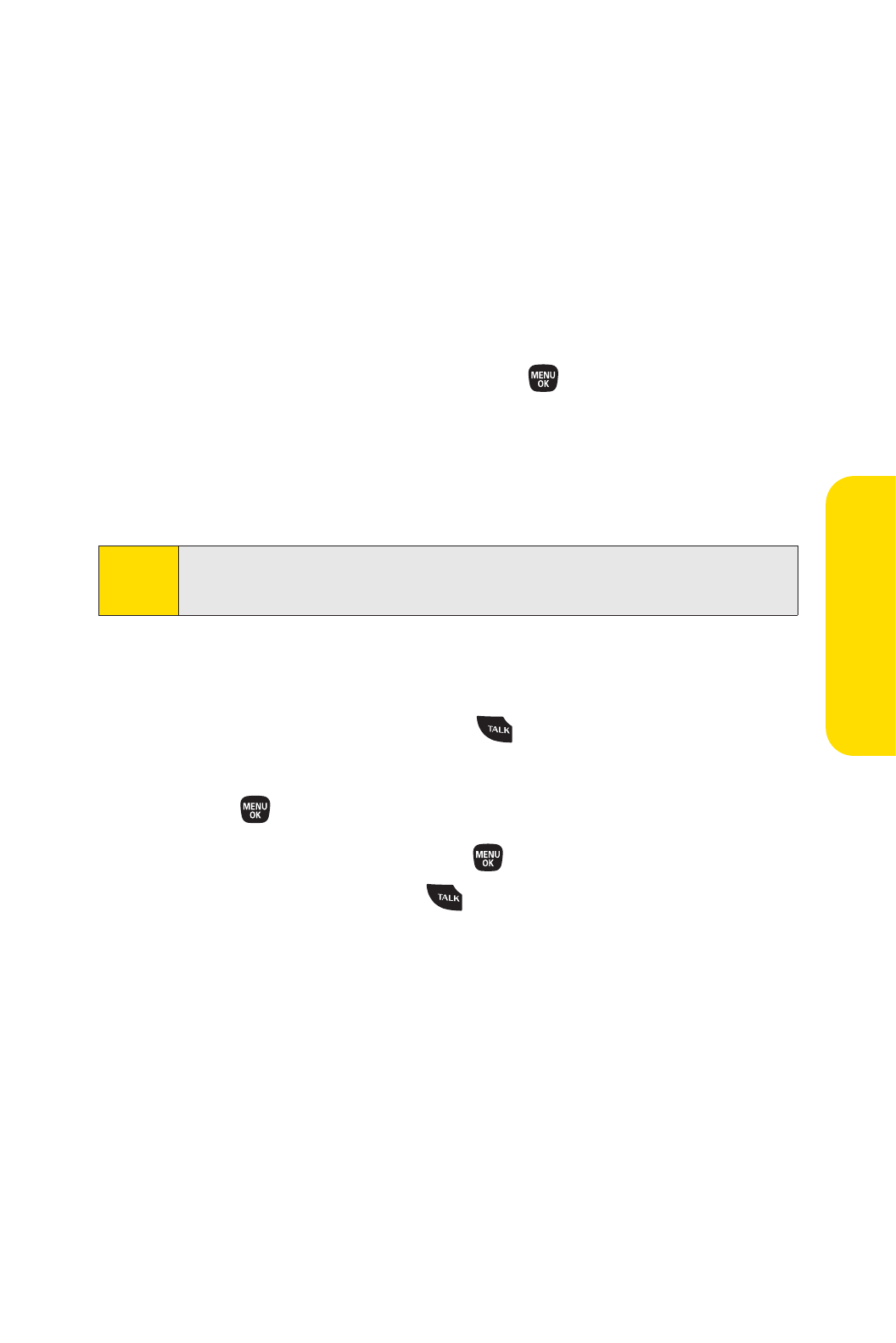
Section 2C: Controlling Your Phone’s Settings 81
My Favorites
Your phone offers you the option of assigning a shortcut to a
favorite or often-used function. Pressing Favorites (left
softkey) in standby mode will launch your personally
designated shortcut.
1. Press Favorites (left softkey) to display the My Favorites
list.
2. Select <Add Favorite> and press .
3. Using the navigation key or your keypad, select
functions to be assigned to the My Favorites list.
4. Press Assign (left softkey) to save.
Call Answer Mode
Select how to answer incoming calls on your phone: whether
you want to be required to press , to press any number key,
or simply to open the phone.
1. Press > Settings > More... > Call Setup > Call Answer.
2. Select an option and press .
䡲Talk Key to require to be pressed to answer all
incoming calls.
䡲Any Key to allow an incoming call to be answered by
pressing any key.
䡲Flip Open to allow an incoming call to be answered
by opening the phone.
Tip While My Favorites list is displayed, press Options (right
softkey) to customize the list according to your needs.
Your Phone’s Settings

82 Section 2C: Controlling Your Phone’s Settings
Auto-Answer Mode
Set your phone to automatically answer incoming calls when
connected to an optional hands-free device.
1. Press > Settings > More... > Call Setup >
Auto-Answer.
2. Select an option and press .
䡲Hands-free to answer calls automatically when the
phone is connected to a hands-free device (sold
separately). Remember, your phone will answer calls
in Auto-Answer mode even if you are not present.
䡲Speakerphone to answer calls automatically in
speakerphone mode.
3. Select 5 Seconds,15 Seconds, or Off and press .
Setting Power On to Alert
Power On to Alert helps prevent unintentional or accidental
power-on of your phone’s alarm settings while your phone is
turned off (the default setting is Off). This feature applies only
to Event Alerts, Call Alarm, and Alarm Clock.
1. Press > Settings > More... > Power On to Alert.
2. Select On or Off and press .
䡲On to activate alarm in Airplane Mode even if the
phone is turned off.
䡲Off to deactivate all alarm settings while the phone
is turned off.
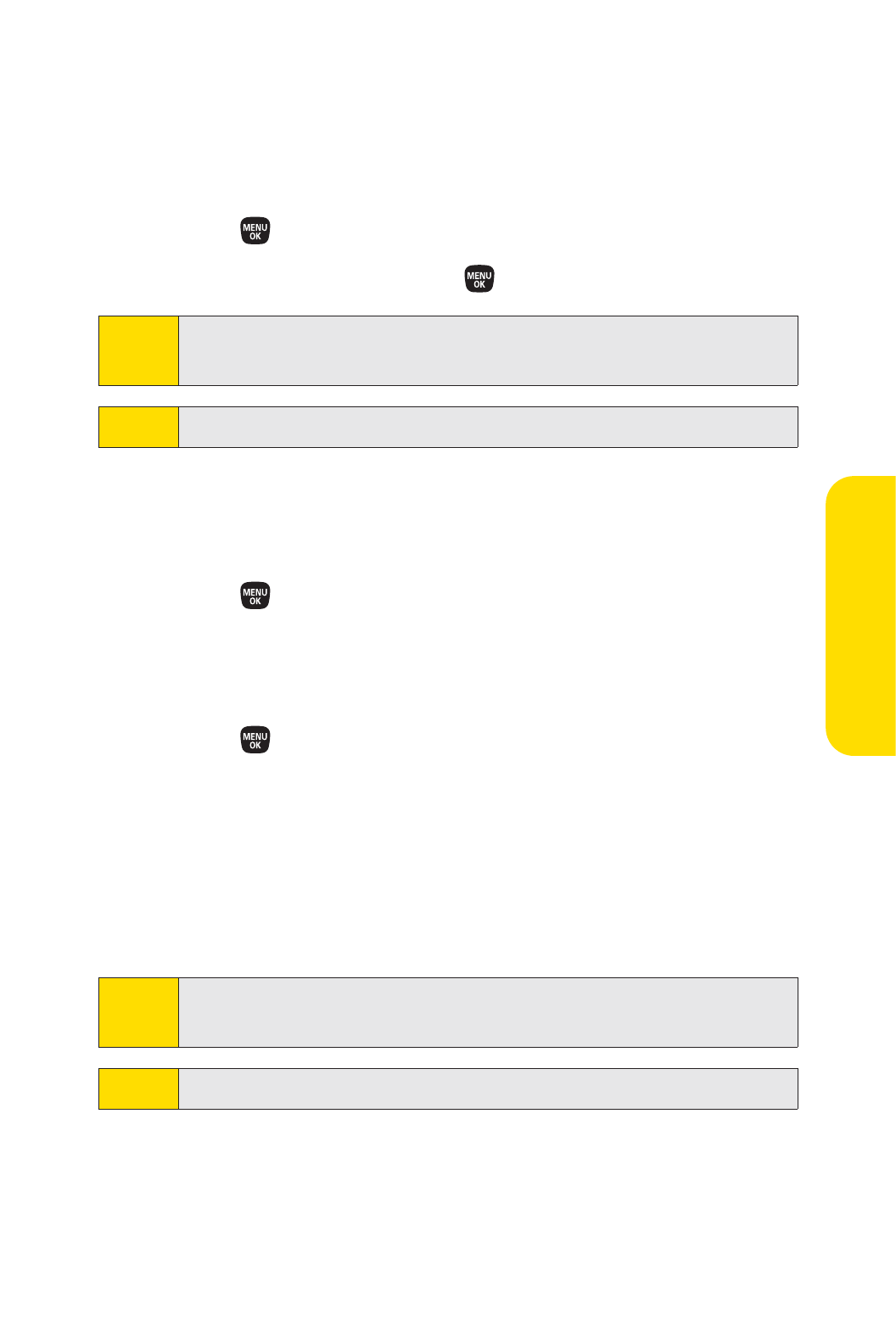
Section 2C: Controlling Your Phone’s Settings 83
Setting the Side Key Guard
This feature enables you to lock external keys while the phone
is closed.
1. Press > Settings > More... > Side Key Guard.
2. Select On or Off and press .
Setting Abbreviated Dialing
To activate the Contacts Match feature:
1. Press > Settings > More... > Call Setup.
2. Select Contacts Match > On.
To activate the Prepend feature:
1. Press > Settings > More... > Call Setup > Abbrev. Dial.
2. Select Prepend > On.
3. Enter the first five- or six-digit prefix in the Prepend#
field and then press OK (left softkey).
䡲To deactivate this feature, select Off during
step 2 above.
Note This setting does not apply to 911 or Sprint 411.
Tip To make an Abbreviated Dial call, see “Using Abbreviated
Dialing” on page 47.
Note This feature does not apply when the phone is open.
Tip You can deactivate this feature temporarily by pressing and
holding the side call key while the phone is closed.
Your Phone’s Settings

84 Section 2C: Controlling Your Phone’s Settings
Setting Headset Mode
This feature allows you hands-free phone use. Press the Turbo
Button (the operation button) on the headset to activate
useful functions.
To connect the headset:
䊳Simply plug the headset into your phone’s headset jack.
To set headset mode:
1. Press > Settings > More... > HeadsetMode.
2. Select Headset Button.
3. Select an option and press .
䡲Headset button starts voice calls to set the turbo
button for voice calls. Press the Turbo Button to
activate Voice Dial. Press twice to redial the last call.
Press and hold to record a Voice Memo.
䡲Headset button starts DC calls to set the turbo button
for Direct Connect calls. The Turbo Button functions
as a Direct Connect key.
To set the ringer sound:
1. Press > Settings > More... > HeadsetMode.
2. Select Ringer Sound.
3. Select Normal or Headset Only and press .
Browser Settings
This feature enables you to customize the Browser settings
through the phone’s settings menu.

Section 2C: Controlling Your Phone’s Settings 85
Editing Bookmarks
You can edit the name or URL of your bookmarks, sort, as well
as delete them from your phone.
1. Press > Settings > More... > Browser > Bookmarks.
2. Scroll to highlight the bookmark you’d like to edit and
press Options (right softkey).
3. Select an option and press .
䡲Show Page displays the Web page of the selected
bookmark.
䡲Edit to edit the title or address of a selected
bookmark.
䡲Set Home to set the selected bookmark to be your
home page.
䡲Delete to delete a selected bookmark.
䡲Delete All to delete all bookmarks saved in the
phone.
䡲Reorder to change the order of the bookmarks.
Deleting Browser Cache Files and Cookies
With this feature, you can delete the browser cache
(temporary files) and cookies files saved in the phone.
1. Press > Settings > More... > Browser.
2. Select Delete Web Cache or Delete Web Cookies.
3. If you are certain you would like to delete, press OK (left
softkey), and then press Yes (left softkey).
Editing the Home Page
This feature allows you to edit the URL of the home page on
your phone.
1. Press > Settings > More... > Browser > Edit Home Page.
2. Use your keypad to edit the URL and press OK (left
softkey) to save your changes.
Your Phone’s Settings

86 Section 2D: Setting Your Phone’s Security
Section 2D
Setting Your Phone’s Security
In This Section
⽧Accessing the Security Menu (page 87)
⽧Using Your Phone’s Lock Feature (page 87)
⽧Restricting Calls (page 89)
⽧Using Special Numbers (page 90)
⽧Deleting Phone Content (page 91)
⽧Resetting the Browser (page 92)
⽧Resetting My Favorites (page 92)
⽧Resetting Your Phone (page 93)
⽧Resetting Default Settings (page 93)
⽧Security Features for Sprint Power Vision (page 94)
By using the security settings on your phone, you receive
peace of mind without sacrificing flexibility. This section will
familiarize you with your phone’s security settings. With
several options available, you can customize your phone to
meet your personal needs.

Section 2D: Setting Your Phone’s Security 87
Accessing the Security Menu
All of your phone’s security settings are available through the
Security menu. You must enter your lock code to view the
Security menu.
1. Press > Settings > More... > Security.
2. Enter your lock code to display the Security menu.
Using Your Phone’s Lock Feature
Locking Your Phone
When your phone is locked, you can only receive incoming
calls or make calls to 911, Sprint Customer Service, or special
numbers. (See “Using Special Numbers”on page 90.)
1. Press > Settings > More... > Security and enter your lock
code.
2. Select Lock My Phone > Lock Now. (To set your phone to
lock the next time it is turned on, select On Power-Up.)
3. Select Full Lock or Exp. IncomingCalls.
Unlocking Your Phone
1. From standby mode, press Unlock (left softkey).
2. Enter your lock code.
Tip If you can’t recall your lock code, try using the last four digits
of your wireless phone number. If this doesn’t work, call Sprint
Customer Service at 1-800-SPRINT1 (1-800-777-4681), or
press *2 TALK.
Your Phone’s Security

88 Section 2D: Setting Your Phone’s Security
Changing the Lock Code
1. Press > Settings > More... > Security and enter your lock
code.
2. Select Change LockCode, and then enter and re-enter
your new lock code.
Calling in Lock Mode
You can place calls to 911 and to your special numbers when
in lock mode. (For information on special numbers, see “Using
Special Numbers”on page 90.)
䊳To call an emergency number, special number, or
Sprint Customer Service, enter the phone number
and press .
Locking Voice Calls
With this feature, you can restrict incoming and outgoing
voice calls.
1. Press > Settings > More... > Restrict and Lock.
2. Select Voice, and then enter your lock code.
3. Select Lock > Locked. (Select Unlocked to deactivate this
feature.)
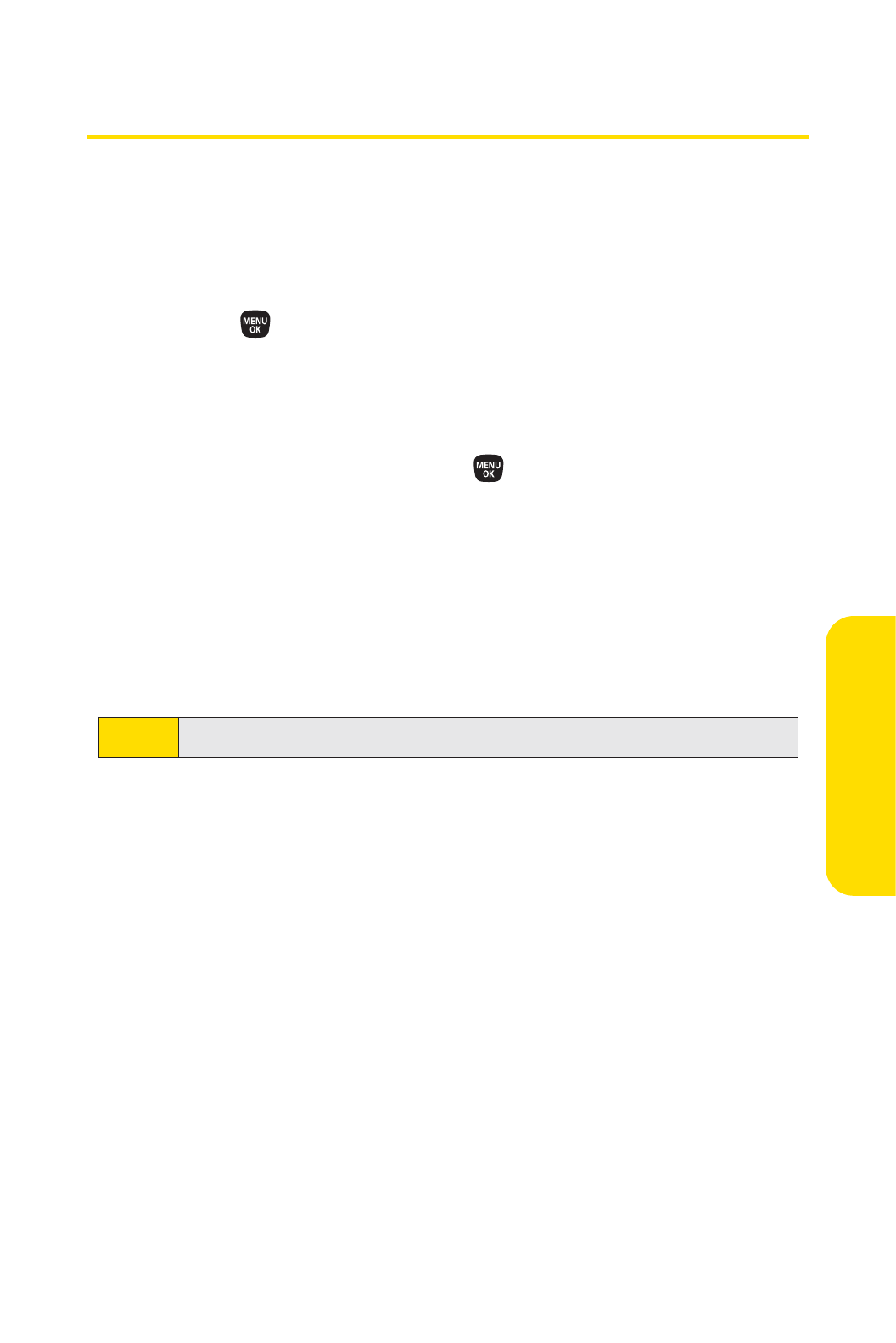
Section 2D: Setting Your Phone’s Security 89
Restricting Calls
There may be occasions when you want to limit the numbers
your phone can call or from which it can receive calls. You can
use the Restrict Calls setting to do just that. (The Restrict Calls
setting does not apply to 911 or Sprint Customer Service.)
1. Press > Settings > More... > Restrict and Lock.
2. Select Voice and enter your lock code.
3. Select Restrict > Incoming Calls or Outgoing Calls.
4. Select an option and press .
䡲Allow All to make or receive all calls.
䡲Contacts Only to make or receive calls to or from
Contacts entries, voicemail, or special numbers only.
䡲Special #s Only to make or receive calls to or from
three special numbers only. (See “Using Special
Numbers”on page 90.)
Note Restricted incoming calls are forwarded to voicemail.
Your Phone’s Security
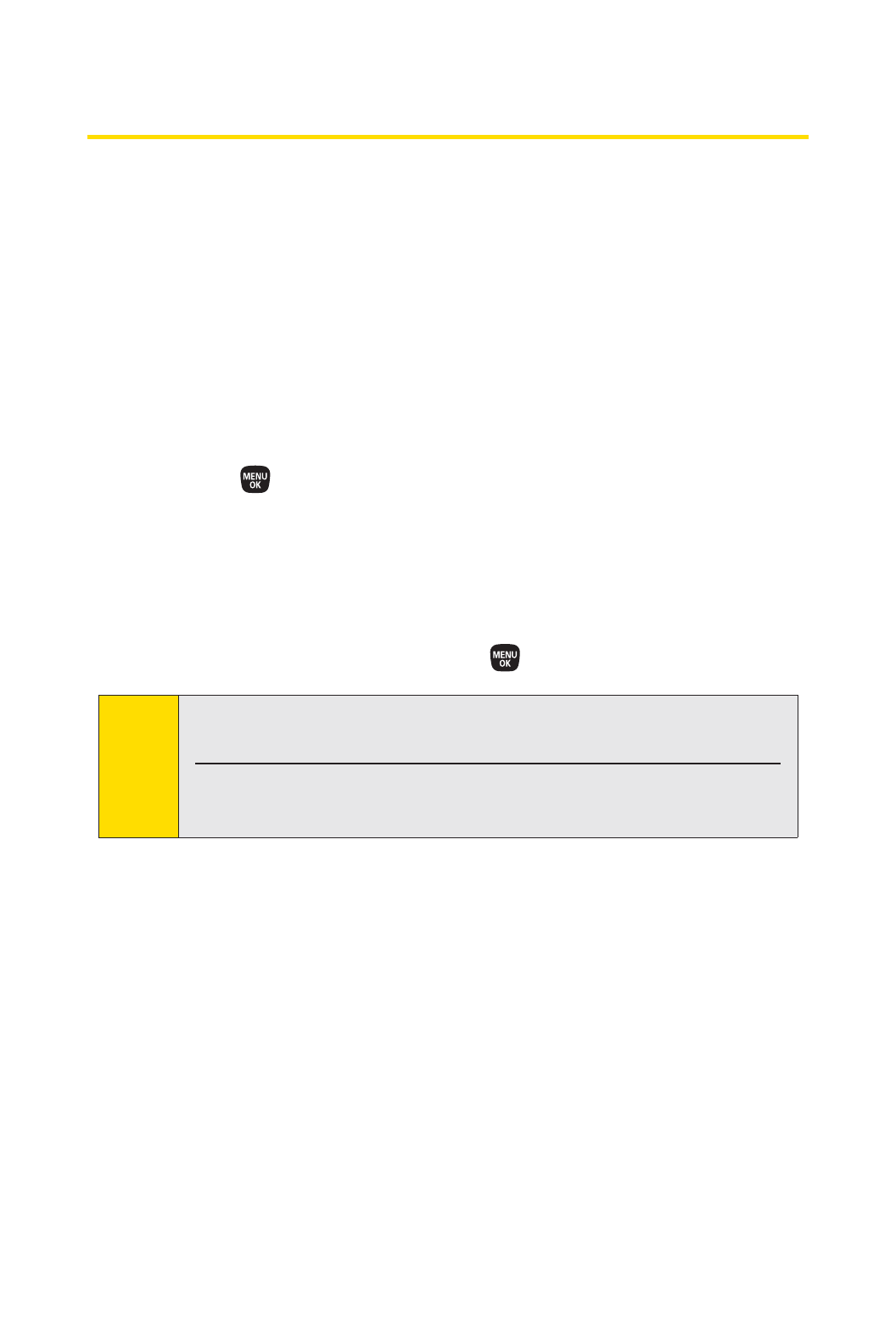
90 Section 2D: Setting Your Phone’s Security
Using Special Numbers
Special numbers are important numbers that you have
designated as being “always available.” You can call and
receive calls from special numbers even if your phone is
locked.
You can save up to three special numbers in addition to your
Contacts entries (the same number may be in both
directories).
To add or replace a special number:
1. Press > Settings > More... > Security and enter your lock
code.
2. Select Special Numbers.
3. Select a location for your entry.
4. Enter the number and press .
Note There are no speed dial options associated with special
numbers.
You cannot make calls to or receive calls from special numbers
if Voice is set to Locked in Restrict and Lock.

Section 2D: Setting Your Phone’s Security 91
Deleting Phone Content
You can quickly and easily delete all the content that you have
created in your phone.
1. Press > Settings > More... > Security and enter your lock
code.
2. Select Delete/Reset, and then select an option from the
following and press .
䡲Delete Web Cookies to delete all web cookies saved in
the phone.
䡲Delete Web History to delete all web histories saved
in the phone.
䡲Delete Web Cache to delete all web cache memories
saved in the phone.
䡲Delete Contacts to delete all of your Contacts entries.
䡲Delete Voice Tags to delete all tags you have recorded.
䡲Delete My Content to delete all items you have
downloaded to your phone.
䡲Delete Voice Data to delete all voice data and call
memos saved in the phone.
䡲Delete Message to delete all messages (including
locked ones) in the Inbox, Sent Mail, Pending, and
Drafts folders; all Recent Lists; and all user-created
preset messages (text messages, SMS Voice
messages, etc.).
䡲Delete Cal. Events to delete all scheduled events
(including secret ones).
3. If you are certain you would like to delete, press OK (left
softkey), and then press Yes (left softkey).
Your Phone’s Security

92 Section 2D: Setting Your Phone’s Security
Resetting the Browser
This option resets your Web browser’s history, bookmarks,
cookies, auto-complete text, and URLs.
1. Press > Settings > More... > Security and enter your lock
code.
2. Select Delete/Reset > Reset Browser.
3. If you are certain you would like to reset, press OK (left
softkey), and then press Yes (left softkey).
Resetting My Favorites
This option resets all of your My Favorites settings.
1. Press > Settings > More... > Security and enter your lock
code.
2. Select Delete/Reset > Reset Favorites.
3. If you are certain you would like to reset your My
Favorites settings, press OK (left softkey), and then
press Yes (left softkey).

Section 2D: Setting Your Phone’s Security 93
Resetting Your Phone
Resetting the phone resets all settings and delete all data on
your phone.
1. Press > Settings > More... > Security and enter your lock
code.
2. Select Delete/Reset > Reset Phone. (A disclaimer is
displayed.)
3. Read the disclaimer and press OK (left softkey).
4. If you are certain that you would like to delete all the
data and reset you settings, press Yes (left softkey).
Resetting Default Settings
Resetting the current default settings restores all the factory
defaults, including the ringer types and display settings. The
Contacts, Recent History, Calendar, and Messaging are not
affected.
1. Press > Settings > More... > Security and enter your lock
code.
2. Select Delete/Reset > Reset All Settings. (A warning is
displayed.)
3. Read the disclaimer and press OK (left softkey).
4. If you are certain that you would like to restore all the
factory settings, press Yes (left softkey).
Your Phone’s Security

94 Section 2D: Setting Your Phone’s Security
Security Features for Sprint Power Vision
Enabling and Disabling Data Services
You can disable Sprint Power Vision data services without
turning off your phone; however, you will not have access to
all data services, including Web and messaging. Disabling
data services will avoid any charges associated with Sprint
Power Vision services. While signed out, you can still place or
receive phone calls, check voicemail, and use other voice
services. You may enable data services again at any time.
To disable data services:
1. Press > Settings > More... > Data > Disable Data.
(A message will be displayed.)
2. Press Disable (right softkey) to confirm that you want to
sign out.
To enable data services:
1. Press > Settings > More... > Data > Enable Data.
(A message will be displayed.)
2. Press OK (left softkey) to enable data services.
Locking Sprint Data Services
You can lock access to Sprint data services, including Sprint
Power Vision, while signed in.
1. Press > Settings > More... > Restrict and Lock.
2. Select Data > Off and Lock, and then enter your lock code.
3. Select Locked. (Select Unlocked to deactivate this
feature.)
Note Data services cannot be disabled if you have signed up for
Nextel Direct Connect service .

Section 2E: Controlling Your Roaming Experience 95
Section 2E
Controlling Your Roaming Experience
In This Section
⽧Understanding Roaming (page 96)
⽧Setting Your Phone’s Roam Mode (page 98)
⽧Using Call Guard (page 99)
⽧Using Data Roam Guard (page 101)
Roaming is the ability to make or receive calls when you’re off
the Sprint National Network.Your new digital dual-band
PRO-200 by SANYO works anywhere on the Sprint National
Network and allows you to roam on other 1900 and 800
MHz digital networks.
This section explains how roaming works as well as special
features that let you manage your roaming experience.
Roaming

96 Section 2E: Controlling Your Roaming Experience
Understanding Roaming
Recognizing the Roaming Icon on the Display Screen
Your phone’s display screen always lets you know when you’re
off the Sprint National Network. Any time you are roaming,
the phone displays the roaming icon ( ).
Roaming on Other Digital Networks
When you’re roaming on digital networks, your call quality
and security will be similar to the quality you receive when
making calls on the Sprint National Network. However, you
may not be able to access certain features, such as Sprint
Power Vision, depending on the available network.
Note If you’re on a call when you leave the Sprint National Network,
your call is dropped. If your call is dropped in an area where
you think Sprint service is available, turn your phone off and
on again to reconnect to the network.
Tip Remember, when you are using your phone off the Sprint
National Network, always dial numbers using 11 digits
(1 + area code + number).

Section 2E: Controlling Your Roaming Experience 97
Checking for Voicemail Messages While Roaming
When you are roaming off the Sprint National Network, you
may not receive on-phone notification of new voicemail
messages. Callers can still leave messages, but you will need
to periodically check your voicemail for new messages if you
are in a roaming service area for an extended period of time.
1. Dial 1 + area code + your phone number.
2. When you hear your voicemail greeting, press .
3. Enter your passcode at the prompt and follow the voice
prompts.
When you return to the Sprint National Network, voicemail
notification will resume as normal.
Roaming

98 Section 2E: Controlling Your Roaming Experience
SettingYour Phone’s Roam Mode
Your phone allows you to control your roaming capabilities.
By using the Roaming menu option, you can determine which
signals your phone accepts.
Choose from three different settings on your dual-band
phone to control your roaming experience.
1. Press > Settings > More... > Roaming > Set Mode.
2. Select an option and press .
䡲Sprint Only
to access the Nationwide Sprint PCS
Network only and prevent roaming on other
networks.
䡲Automatic to seek service on the Sprint National
Network. When Sprint service is unavailable, the
phone searches for an alternate system.
䡲Roaming Only to seek a roaming system only.
The previous setting (Sprint Only or Automatic) is
restored the next time the phone is turned on.

Section 2E: Controlling Your Roaming Experience 99
Using Call Guard
Your phone has two ways of alerting you when you are
roaming off the Sprint National Network: the onscreen
roaming icon and Call Guard. Call Guard makes it easy to
manage your roaming by requiring an extra step before you
can place or answer a roaming call. (This additional step is not
required when you make or receive calls while on the Sprint
National Network.)
To turn Call Guard on or off:
1. Press > Settings > More... > Roaming > Call Guard.
2. Select On or Off and press .
To place roaming calls with Call Guard on:
1. From standby mode, dial 1 + area code + the seven-digit
number and press .
2. Press to proceed while the pop-up message is
displayed.
– or –
Press any key to delete the pop-up message, and then
press Options (right softkey) > Roam Call.
Note Call Guard is turned off by default on your phone.
Voice dialing and speed dialing are not available when you are
roaming with Call Guard enabled.
Roaming

100 Section 2E: Controlling Your Roaming Experience
To answer incoming roaming calls with Call Guard on:
1. Press . (A message will be displayed notifying you
that roaming charges will apply.)
2. Press to proceed while the pop-up message is
displayed.
– or –
Press any key to delete the pop-up message, and then
press Options (right softkey) > Answer.
Note If the Call Guard feature is set to On, you need to take extra
steps to make and receive roaming calls.

Section 2E: Controlling Your Roaming Experience 101
Using Data Roam Guard
Depending on service availability and roaming agreements,
your phone may be able to access data services while roaming
on certain digital systems. You can set your phone to alert you
when you are roaming off the Sprint National Network and try
to use data services such as messaging.
To set your Data Roam Guard notification:
1. Press > Settings > More... > Roaming > Data Roaming.
2. Select an option and press .
䡲Default sets your phone’s Data Roam Guard feature
on. You may see a prompt and may be required to
respond when you access data services while
roaming internationally.
䡲AlwaysAsk
sets your phone’s Data Roam Guard
feature on. You will see a prompt and will be required
to respond the first time you access data services
while roaming.
䡲Never Ask turns your phone’s Data Roam Guard
feature off. You will not be notified of your roaming
status when accessing data services.
To use data services when Data Roam Guard is active:
䊳When a pop-up notification appears informing you that
data roam charges may apply, press Roam (left softkey)
to connect.
Roaming

102 Section 2F: Managing History
Section 2F
Managing History
In This Section
⽧Viewing History (page 103)
⽧History Thread (page 104)
⽧History Details (page 105)
⽧History Menu Options (page 106)
⽧Making a Call From History (page 107)
⽧Saving a Phone Number From History (page 108)
⽧Saving a Group Connect From History (page 108)
⽧Making a New Group Connect From History (page 109)
⽧Prepending a Phone Number From History (page 109)
⽧Deleting History (page 110)
The History keeps track of incoming, outgoing, or missed
phone calls, Direct Connect calls, and Call Alerts.This section
guides you through accessing and making the most of your
History.

Section 2F: Managing History 103
Viewing History
History shows up to the 60 most recent calls for phone calls,
Direct Connect calls, and Call Alerts you have placed, received,
or missed. Each history entry contains the phone number (if
available) and Contacts entry name (if the phone number is in
your Contacts). Duplicate calls (same number and type of call)
may only appear once on the list. For more information about
Direct Connect calls and Call Alerts, see “Making and
Answering Direct Connect Calls”on page 50 or “Using Call
Alerts”on page 53.
To display your History:
䊳From standby mode, press .
– or –
Press >History.
To display your Direct Connect (including Call Alert) History only:
䊳From standby mode, press .
To redial your most recent Direct Connect call, press and
hold .
The current day’s history appears under Today, and the
previous day’s history appears under Yesterday. Other history
includes date information.
Tip You can view History with the phone closed by pressing the
side end key.
Note History records only calls that occur while the phone is turned
on. If a call is received while your phone is turned off, it will not
be included in the phone’s History.
You can access your Contacts list by highlighting
Go to Contacts and pressing MENU.
History
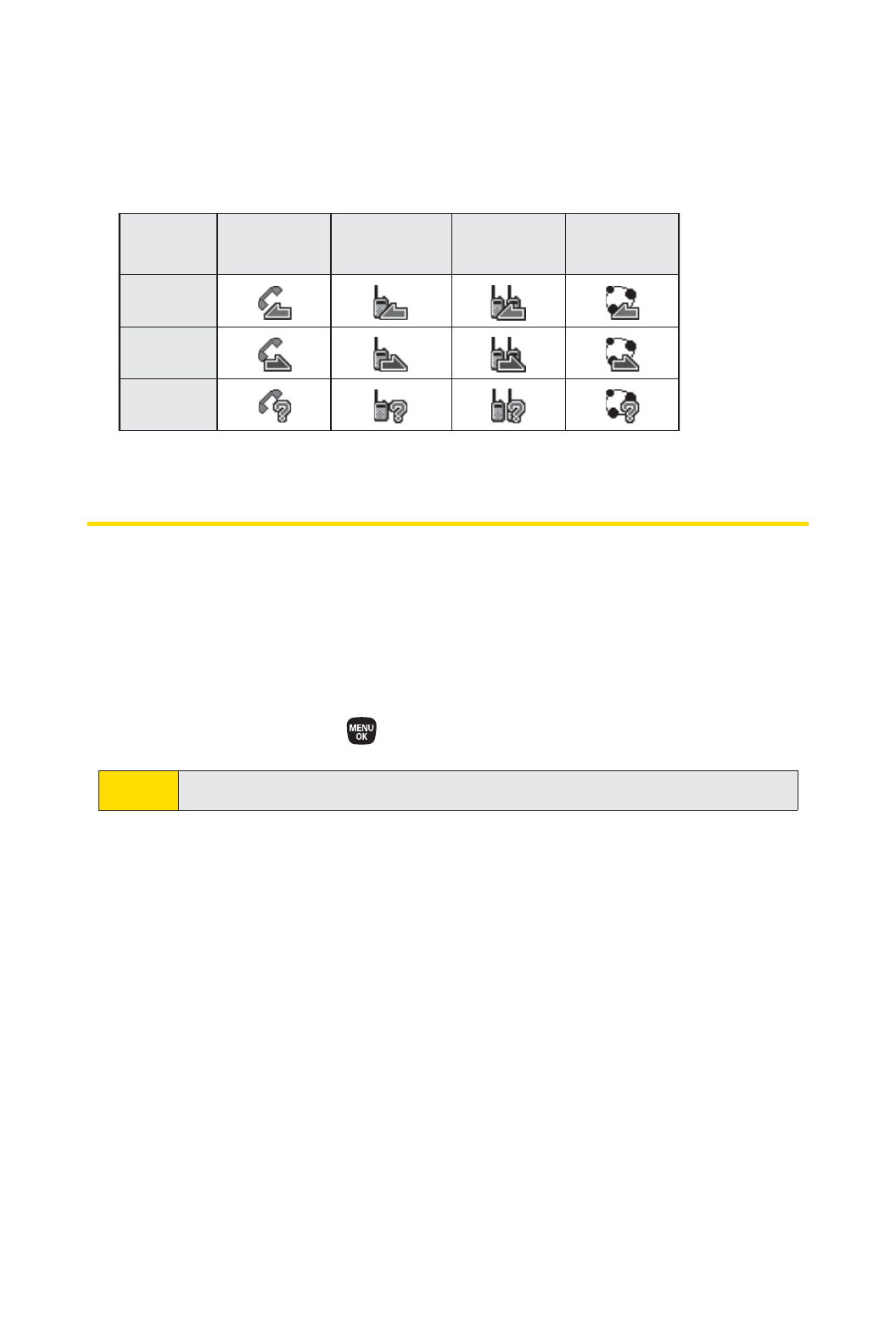
104 Section 2F: Managing History
History Icon Indication
You can define what type of call you placed, accepted, or
missed with icons shown below.
History Thread
The History thread screen shows all history of a selected
history entry.
To display a History thread:
䊳From the History display, select the entry you wish to
view and press .
Tip SMS messages are included in the History thread.
Phone Call
Direct Connect
Call (including
Call Alert)
Group
Connect
Call
Team DC
Call
Incoming
Outgoing
Missed
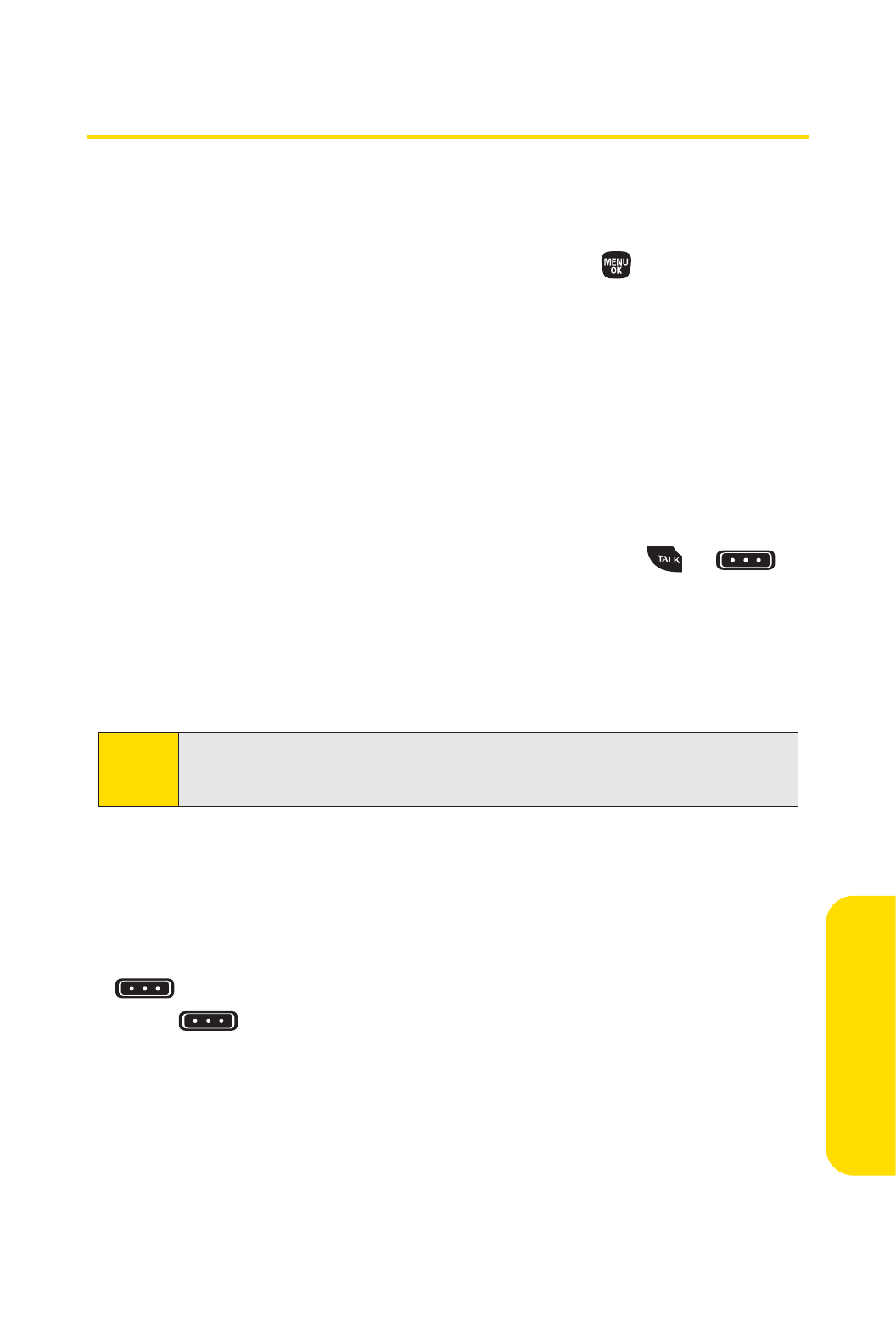
Section 2F: Managing History 105
History Details
To display History details:
䊳From a History thread display, select an entry for which
you wish to view the details and press .
History Details for Personal Phone or Direct
Connect Calls
The History details screen shows the call type, phone number,
domain name, and date and time of the call. An onscreen
menu is also displayed according to the type of call. See
“History Menu Options”on page 106.
To make a call from History details screen, press or .
History Details for Direct Connect Group Calls
The History details screen shows the group type, first caller
name, date and time of the call, and member list.
Highlight a group name, a member, or a phone number and
press Options (right softkey) to display the options menu. See
“History Menu Options”on the next page for menu details.
To make a group call, highlight the group name and press
.To make a call to a member, highlight the member and
press .
Note If you select a Team DC group, press Members (left softkey) to
shows the member list.
History

106 Section 2F: Managing History
History Menu Options
You may see several menu items on the onscreen menu or by
pressing Options (right softkey).
䢇Call to dial the phone number.
䢇Call:Speaker On to dial the phone number in speakerphone
mode.
䢇Save Contact to save a phone number. See “Saving a Phone
Number From History”on page 108.
Show Contact is displayed when the name and number is
already in your Contacts.
䢇Save Group to save a Group entry. Show Group is displayed
when a Group is already in your Contacts. See “Saving a
Group Connect From History”on page 108.
䢇Allow/Block DC Calls to allow or block a phone number for
Direct Connect calls. (See “Setting Direct Connect
Permissions”on page 54.)
䢇Prepend to add numbers to the beginning of a phone
number. (See “Prepending a Phone Number From
History”on page 109.)
䢇Delete to delete an entry. Delete All to delete all entries in
the History. See “Deleting History”on page 110.
䢇Send Message to send an SMSText message or an SMS
Voice message.
䢇Call Alert to send an alert to someone that you’d like to talk
with using a Direct Connect call. See “Using Call Alerts”on
page 53.
Note The menu displayed varies depending on the situation.

Section 2F: Managing History 107
䢇New Group to access a Group entry menu to create a new
Group Connect entry. (See “Making a New Group Connect
From History”on page 109.)
䢇Recent DC’s to display the Direct Connect call history.
䢇Rename to change an entry’s current name to Caller ID
name.
䢇Remove Me to remove yourself from the Team DC group.
See “To remove yourself from a Team DC group”on
page 122.
Making a Call From History
To make a phone call from History:
1. Press >History to display your History.
2. Use your navigation key to select an entry and press .
To make a Direct Connect call from History:
1. Press >History to display your history.
2. Using your navigation key, select the Direct Connect
number or Group you want to call.
3. Press and hold and proceed as if making a Direct
Connect call.
Note You cannot make calls from History to entries identified as
No Caller ID,Private, or Unavailable ID.
History

108 Section 2F: Managing History
Saving a Phone Number From History
Your phone can store up to 600 Contacts entries. Contacts can
store up to a total of 700 phone numbers.
To save a Contacts entry from History:
1. Highlight an entry in your History and press Options
(right softkey) > Save Contact.
2. Select New Entry to create a new Contacts entry for the
number or Existing Entry to save the number to an
existing entry.
3. If New Entry was selected, select a phone type, and then
use the numeric keypad to enter the new entry name
and press .
– or –
If Existing Entry was selected, select an existing entry to
which you want to save the number, and then select a
phone type and press .
4. Press Done (left softkey) to save the entry.
Saving a Group Connect From History
1. Select a Direct Connect group call entry in your History
and press Options (right softkey) > Save Group.
2. Enter a group name and use the keypad to complete or
edit the group entry.
3. Press Save (left softkey) to save.
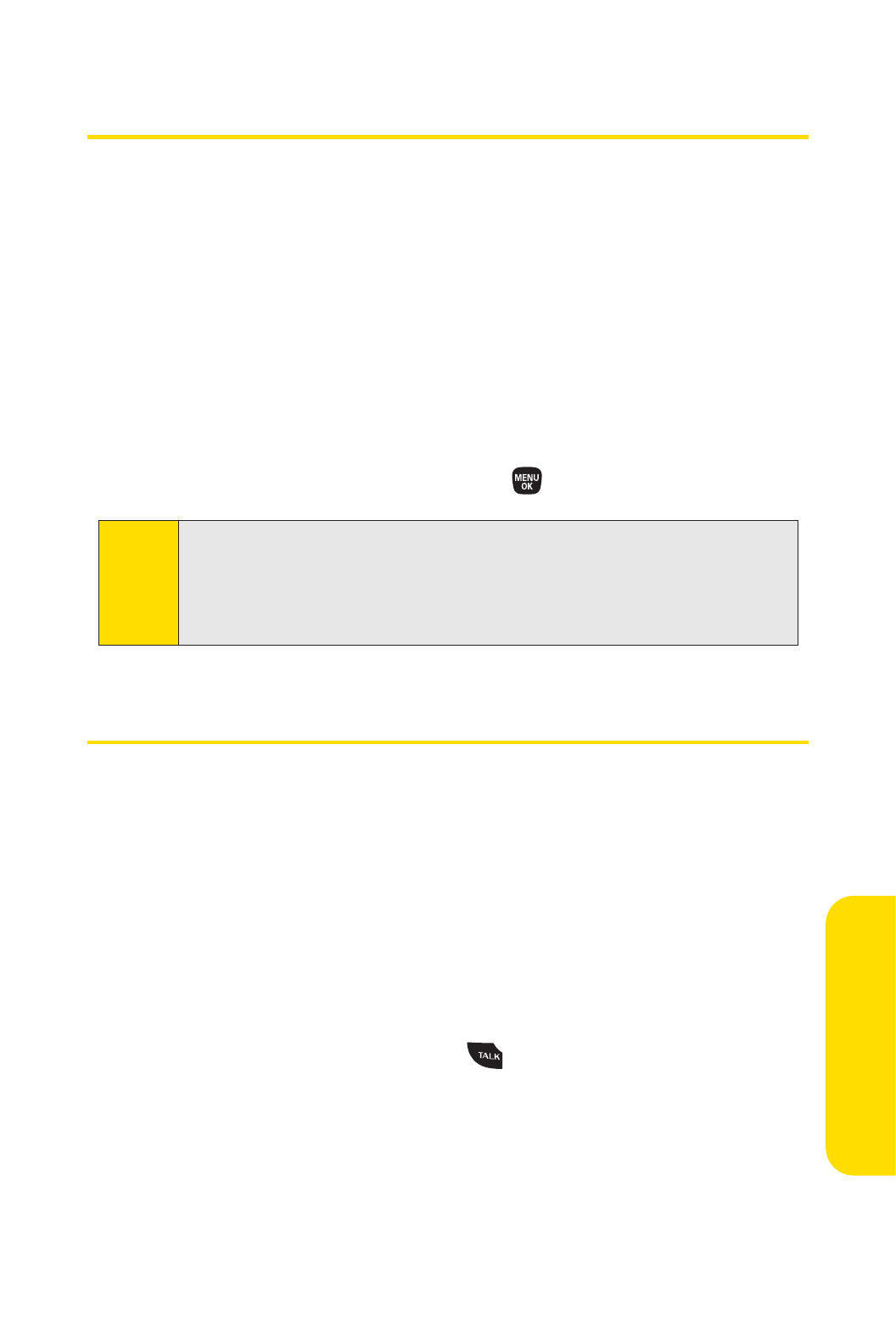
Section 2F: Managing History 109
Making a New Group Connect From History
You can make and save a new Group Connect entry from the
history.
1. From the History list display, press Options (right
softkey) > New Group.
2. Read the message and press Start (left softkey).
3. Select members by checking the check box and press
Continue (left softkey).
4. Enter a group name and press >Save(left softkey).
Prepending a Phone Number From History
If you need to make a call from History and you are outside
your local area code, you can add the appropriate prefix by
prepending the number.
To prepend a phone number from History:
1. Select an entry in your History and press Options (right
softkey)>Prepend.
2. Enter the prefix and press to call the number.
Note You can make a Direct Connect call only by checking the
desired members and pressing the Direct Connect key. Press
Options (right softkey) > Send Message during step 3 to send
message to the checked members.
History

110 Section 2F: Managing History
Deleting History
You can delete individual or all entries in your History using
the Options menu.
1. Press >History to display your History.
2. Select an entry you wish to delete and press Options
(right softkey) >Delete. (Select Delete All if you wish to
delete all entries in your History.)
3. If you are certain you want to delete the History, press
Delete (left softkey).

Section 2G: Using Contacts 111
Section 2G
Using Contacts
In This Section
⽧About Contacts (page 112)
⽧Displaying the Contacts List (page 113)
⽧Creating a New Contacts Entry (page 113)
⽧Finding Contacts Entries (page 115)
⽧Displaying the Details Screen (page 116)
⽧Editing a Contacts Entry (page 118)
⽧Contacts Menu Descriptions (page 122)
⽧Secret Contacts Entries (page 125)
⽧Dialing Sprint Services (page 126)
⽧Mobile Sync (page 127)
Your phone’s Contacts helps you stay in touch with family,
friends, and colleagues by keeping track of all their contact
information.This section explains how to use your phone’s
Contacts.
Contacts

112 Section 2G: Using Contacts
About Contacts
Your phone can store up to 600 Contacts entries. Contacts can
store up to 700 phone numbers, 1800 email addresses, and
600 Web addresses.
There are three types of Contacts entries to be used
depending on the situation.
䢇Personal Contacts Entry – An entry for an individual. Each
entry can contain up to seven phone numbers, three email
addresses, and one Web address.
䢇Group Connect Entry – A group entry that contains
Direct Connect Contacts entries. Your phone can store up
to 25 Group Connect entries, each with up to 40 members.
You can communicate with a maximum of 20 people in a
group simultaneously. Group Connect entries can be
created or edited easily from your phone whenever you
want.
䢇Team DC Entry – A group entry that contains Direct
Connect Contacts entries created by a server administrator.
You can communicate with everyone in the group
simultaneously.Your phone can store up to 40 Team DC
entries. Team DC calls will be terminated if you end your
Direct Connect call.
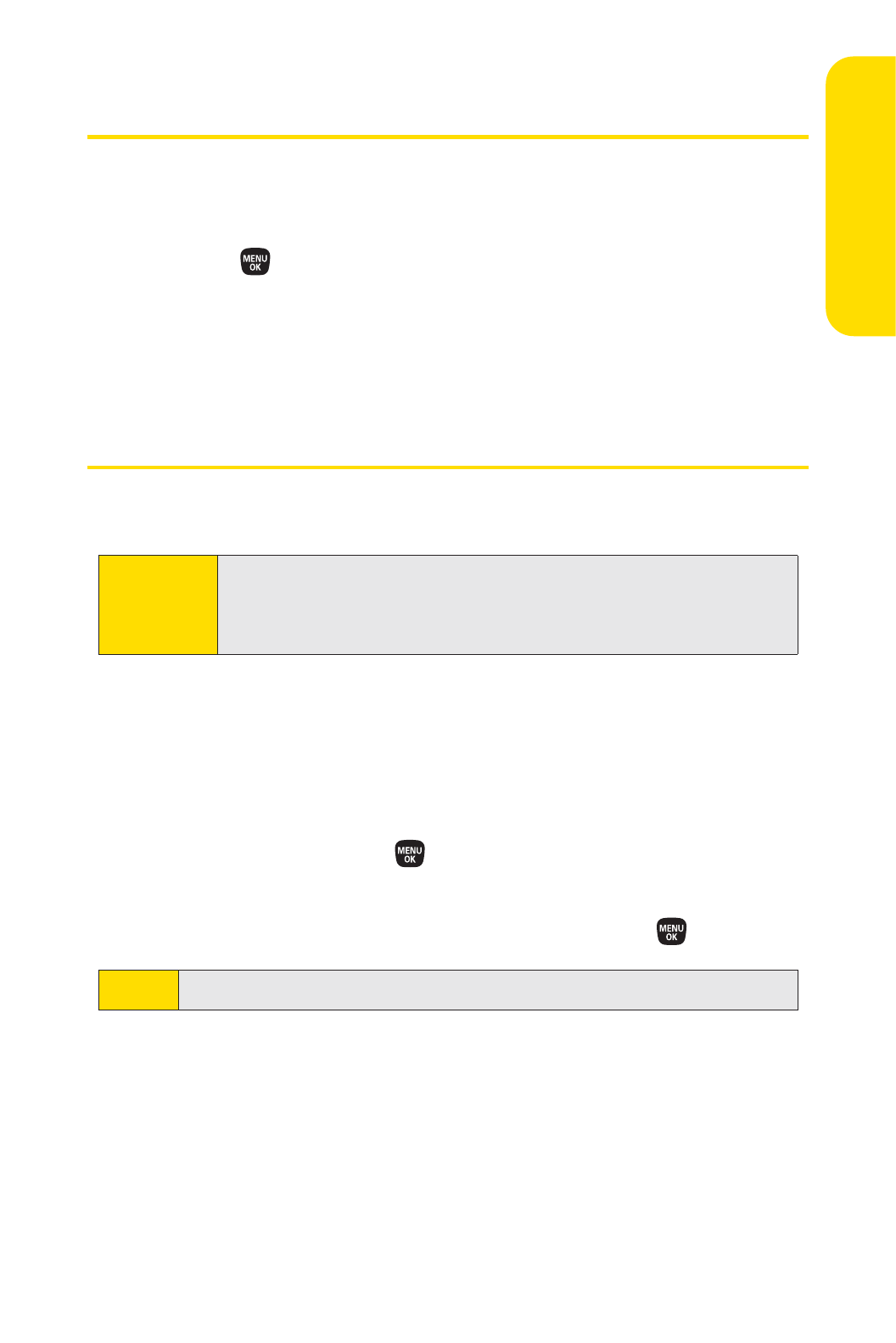
Section 2G: Using Contacts 113
Displaying the Contacts List
䊳PressContacts (right softkey).
– or –
Press >Contacts.
If you highlight a name, the main (default) phone number is
displayed. If a group entry is selected, a group icon (see page
112) and number of group members will also be displayed.
Creating a New Contacts Entry
Creating a Personal Contacts Entry
1. Press Contacts (right softkey) > Add New > New Contact.
2. Enter a name for the new entry and press the navigation
key down. (See “Entering Text”on page 29.)
3. Enter the phone number or Direct Connect number for
the entry and press .
4. Select a phone type for the entry (Mobile,Mobile + DC,
Home,Work,Pager,Fax, or Other) and press .
5. Press Done (left softkey).
After you have saved the number, the new Contacts entry is
displayed.
Note If you enter a Direct Connect number, select DC Only.
Shortcut Enter the phone number in standby mode and press MENU.
Proceed with steps 2-4 in “Saving a Phone Number”on
page 45.
Contacts

114 Section 2G: Using Contacts
Creating a Group Connect Entry
You can create a Group Connect entry by giving it a name and
assigning members to it who have Direct Connect phones.
To create a Group Connect entry:
1. Press Contacts (right softkey) > Add New > New Group.
2. Read the message and press Start (left softkey).
3. Scroll through the list and press after each selection.
(A check mark will appear in the box next to the selected
entry.)
4. When you’ve marked all the entries you want to add,
press Continue (left softkey).
5. Enter a name for the new group and press .
6. Press Save (left softkey) to save the group entry.
Note Ensure that each contact’s Direct Connect number is
displayed before selecting the contact. Otherwise, that
contact will not be included when you call the Group Connect
entry. If the contact’s Direct Connect number is not displayed,
press the navigation key left or right until you see the Direct
Connect number.
Tip ICE – In Case of Emergency
To make it easier for emergency personnel to identify
important contacts, you can list your local emergency
contacts under “ICE”in your phone’s Contacts list. For
example, if your mother is your primary emergency contact,
list her as “ICE–Mom”in your Contacts list. To list more than
one emergency contact, use “ICE1–___,”“ICE2–___,”etc.

Section 2G: Using Contacts 115
Finding Contacts Entries
There are several ways to display your Contacts entries: by
name, by speed dial number, by group, and by voice dial tags.
Follow the steps outlined in the following sections to display
entries from the Contacts menu.
Finding Contacts by Name
1. Press Contacts (right softkey).
2. Scroll through all the entries.
– or –
Enter the first letter of a name or part of a name. (The
more letters you enter, the more your search narrows.)
3. To display an entry, select it and press .
Finding Contacts by Voice Dial Tag
1. Press and hold or with the phone open.
– or –
Press and hold the side call key with the phone closed.
2. Say the voice tag of the Contacts entry you would like to
find. If the phone partly recognizes the name, a list of up
to three of the most likely names is displayed. You will
hear the voice prompt “Did you say…”followed by the
matched name.
3. Say “Yes”if you confirm the name, or “No”to change the
selection.
Contacts

116 Section 2G: Using Contacts
Finding Group Entries
To find entries designated as part of a group:
1. Press Contacts (right softkey).
2. Scroll through the group entries using your navigation
key. To display Contacts entries belonging to a group,
highlight the group and press .
3. To dial the entry’s default phone number, select the
entry and press .
Finding Speed Dial Numbers
1. Press > Settings > More... > Contacts > Speed Dial #’s.
2. Scroll through speed dial entries. Speed dial numbers
are displayed in numeric order.
3. To dial the phone number assigned to a speed dial
number, press .
Displaying the Details Screen
To display the details screen:
䊳From the Contacts list, select a Contacts entry for which
you would like to see the details and press .
Highlight any information and press . You will see onscreen
menu options for the information displayed.
If you select a group entry, entries or phone numbers
belonging to the group entry are displayed. Press Options
(right softkey) to display the menu options.
For details of each menu, see “Contacts Menu Descriptions”
on page 122.

Section 2G: Using Contacts 117
Viewing History from Contacts
You can view the history of the selected Contacts entry from
the Contacts list.
䊳Highlight the entry and press Options (right softkey) >
Contact History.
If you select a Group entry, Group History appears.
Setting a Domain Name
Domains for Direct Connect calls are similar to those for email
addresses. You can set a Domain name for a Contacts entry as
follows:
1. From the Contact Details screen, highlight any number
for which you would like to set a domain name and
press .
2. Select Set DC Domain.
3. Select an entry method to set the domain name and
press .
4. Follow the onscreen prompts to complete.
If Direct Connect is provisioned, three types of domain names
(for personal Direct Connect calls, for Group Connect calls, and
for Team DC calls) are provided with your phone.
If the domain name of the Contacts entry is same as your
domain name, and the number can be used for Direct Connect
calling, DC capable is displayed. If the number cannot be used
for Direct Connect calling, nothing will be displayed.
Once a number is used for a Direct Connect call or a Call Alert,
the number is marked as DC capable.
Contacts

118 Section 2G: Using Contacts
Editing a Contacts Entry
Adding a Phone Number to a Personal Contacts Entry
1. Press Contacts (right softkey).
2. Use your navigation key to select an entry and press .
3. Press Options (right softkey) >Edit.
4. Scroll down to highlight <Add Number> and enter the
new phone number and press .
5. Select a phone type for the number and press .
Adding Group Members to the Group Connect
You can add a group member to an existing Group Connect
entry. Each group can include up to 40 members. You can enter
a group member directly or select the member from your
Contacts or History.
1. Display a Contacts list and scroll to the group you want
to add members to and press .
2. Press Options (right softkey) > Edit Group.
3. Highlight Add More and press .
4. Read the message and press Start (left softkey).
5. Highlight each member you want to add and press
after each selection. (A check mark will appear in the box
next to the selected member.)
6. Press Continue (left softkey) to save the membership.
7. Press Save (left softkey) again to save the entry.
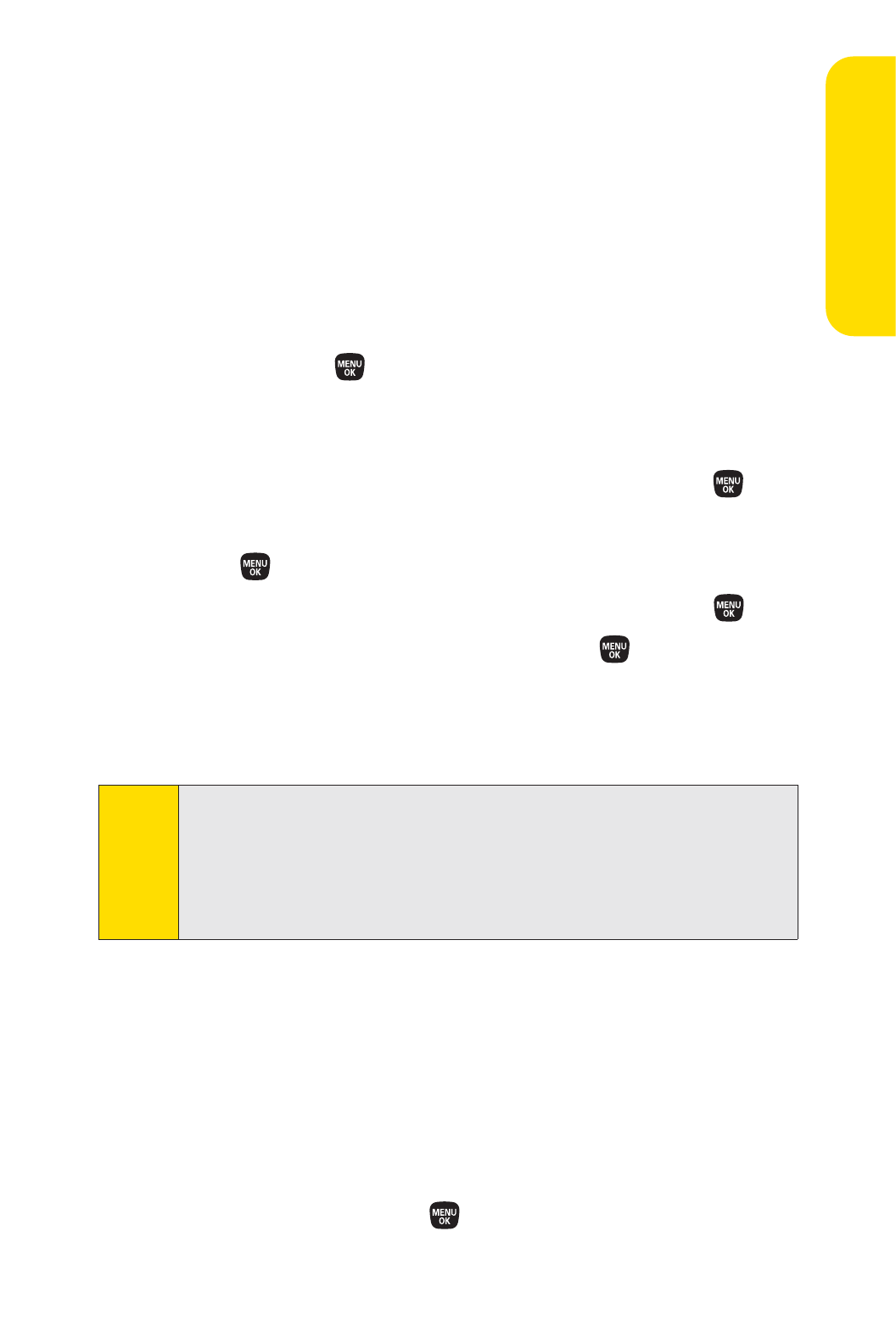
Section 2G: Using Contacts 119
Assigning Speed Dial Numbers
Your phone can store up to 98 phone numbers in speed dial
locations. (For details on how to make calls using speed dial
numbers, see “Using Speed Dialing”on page 49.)
To assign a speed dial number:
1. From the Contacts list, select a Contacts entry that has a
phone number to which you would like to assign a speed
dial and press .
2. Highlight the number and press Options (right softkey) >
Set Speed Dial.
3. Select an available speed dial location and press .
– or –
1. Press > Settings > More... > Contacts > Speed Dial #’s.
2. Select an available speed dial location and press .
3. Select an entry from the list and press . The entry’s
default phone number is assigned.
䡲To select another phone number of the entry, press
the navigation key right or left.
Editing a Contacts Entry’s Information
To edit a personal Contacts entry’s information:
1. Display the Contacts list and highlight the entry you
wish to edit.
2. Press Options (right softkey) > Edit Contact .
3. Select the field you wish to edit, and then add or edit the
information and press .
Note If you attempt to assign an already in-use speed dial location
to a new phone number, a message will appear asking if you
wish to replace the existing speed dial assignment. Select
Replace to assign the location to the new phone number and
delete the previous speed dial assignment.
Contacts
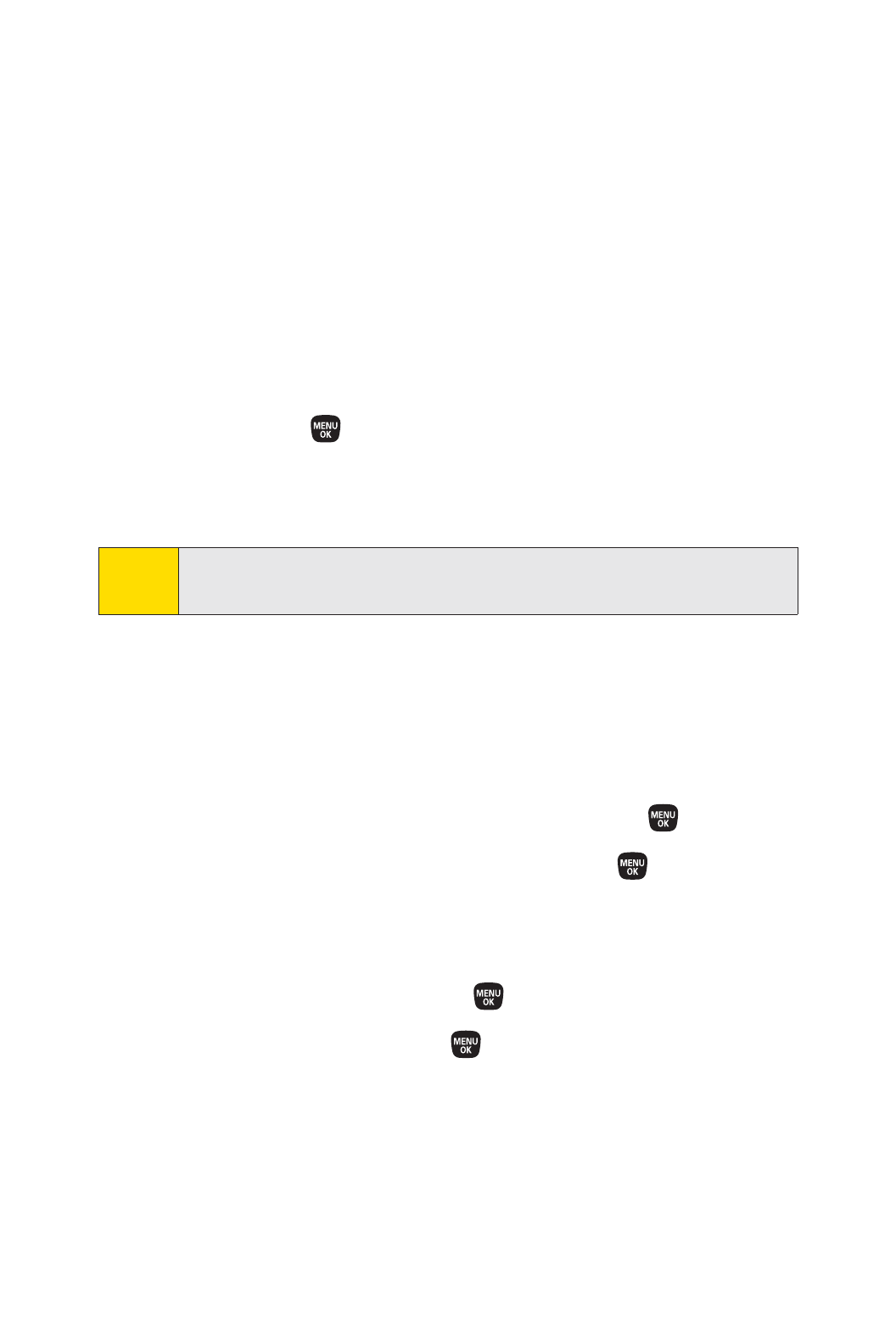
120 Section 2G: Using Contacts
To edit a Group entry:
You can change the group name or the image, or add new
member to the group.
1. Display a Contacts list and scroll to the group you want
to edit.
2. Press Options > Edit Group.
3. Change the group name or the image, or select Add More
to add a new member and press Start (left softkey).
䡲Use the key to check the box next to the member
and press Continue (left softkey) when you are done.
4. Press Save (left softkey) to save your changes.
Selecting a Ringer Type for a Personal Contact Entry
Assign a ringer type to a Contacts entry so you can identify the
caller by the ringer type. (See “Ringer Types”on page 60.)
1. From the Contacts list, select a Contacts entry to which
you would like to assign a ringer and press .
2. Select the current ringer type and press to display the
Ringer menu.
3. Select Change.
4. Select an option and press .
5. Select a ringer and press .
Note You cannot add members to a Team DC group from your
phone.

Section 2G: Using Contacts 121
Assigning an Image to a Contacts Entry
You can assign an image to a Contacts entry. The image is
displayed when the entry calls you.
1. From the Contacts list, select a Contacts entry to which
you would like to assign an image and press .
2. Press the navigation key to highlight the icon and
press .
3. Select Select Photo.
4. Select an option and press .
5. If you select Downloads, select an image and press ,
and then press OK (left softkey) to assign.
Deleting a Contacts Entry
To delete a personal Contacts or a group entry:
1. Display the Contacts list and highlight an entry you wish
to delete.
2. Press Options (right softkey).
3. Select one of the following options and press .
䡲Delete Contact to delete a personal Contacts entry.
䡲Delete Group to delete a Group Connect entry.
䡲Delete from Contacts to delete a Team DC entry.
4. Press Yes (left softkey).
Contacts
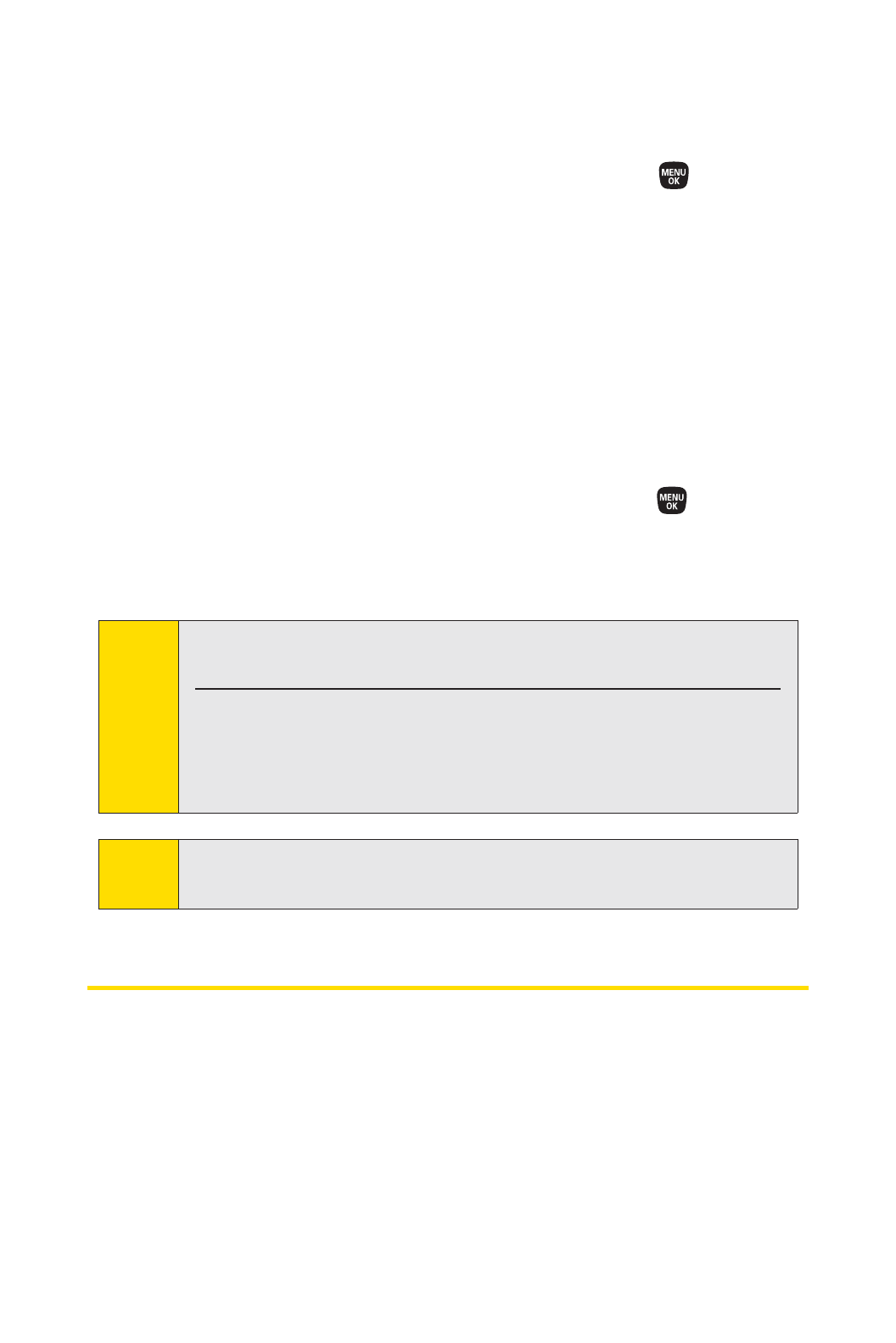
122 Section 2G: Using Contacts
To remove a group member from a Group Connect entry:
1. Display the Contacts list and scroll to the group you
want to delete the member from and press .
2. Press Options (right softkey) > Edit Group.
3. Highlight the member you want to delete and press
Options (right softkey) > Remove from Group > Yes (left
softkey).
4. Press Save (left softkey).
To remove yourself from a Team DC group:
1. Display the Contacts list and scroll to the Team DC group
you want to delete yourself from and press .
2. Press Options (right softkey) > Remove Me.
3. Press Remove (left softkey) > Done (left softkey).
Contacts Menu Descriptions
You may see several menu items on the onscreen menu or by
pressing Options (right softkey).
On the Contacts List:
䢇NewGroup to create a new Group Connect entry. See
“Creating a Group Connect Entry”on page 114.
Tip To delete all the Contacts entries saved in your phone, see
“Deleting Phone Content”on page 91.
Note This action also deletes the Team DC group you belonged to
from your Contacts.
Team DC group membership can either be forced or non
forced. With a forced Team DC group, an end user on the same
account cannot be removed from the group,whereas a user
not on the same account can.

Section 2G: Using Contacts 123
䢇Edit Contact to edit the selected Contacts entry. Edit Group
appears if a group entry is selected. See “Editing a
Contacts Entry”on page 118.
䢇Delete Contact to delete the selected Contacts entry.
Delete Group appears if a Group Connect entry is selected.
See “To delete a personal Contacts or a group entry”on
page 121.
䢇Remove Me to remove yourself from the selected Team DC
group. See “To remove yourself from a Team DC group”on
page 122.
䢇Delete from Contacts to delete the selected Team DC group
from your Contacts. See “To delete a personal Contacts or
a group entry”on page 121.
䢇Contact History to display the selected Contacts entry’s
history. Group History appears if a group is selected. See
“Viewing History from Contacts”on page 117.
䢇Send Message to send a text or VoiceSMS message to the
selected Contacts entry.
䢇Send Contact to send the selected Contacts entry via
Bluetooth.
䢇Set as Secret to make the selected entry secret. See “Secret
Contacts Entries”on page 125.
䢇Show Corp Contacts/Hide Corp Contacts to display or hide a
Corp Contacts in your Contacts.
䢇ListTeamDC Groups to display the list of the Team DC group.
䢇Settings to display the Settings menu.
䢇Print to print the selected Contacts entry’s information.
䢇Allow/Block DC Calls to allow or block the phone number
for Direct Connect calls. (See “Setting Direct Connect
Permissions”on page 54.)
Contacts

124 Section 2G: Using Contacts
On the Details screen only:
䢇Prepend to alter a phone number by adding numbers to
the beginning of the entry. (See “Prepending a Phone
Number From History”on page 109.)
䢇Delete # to delete the selected phone number.
䢇Set as Main # to set the selected number as the main
(default) number for the Contacts entry.
䢇Call Alarm to set Call Alarm to the selected phone number.
䢇Set Speed Dial to assign Speed Dial to the selected phone
number.
䢇SetVoice Tag to set a voice tag to the selected phone
number.
On the Group Details screen only:
䢇Save Contact to save the selected entry to your Contacts.
Contact Details appears if the entry is already saved in your
Contacts.
Onscreen menu only:
䢇Call to call the selected phone number.
䢇Call Alert to send Call Alert to the selected phone number.
(See “Using Call Alerts”on page 53.)
䢇Set # Type to select number type (mobile, home, etc.)
䢇Set DC Domain to set the Direct Call domain name. See
“Setting a Domain Name”on page 117.
䢇Launch to connect to the selected URL (if URL is selected).
䢇Set as Favorite to set the selected URL as My Favorite
(if URL is selected).
䢇Edit to edit the selected information.
䢇Clear to erase current memo or address.

Section 2G: Using Contacts 125
Secret Contacts Entries
You can hide an entry by making it secret. The entry is not
displayed in your Contacts. In History, a telephone number is
displayed but the Contacts entry’s name is not.
To make an entry secret:
1. From the Contacts list, highlight the Contacts entry you
want to tag as secret.
2. Press Options (right softkey) > Set as Secret.
3. Select On.
4. From the Contacts list, press Options (right softkey) >
Settings > Hide Secret.
5. Enter the four-digit lock code.
To make an entry public:
1. From the Contacts list, press Options (right softkey) >
Settings > Show Secret.
2. Enter the four-digit lock code.
Tip If you can’t recall your lock code, try using the last four digits of
your wireless phone number. If this doesn’t work, call Sprint
Customer Service at 1-800-SPRINT1 (1-800-777-4681).
Note If you make an entry secret, calls cannot be made to that entry
if Contacts Only is selected in Settings > More... >
Restrict and Lock > Voice > Restrict > Outgoing Calls.
Contacts

126 Section 2G: Using Contacts
Dialing Sprint Services
Your Contacts list is preprogrammed with contact numbers
for various Sprint services.
To dial a service from your Contacts:
1. Press > Settings > More... > Contacts > Services.
2. Select Customer Service,Dir Assistance (Sprint 411),
Account Info,Sprint Operator, or Voice Command.
3. Press to place the call.
To dial a service from standby mode using your keypad:
1. Dial the appropriate service number:
䡲Customer Service –
䡲Sprint 411 –
䡲Account Info –
䡲Sprint Operator –
䡲Voice Command –
2. Press to place the call.
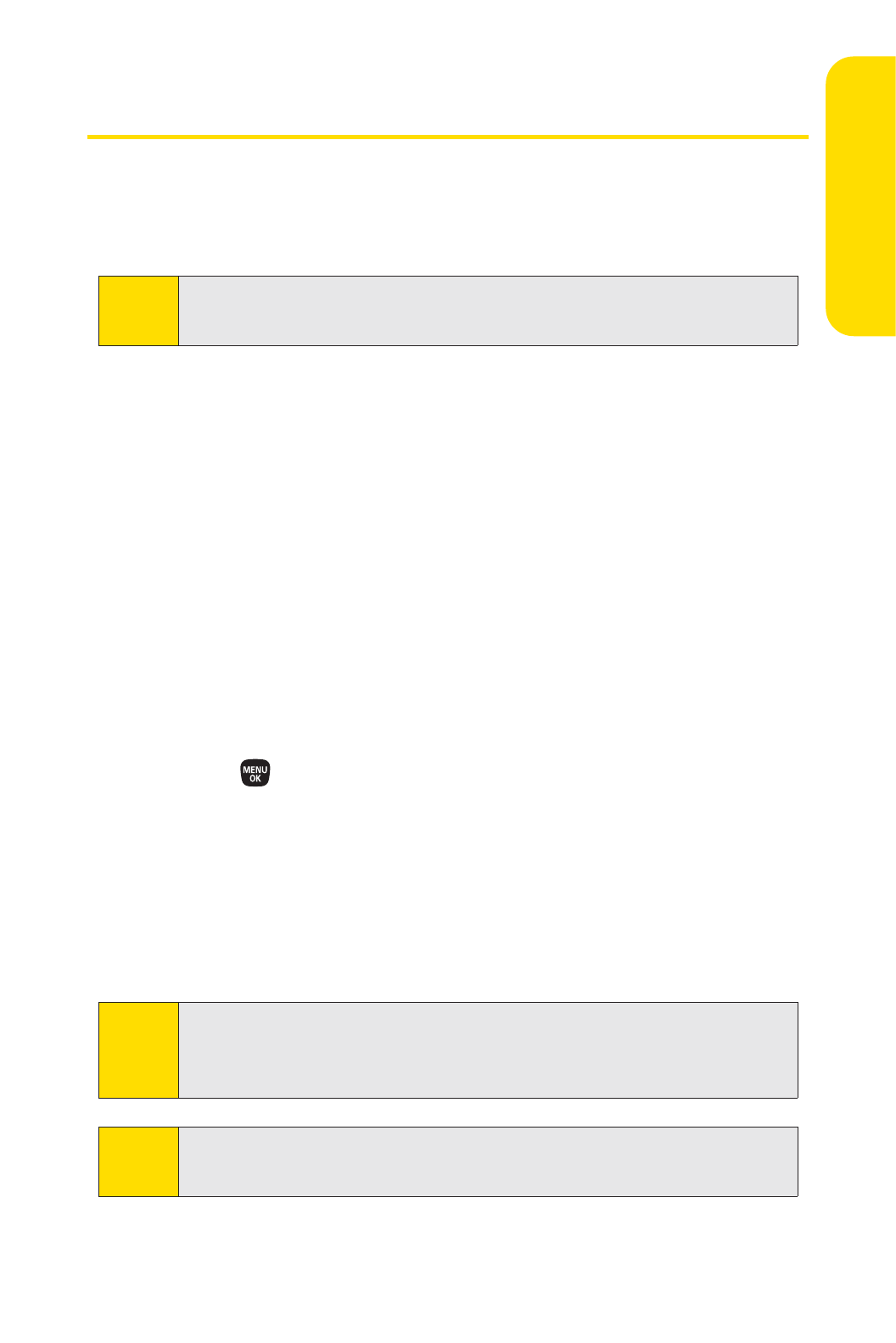
Section 2G: Using Contacts 127
Mobile Sync
This feature allows you to back up all of your contacts to the
Sprint Web site and restore them if your phone is lost, stolen,
damaged, or replaced.
To subscribe to the Mobile Sync service, you will need to
purchase a license to use the Mobile Sync service through your
phone’s browser. The license expires after a set period of time
and must be renewed regularly. As part of the initial
subscription process, a random Mobile Sync password is
generated. The randomly-generated password will be sent to
your phone as an SMS text message. (Subscribe launches the
subscription process. If you are already subscribed to Mobile
Sync service, Unsubscribe will be displayed.)
Activating and Deactivating Mobile Sync Service
To activate the Mobile Sync service:
1. Press > Settings > More... > Mobile Sync. (You will be
prompted to confirm your license status.)
2. Press Subscribe (left softkey) and follow the onscreen
instructions to purchase the license.
3. Please wait while registering the license. (You will see a
confirmation screen if it has been registered.)
Tip Each time you edit the contacts on your phone, they are
backed up online.
Note Once you have completed the registration, you will receive an
SMS text message with your password, which is required
when you access Sprint Mobile Sync online.
Tip To use the Mobile Sync service, you are required to activate the
service from your phone.
Contacts

128 Section 2G: Using Contacts
To deactivate the Mobile Sync service:
1. Press > Settings > More... > Mobile Sync > Unsubscribe.
(A message will be displayed.)
2. Follow the onscreen instructions to unsubscribe from
the Mobile Sync service.
Viewing Your Mobile Sync Status
1. Press > Settings > More... > Mobile Sync > View Status.
2. Press OK (left softkey).
Setting the Mobile Sync Alert
This feature turns the pop-up alert on or off when a Mobile
Sync is in progress.
1. Press > Settings > More... > Mobile Sync > Alert.
2. Select Alert me or No alerts.
Accessing Sprint Mobile Sync Online
To access Sprint Mobile Sync:
1. Sign on to your MySprint page at www.sprint.com.
2. Click My Online Tools > Sprint Mobile Sync, and then select
My Contacts.
3. Follow the onscreen instructions to add, edit, and
manage all your contact information.
Tip To display Mobile Sync service information, press MENU >
Settings > More... > Mobile Sync > Learn More.When the service
is available, you can also select Troubleshoot to display the
troubleshooting guide.
Note You can unsubscribe from the Mobile Sync service only
through the Sprint Web site.

Section 2H: Using the Phone’s Calendar and Tools 129
Section 2H
Using the Phone’s Calendar and Tools
In This Section
⽧Using Your Phone’s Calendar (page 130)
⽧Using Your Phone’s Tools (page 136)
⽧Personal Information Management (page 139)
Your phone is equipped with several personal information
management features that help you manage your busy
lifestyle.This section shows you how to use these features
to turn your phone into a time management planner that
helps you keep up with your contacts, schedules, and
commitments.
Calendar andTools

130 Section 2H: Using the Phone’s Calendar and Tools
Using Your Phone’s Calendar
Adding an Event to the Calendar
Your Calendar helps organize your time and reminds you of
important events.
1. Press >Tools > Calendar to display your calendar.
2. Select the day to which you would like to add an event
and press Options (right softkey)> Add Schedule.
3. Enter a description using your keypad and press .
4. Select the following items you want to set and press .
䡲Description to change the description you just
entered.
䡲Category to select an event category (Appointment,
Business,Meeting,Personal,Vacation,Travel,or
Miscellaneous).
䡲Priority to select an event priority (None,High,or
Low).
䡲Start to schedule a start time for the event. Use your
keypad or navigation key to set the hours, minutes,
and AM or PM.
䡲End to schedule an end time for the event. Use your
keypad or navigation key to set the hours, minutes,
and AM or PM.
䡲Location to add a location for the event.
䡲Alarm to select a ringer type for the alarm.
䡲Alarm Time to edit the alarm time (number of hours
or minutes before the event starts). The default
alarm time is 10 minutes before an event.
Tip To change the calendar display views, press the left softkey
(Monthly or Weekly). In the weekly view, you can easily add or
edit your own schedule.

Section 2H: Using the Phone’s Calendar and Tools 131
䡲Repeat to select a repeating status for the event
(Once,Daily,Weekly,Monthly, or Yearly).
5. Press Save (left softkey) to save the event.
Event Alert Menu
When your phone is turned on and you have an event alarm
scheduled, your phone alerts you and displays the event
summary.
There are several ways your phone alerts you to
scheduled events:
䢇By playing the assigned ringer type.
䢇By illuminating the backlight.
䢇By flashing the LED.
To silence the alarm and reset the schedule, press any key.
To view additional options, press the appropriate key:
䢇Dismiss (right softkey) clears the event alert.
䢇Press and hold the side end key ( ) to cancel snooze
mode.
Viewing a Day’s Events
1. Press >Tools > Calendar.
2. From the monthly view, select the day for which you
would like to view events and press . (If you have
events scheduled for the selected day, they will be listed
in chronological order.)
3. To display an event’s details, highlight it and press .
Tip In the monthly view, days with events scheduled are indicated
by a small 䊳just to the left of the date.
Calendar andTools

132 Section 2H: Using the Phone’s Calendar and Tools
Changing the Calendar Settings
This setting allows you to change the default settings for your
phone’s calendar. You can customize the calendar display
according to your needs.
1. From the calendar display, press Options (right softkey) >
Settings.
2. Select one of the following options and press .
䡲Holiday to add or reset a holiday on the calendar
(Set Date,SetWeekly,Reset Date,ResetWeekly, or
Reset All).
䡲Display to change the display settings of the
calendar (Calendar View,Monthly View, or
Time Starts at).
䡲Alarm to change the alarm settings of the calendar
(Ringer Length,SnoozeInterval, or SnoozeTimes).
3. Use your navigation key to change the settings and
press .
Going to a Specified Date
To use the Calendar menu to get to a specified date:
1. Press >Tools > Calendar > Options (right softkey) >
Go to Date.
2. Enter the date you wish to go to using the navigation key
or the keypad and press .
Deleting a Day’s Events
1. Press >Tools > Calendar.
2. Select the day for which you would like to delete events
and press .
Tip In the monthly view, days with events scheduled are indicated
by a small 䊳just to the left of the date.
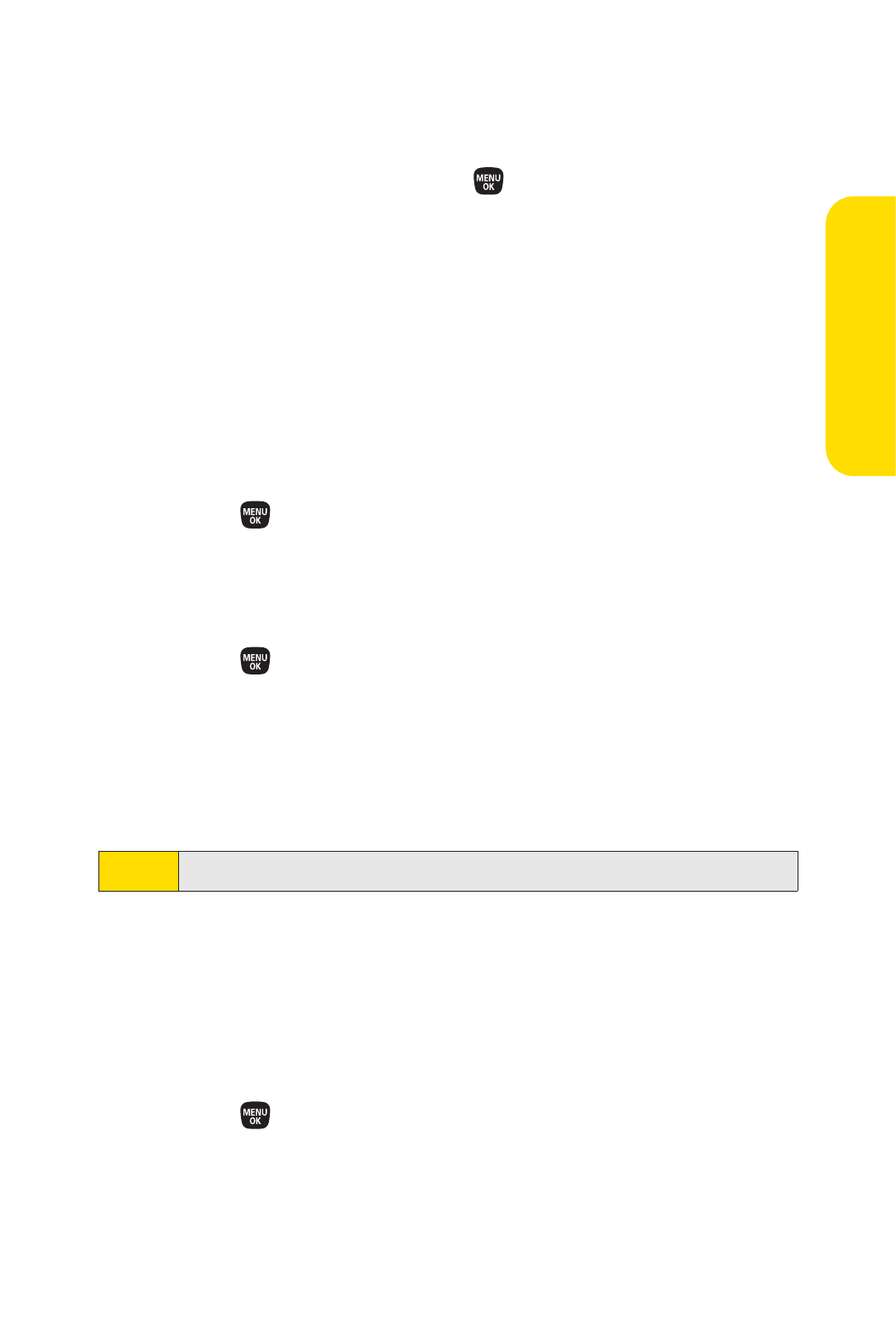
Section 2H: Using the Phone’s Calendar and Tools 133
3. Highlight one of the events and press Options (right
softkey) >Delete.
4. Select an option and press .
䡲This to delete a single event.
䡲Select to delete selected events at one time.
䡲All on This List to delete all events on the list.
5. Press Yes (left softkey) to delete the event(s).
Deleting Old Events
To delete events scheduled before a specific time and date:
䊳Press >Tools > Calendar > Options (right softkey)>
Delete Memory > Delete Old > Yes (left softkey).
Deleting All Events
1. Press >Tools > Calendar > Options (right softkey)>
Delete Memory > Delete All > Yes (left softkey). (An alert
will be displayed asking you to confirm the deletion.)
2. Press Yes (left softkey)to delete all events or No (right
softkey) to cancel.
Adding a Call Alarm to the Calendar
You can set call alarms to notify you when you need to place a
call. The call alarm will let you know when and to whom to
place a scheduled call. You can set up to 15 call alarms.
1. Press >Tools > Calendar.
2. Select the day to which you want to add a call alarm and
press Options (right softkey).
Note All events are deleted including Call Alarms and To Do events.
Calendar andTools

134 Section 2H: Using the Phone’s Calendar and Tools
3. Press the navigation key left or right to select
Add Call Alarm.
4. Enter the phone number directly or press Options (right
softkey) > From Contacts or Voicemail.
5. Select the following items you want to edit and press .
䡲Category to select a category for the call alarm
(Appointment,Business,Meeting,Personal,Vacation,
Travel, or Miscellaneous).
䡲Time/Date to edit the start time and date.
䡲Alarm to select the ringer alarm.
䡲Repeat to set the Call Alarm’s repeat status (Once,
Daily,Weekly,Monthly, or Yearly).
6. Press Save (left softkey) to save the call alarm.
Adding To Do List Items
Your phone can store and manage up to 40 To Do List items.
1. From the Calendar display, press Options (right softkey).
2. Press the navigation key left or right to select Add To Do,
and then press .
3. Enter the description using your keypad and press .
4. Select an option you want to edit and press .
䡲Category to select an event category (Appointment,
Business,Meeting,Personal,Vacation,Travel,or
Miscellaneous).
䡲Priority to select an event priority (None,High,or
Low).
䡲Due Time/Date to schedule a due time and date.
䡲Status to select a status for the To Do items
(Needs Action or Completed).
5. Press Save (left softkey) to save the To Do items.

Section 2H: Using the Phone’s Calendar and Tools 135
Adding a To Do List Item to the Schedule
1. From the Calendar display, press Options (right softkey).
2. Highlight Schedule List and press the navigation key left
or right and select To Do List.
3. Select the item you want to add to the schedule, and
press Options (right softkey) > Add to Schedule.
4. Modify the description field (if desired), and set the
other fields using your keypad and press . (See
“Adding an Event to the Calendar”on page 130.)
5. Press Save (left softkey).
Calendar andTools
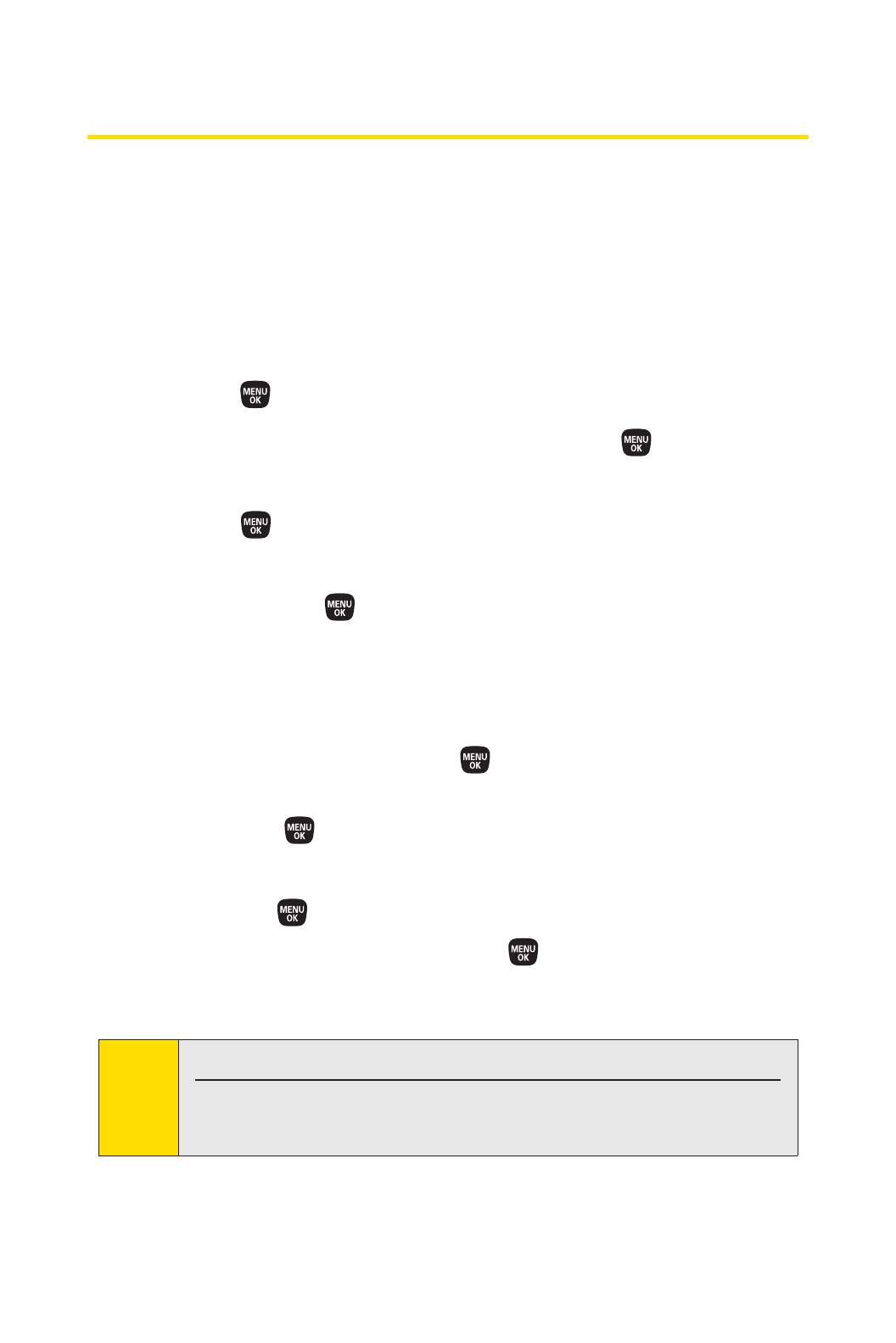
136 Section 2H: Using the Phone’s Calendar and Tools
Using Your Phone’s Tools
In addition to helping you be more efficient and organized,
your phone offers useful and entertaining tools.
Using the Alarm Clock
Your phone comes with a built-in alarm clock that has
multiple alarm capabilities.
1. Press >Tools > Alarm Clock.
2. Select an alarm clock number and press .
3. Enter the alarm clock description using the keypad and
press .
4. Select a time for the alarm by selecting the Time field
and pressing .
䡲Using your keypad or navigation key, set the hours,
minutes, and AM or PM.
5. Select a repeat status for the alarm by selecting the
Repeat field and pressing .
䡲Highlight Once,Daily,Mon – Fri, or Sat and Sun and
press .
6. Turn the alarm on or off by selecting the Alarm field and
pressing .
䡲Select On or Off and press .
7. Press Save (left softkey) to save the alarm settings.
Tip Press the left softkey (On or Off) to toggle the alarm on and off.
To change the alert settings, press Settings (right softkey) to
set the ringer length and snooze options.
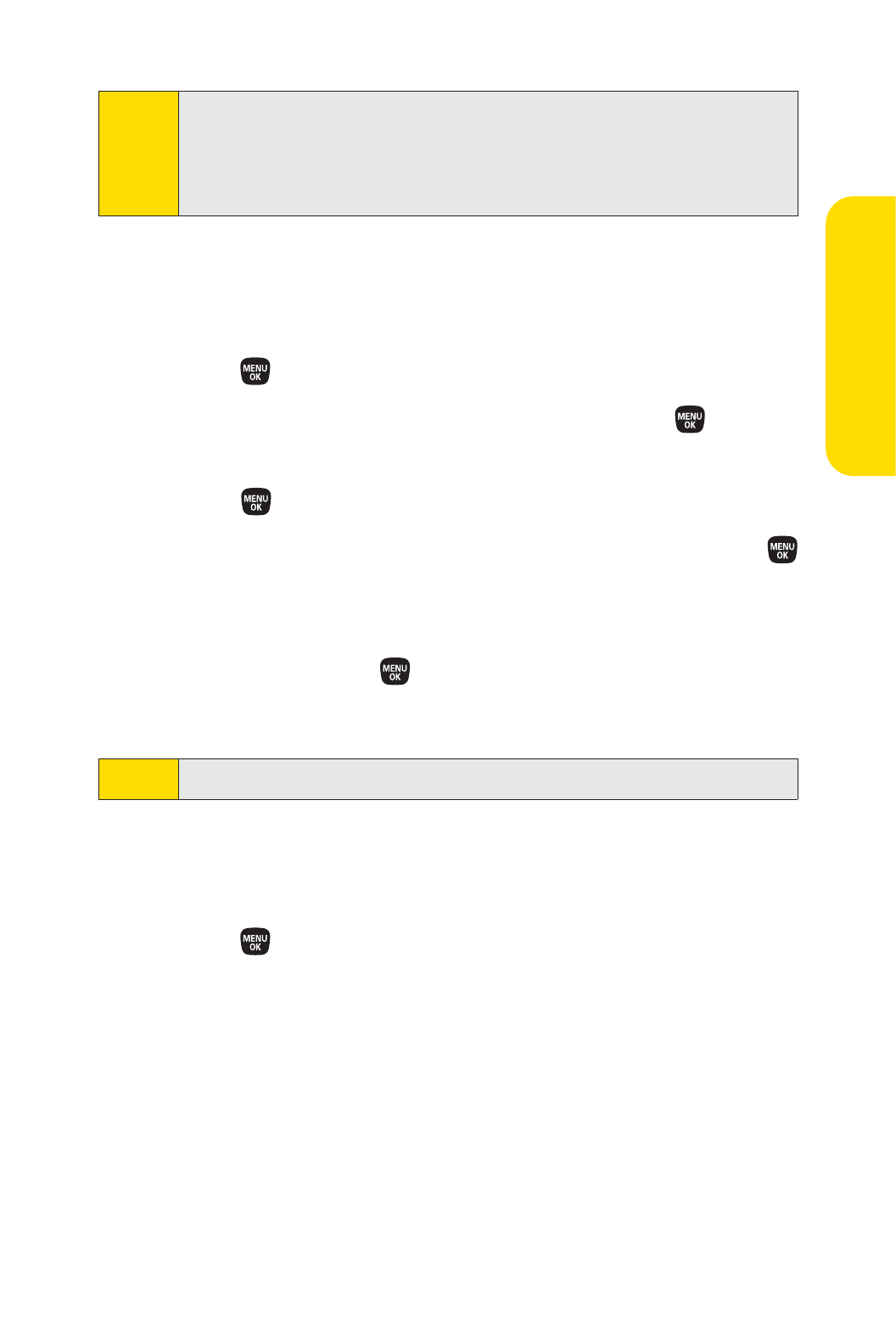
Section 2H: Using the Phone’s Calendar and Tools 137
Using the Countdown Timer
This feature allows you to use the countdown timer with
alarm capabilities. You can set up to five timers.
1. Press >Tools > Countdown.
2. Select a countdown timer number and press .
3. Enter the countdown description using the keypad and
press .
4. Select a time by highlighting the Time field and press .
䡲Using the keypad, enter the countdown time.
5. Turn the countdown on or off by selecting the Alarm
field and pressing .
6. Press Save (left softkey) to save the countdown settings.
Using the Stopwatch
To use the stopwatch:
䊳Press >Tools > Stopwatch.
䡲Use the left softkey Start/Stop/Resume for the
stopwatch operation.
䡲While the stopwatch is running, press Lap (right
softkey) for the lap time.You can record up to five lap
times.
Note This feature is not available while your phone is turned off.
Note The alarm will not sound when the phone is powered off.
However, depending on the Power On to Alert setting, the
alarm setting will be active even if the phone is turned off.
(See “Setting Power On to Alert”on page 82.)
Calendar andTools

138 Section 2H: Using the Phone’s Calendar and Tools
To display the stopwatch options:
䊳From the stopwatch display, press Options (right
softkey).
䡲Go to Lap List to display a saved Lap List. Press Detail
(left softkey) to display the Lap List detail.
䡲Save to Lap List to save the recorded lap times (not
available when no lap time is saved).
䡲Reset to reset the time to zero and clear any recorded
lap times.
Using the Calculator
Your phone comes with a built-in calculator.
1. Press >Tools > Calculator.
2. Enter numbers using your keypad.
䡲Press the appropriate navigation key for an
arithmetic option ( ).
䡲Press the left softkey to enter decimal points.
䡲Press CLR (right softkey) to clear all numbers.
3. Press for the result.
Using the World Clock
To view the time in different locations:
1. Press >Tools > World Clock.
2. Press the navigation key left or right to scroll through
different time zones.

Section 2H: Using the Phone’s Calendar and Tools 139
Personal Information Management
Displaying Your User Address
To display your phone’s current user address:
䊳Press > Settings > Phone Info > Phone#/User ID.
Finding Icon Definitions
To view an explanation of icons that appear on the display:
1. Press > Settings > Phone Info > Icon Glossary.
2. Select an item for which you want to see the
explanation and press . (The icon’s explanation
appears.)
Displaying Version Information
To display the version number of the software, hardware,
PRL (Preferred Roaming List), PRI (Product Release Instructions),
etc., installed on your phone:
䊳Press > Settings > Phone Info > Version.
Displaying Advanced Information
To display advanced information such as frequency and other
technical information:
䊳Press > Settings > Phone Info > Advanced.
Calendar andTools

140 Section 2H: Using the Phone’s Calendar and Tools
Displaying My Account Information
To display account information on electronic invoicing, online
payments, etc.
䊳Press > Settings > Phone Info > My Account.
Updating the PRL
To update the PRL (Preferred Roaming List) in your phone:
䊳Press > Settings > Phone Info > Update PRL.
Updating Your Phone
The Update Firmware option allows you to download and
update the software in your phone over the air. Only the
internal software is updated; no Contacts entries or other
information saved in your phone will be deleted.
To update your phone:
1. Press > Settings > Phone Info > Update Firmware.
(The phone will determine the current software version.)
2. Follow the onscreen instructions to proceed.

Section 2I: Using Your Phone’s Voice Services 141
Section 2I
Using Your Phone’s Voice Services
In This Section
⽧Using Voice-Activated Dialing (page 142)
⽧Managing Voice Memos (page 144)
⽧Setting Up Screen Call (page 147)
Your phone’s Voice Services let you place calls using your voice,
store voice reminders, and record memos right on your phone.
This section includes easy-to-follow instructions for using
voice-activated dialing and managing voice memos.
Voice Services
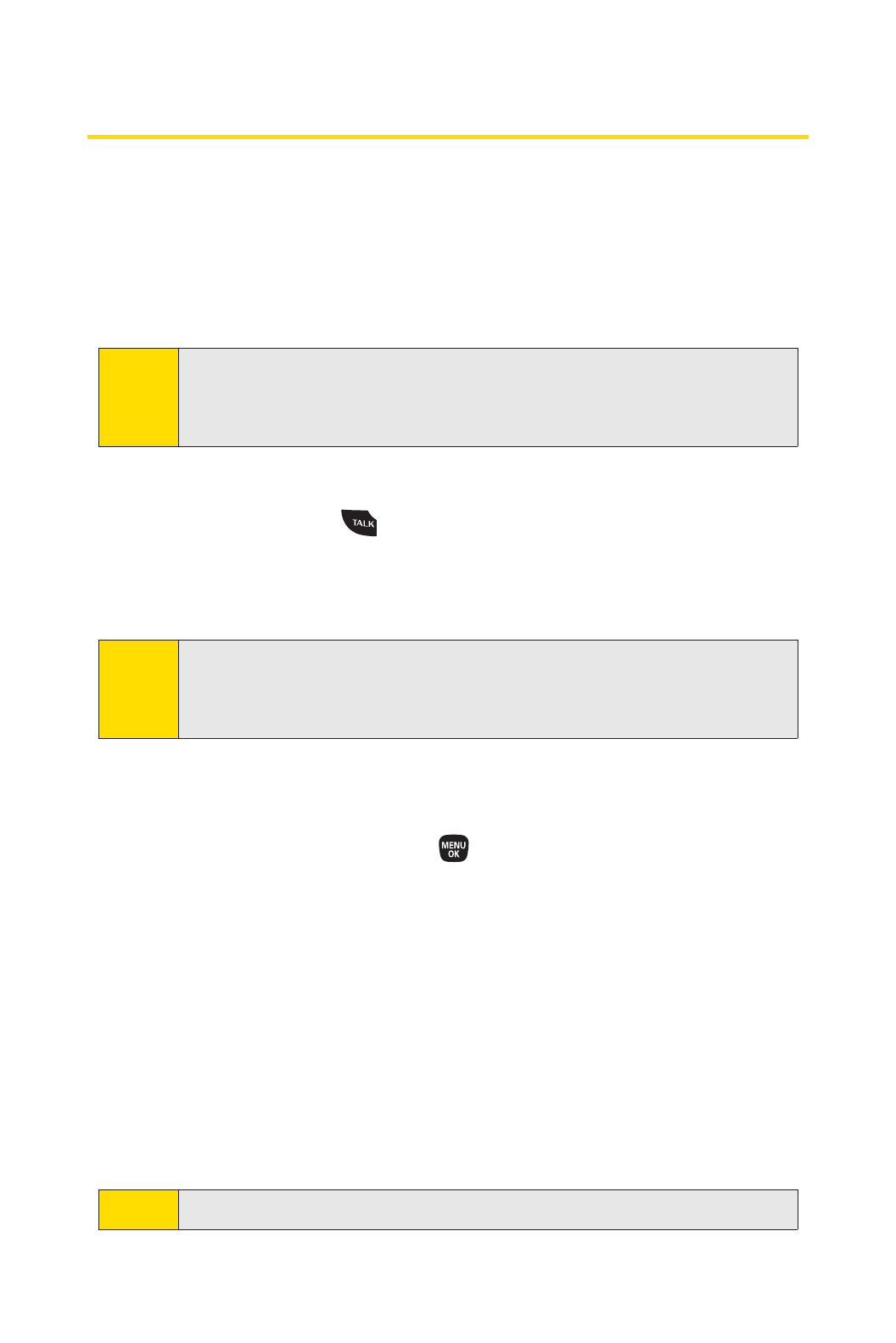
142 Section 2I: Using Your Phone’s Voice Services
Using Voice-Activated Dialing
In addition to SprintVoice Command (see page 199), you can
use a voice dial tag to automatically dial a phone number in
your Contacts. (A voice dial tag is a command you record and
use to place calls without using the keypad.) Your phone can
store up to 30 voice dial tags.
Making a Call Using Voice-Activated Dialing
1. Press and hold .
2. Follow the voice prompts and recite the entry’s voice dial
tag into the microphone.
Programming Voice Dial Tags
1. Select a Contacts entry to which you would like to add a
voice dial tag and press . (See “Finding Contacts
Entries”on page 115.)
2. Select the number you want to assign to the voice dial
tag, and then press Options (right softkey) >
Set Voice Tag > Add.
3. After you are prompted to say a name to program, wait
for the beep and then say the name into the microphone.
4. Repeat the name after the beep, as prompted.
(The display shows “Voice Tag Recorded.”)
Tip Record voice dial tags in a quiet environment.
Tip You can also make a call using voice-activated dialing with the
phone closed. Press and hold the side call key while in standby
mode, and follow the voice prompts.
Note Please set the Voice Guide feature (see page 63) to On before
using the Voice-Activated Dialing so that you can hear voice
instructions through the phone. The default setting is Off.

Section 2I: Using Your Phone’s Voice Services 143
Reviewing Voice Dial Tags
1. Select a Contacts entry for which you would like to
review the voice dial tag and press .
2. Select the phone number to which you have added a
voice dial tag, and press Options (right softkey) >
SetVoice Tag.
3. Select an option and press .
䡲Play to play the selected voice dial tag.
䡲Play:Speaker to play the tag in speakerphone mode.
䡲Change to change the recorded voice dial tag.
䡲Delete to delete the voice dial tag. Press Yes (left
softkey) to delete; press No (right softkey) to cancel.
Deleting All Voice Dial Tags
1. Press > Settings > More... > Security and enter your lock
code.
2. Select Delete/Reset > Delete Voice Tags.
3. Press OK (left softkey), and then press Yes (left softkey) to
delete all recorded voice dial tags or No (right softkey) to
cancel.
Voice Services
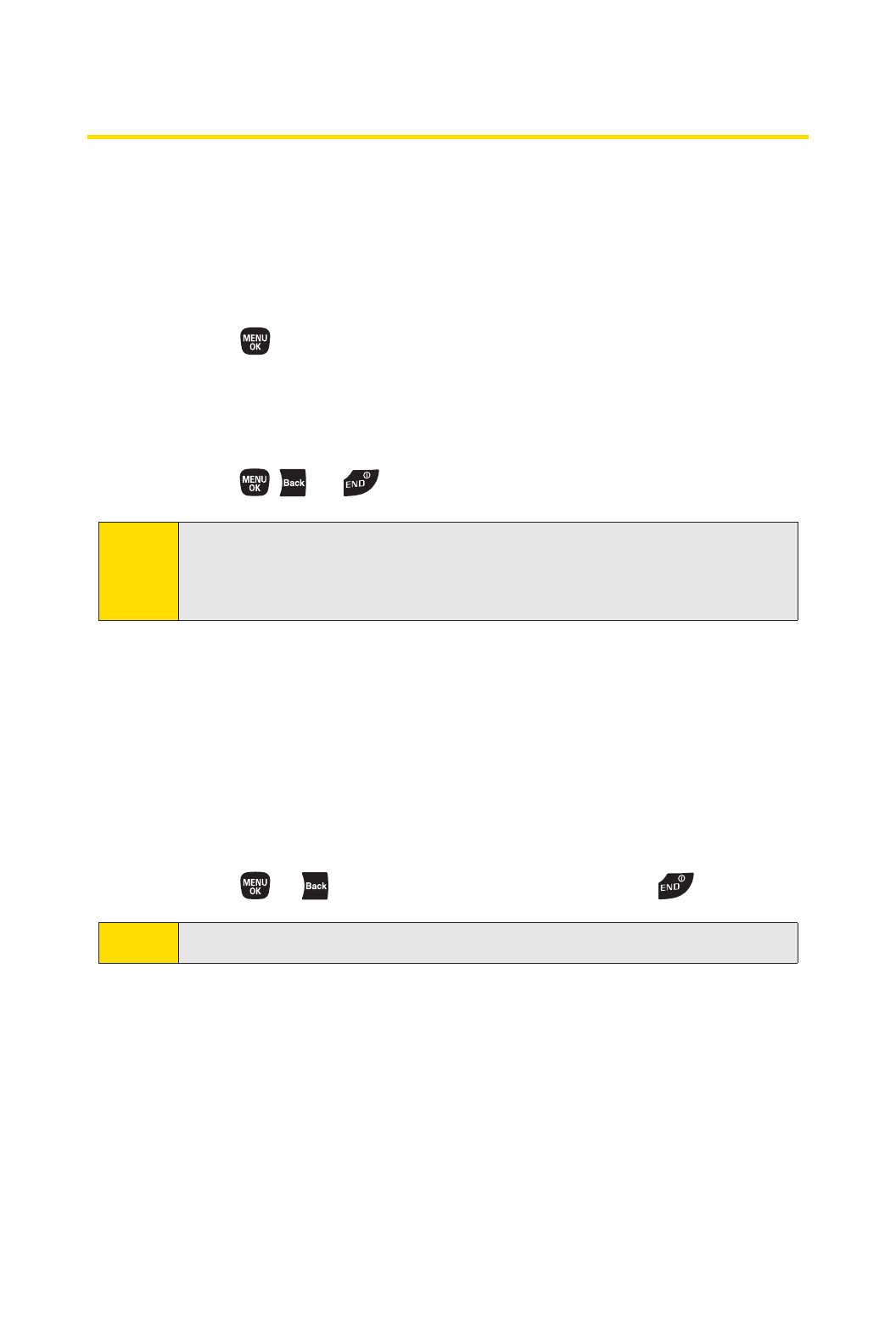
144 Section 2I: Using Your Phone’s Voice Services
Managing Voice Memos
Use your phone’s Voice Services to record brief memos to
remind you of important events, phone numbers, or grocery list
items.
Recording Voice Memos
1. Press >Tools > Voice Memo > Record.
2. Begin recording after the prompt.
To end the recording of your memo:
䊳Press , , or .
To record a conversation during a phone call:
1. During a call, press Options (right softkey) >
Call Memo Rec.
2. Start recording after the beep.
To end the recording of your conversation:
䊳Press or . (To disconnect the call, press .)
Note Only the other party’s voice is recorded during this process.
Note You can store up to 3000 voice memos on your phone.
The total recording time depends on the available memory
space on your phone.

Section 2I: Using Your Phone’s Voice Services 145
Voice Memo Options
To display the voice memo option:
1. Press >Tools > Voice Memo > List.
2. Select a voice memo and press Options (right softkey).
3. Select an option and press .
䡲Play to play a selected voice memo or all voice
memos.
䡲Speaker On or Speaker Off to activate or deactivate
the speakerphone mode.
䡲EditTitle to edit the title of your voice memos.
䡲Properties to show the properties of your voice
memos.
䡲Type Filter to filter your voice memos.
䡲Sort by to sort your voice memos.
䡲Go to Time to set the starting point of the playing.
䡲Delete to delete an individual memo or all voice
memos.
Setting the Recording Guard
With this feature, you can record voice memos without
interruption from incoming calls.
1. Press >Tools > Voice Memo.
2. Press Settings (right softkey) > Recording Guard.
3. Select On or Off and press .
Voice Services

146 Section 2I: Using Your Phone’s Voice Services
Setting the Recording Mode
This feature allows you to match the sensitivity of the
microphone to the type of recording you are making.
1. Press >Tools > Voice Memo.
2. Press Settings (right softkey) > Recording Mode.
3. Select an option and press :
䡲Dictation to record a single voice.
䡲Conference to record multiple voices.
Setting the Audio Quality
This feature enables you to set the quality of your recording.
1. Press >Tools > Voice Memo.
2. Press Settings (right softkey) > Audio Quality.
3. Select High or Low and press .

Section 2I: Using Your Phone’s Voice Services 147
Setting Up Screen Call
This feature enables you to screen incoming calls by using a
recorded announcement, either one that is prerecorded or
one that you record. You can also record the caller’s message
into the Voice Memo list.
Activating Screen Call
To start Screen Call when you have incoming calls:
䊳When the phone rings or vibrates, press Options (right
softkey) > Screen Call.
To set Auto Screen Call:
1. Press >Tools > Voice Memo > Screen Call > Auto.
2. Select On and press .
3. Set the answer delay by using numeric keys or by
pressing the navigation key up or down.
4. Press OK (left softkey). (The icon is displayed on the
screen.)
Selecting an Announcement for Screen Call
1. Press >Tools > Voice Memo > Screen Call >
Announcement.
2. Depending on your preference, select Pre-Recorded or
Custom.
Voice Services

148 Section 2I: Using Your Phone’s Voice Services
Recording Your Name for a Prerecorded Announcement
You can use a prerecorded announcement with or without
your name. If you record your name, your phone adds your
name to the prerecorded message to announce that you are
not available to answer calls.
1. Press >Tools > Voice Memo > Screen Call >
Announcement.
2. Select Pre-Recorded and press Edit (right softkey) >
Record Name.
3. Press to start the first recording. (Press to stop
recording. The maximum recording time is 12 seconds.)
4. After the first recording, press again to start the
second recording.
5. Press to stop recording.
Recording a Customized Announcement
1. Press >Tools > Voice Memo > Screen Call >
Announcement.
2. Select Custom and press Edit (right softkey) > Record.
3. Press to start the first recording. (Press to stop
recording. The maximum recording time is 12 seconds.)
4. After the first recording, press again to start the
second recording.
5. Press to stop recording.

Section 2I: Using Your Phone’s Voice Services 149
Reviewing an Announcement
1. Press >Tools > Voice Memo > Screen Call >
Announcement.
2. Select Pre-Recorded or Custom and press Edit (right
softkey).
3. Select Play or Play:Speaker and press .
Deleting an Announcement
1. Press >Tools > Voice Memo > Screen Call >
Announcement.
2. Select Pre-Recorded or Custom, and press Edit (right
softkey).
3. Select Delete Name or Delete. (A confirmation will be
displayed.)
4. Press Yes (left softkey).
Voice Services

150 Section 2J: Using Bluetooth
Section 2J
Using Bluetooth
In This Section
⽧Turning Bluetooth On and Off (page 151)
⽧Using the Bluetooth Settings Menu (page 152)
⽧Bluetooth Profiles (page 153)
⽧Pairing Bluetooth Devices (page 155)
⽧Using the Trusted Devices Options (page 156)
⽧Sending Data via Bluetooth (page 157)
⽧Printing Data via Bluetooth (page 158)
Your phone features built-in Bluetooth technology, allowing
you to share information more easily than ever before.
Bluetooth is a short-range communications technology
that allows you to connect wirelessly to a number of
Bluetooth devices, such as headsets and hands-free car kits,
and Bluetooth-enabled handhelds, computers, printers,
and wireless phones. The Bluetooth communication range
is usually up to approximately 30 feet.
This section details how to set up and make the most of your
phone’s Bluetooth capabilities.

Section 2J: Using Bluetooth 151
Turning Bluetooth On and Off
By default, your device’s Bluetooth feature is turned off.
Turning Bluetooth on makes your phone “discoverable”by
other in-range Bluetooth devices. To make your phone visible
to other devices you must also ensure that your phone’s
visibility is not set to Hidden. (See page 152.)
To turn Bluetooth on:
1. Press > Settings > Bluetooth > On/Off.
2. Select On and press to enable Bluetooth.
To turn Bluetooth off:
1. Press > Settings > Bluetooth > On/Off.
2. Select Off and press to disable Bluetooth.
Bluetooth Status Indicators
The following icons show your Bluetooth connection status at
a glance:
䢇– Bluetooth feature is active. It turns to green when
connected to a Bluetooth device.
䢇–Your phone is discoverable by another Bluetooth
device.
䢇–Your phone is communicating with a Bluetooth
device.
Using Bluetooth

152 Section 2J: Using Bluetooth
Using the Bluetooth Settings Menu
The Bluetooth Settings menu allows you to set up many of the
characteristics of your phone’s Bluetooth service, including:
䢇Entering or changing the name your phone uses for
Bluetooth communication.
䢇Setting your phone’s visibility (or “discoverability”) for
other Bluetooth devices.
䢇Displaying your phone’s Bluetooth address.
To access the Bluetooth Settings menu:
1. Press > Settings > Bluetooth.
2. Set your Bluetooth options.
䡲Select On/Off to enable or disable Bluetooth.
䡲Select Visibility > Always Visible,Visible for 3 min.,or
Hidden to set your Bluetooth visibility.
䡲Select DeviceName to set a Bluetooth name for your
phone.
䡲Select Device Info to display your phone’s Bluetooth
name, profiles, and address.
䡲Select Trusted Devices to display a list of trusted
Bluetooth devices.
䡲Select Voice Priority > Phone or Hands-free to choose
the default device you want to use for incoming and
outgoing calls.

Section 2J: Using Bluetooth 153
Bluetooth Profiles
All of the Bluetooth settings you configure are stored in your
phone’s Bluetooth user profile. You can use different profiles
for specific Bluetooth functions.
䢇HSP: Headset Profile – This profile functions as a wireless
ear jack. When an incoming call is received, the ringer can
be heard through the headset instead of through the
handset. The call can then be received by pushing a
button. While using the handset, you can use the headset
instead of the phone by pushing a button on the headset,
the same as inserting a jack into the phone. Increase or
decrease the volume by using the volume key on the side
of the handset.
䢇HFP: Hands-Free Profile –This profile functions as a
wireless car kit. Incoming calls ring to the hands-free
headset or device. Calls can be received by pressing a
button on the headset or device. For dialing, four
functions are supported: recent call dial, voice dial, speed
dial, and number dial. Increase or decrease the volume by
using the volume key on the side of the handset.
䢇DUN: Dial-Up Networking Profile – This profile functions as
a wireless data cable, connecting a computer or PDA to a
network through your handset.
䢇OPP: Object Push Profile – This profile uses the Generic
Object Exchange profile services to send data objects
between devices and can be used to exchange calendar
(vCal) and business cards (vCard).
䢇BPP: Basic Printing Profile –This profile enables simpler
printing from your phone to a Bluetooth-enabled printer.
Using Bluetooth

154 Section 2J: Using Bluetooth
䢇GOEP: Generic Object Exchange Profile –This profile defines
the requirements for Bluetooth devices necessary for the
support of object exchange usage models such as
synchronization, file transfer, or object push.
䢇PBAP: Phone Book Access Profile –This profile enables
exchange of Contacts information between devices. It is
likely to be used between a car kit and a mobile phone to
allow the car kit to display the name of the incoming
caller.
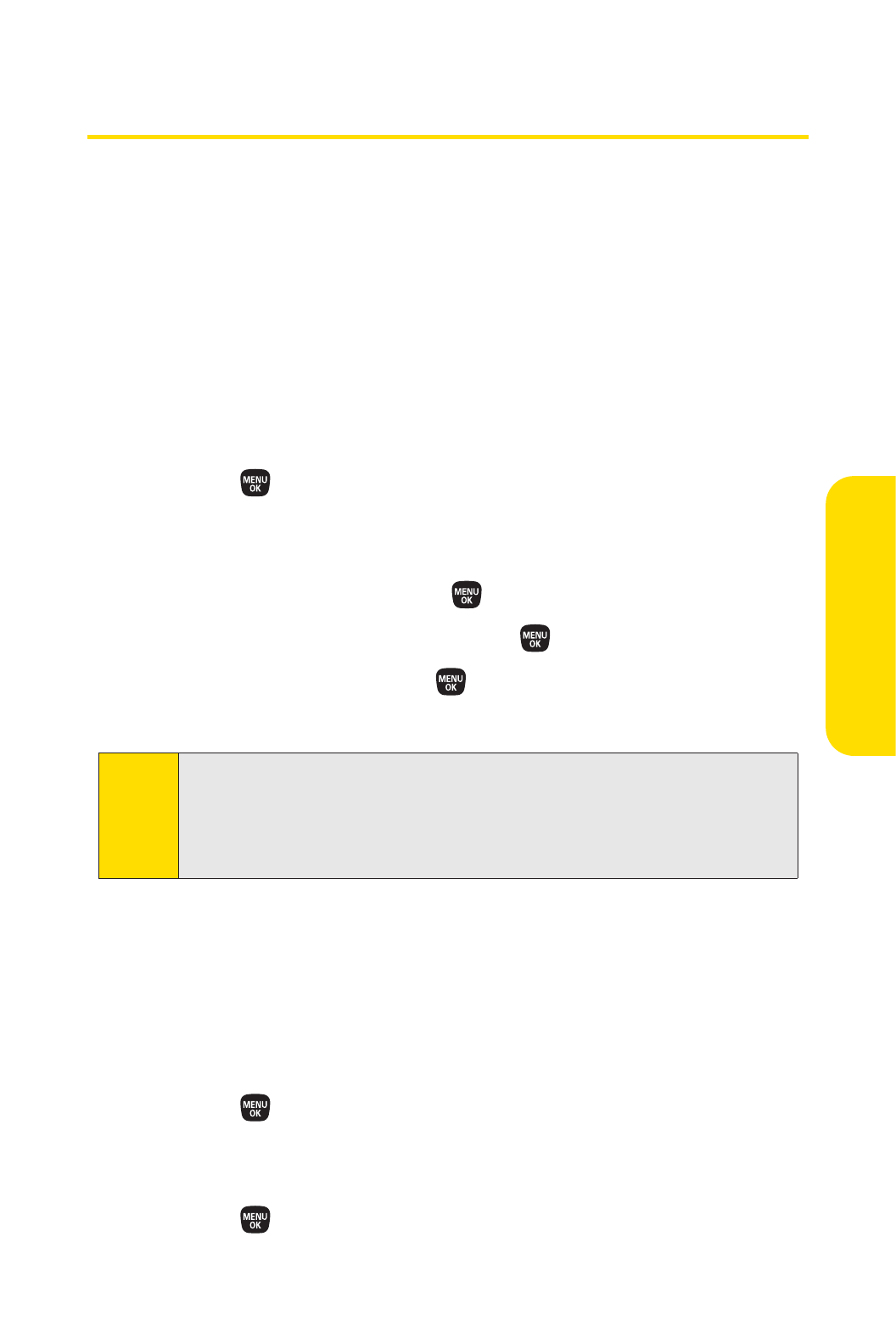
Section 2J: Using Bluetooth 155
Pairing Bluetooth Devices
Paired Devices
The Bluetooth pairing process allows you to establish trusted
connections between your phone and another Bluetooth
device. When devices are paired, a passkey (sometimes called
a PIN code) is shared between devices, allowing for fast,
secure connections while bypassing the discovery and
authentication process.
To pair your phone with another Bluetooth device:
1. Press >Tools > Bluetooth > Add New > Search. (Your
phone will display a list of discovered in-range Bluetooth
devices.)
2. Select a device and press .
3. Select Add to Trusted and press .
4. Enter the PIN and press . (When the owner of the other
device enters the same PIN, the pairing is complete.)
Waiting for Request
If you are going to be using a Dial-Up Networking (DUN)
profile to pair with a computer or PDA, you will need to allow
the other device to initiate pairing with your phone.
To allow your phone to be paired with another Bluetooth device:
1. Press >Tools > Bluetooth > Add New >
Wait for Request.
2. Follow the onscreen prompts to enter your PIN and
press .
Note Due to different specifications and features of other
Bluetooth-compatible devices, display and operations may be
different, and functions such as transfer or exchange may not
be possible.
Using Bluetooth

156 Section 2J: Using Bluetooth
Using the Trusted Devices Options
Once you have created paired devices, several options are
available from the trusted devices list.
To use the trusted devices options:
䊳From the trusted devices list, select a device and press
Options (right softkey) to display the following options:
䡲Connect or Disconnect to connect to or disconnect
from the Bluetooth device (if applicable).
䡲Send Item to send an item saved on your phone to
another Bluetooth device (if applicable).
䡲Print to print the data using Basic Printing Profile or
Object Push Profile (if applicable).
䡲Edit Name to edit the name of the trusted device.
䡲Auto-Accept to configure your phone’s accessibility
to other Bluetooth devices.
䡲DeviceInfo to display the trusted device’s
information.
䡲Sort by to sort the trusted devices.
䡲Delete to delete the selected device from the list.
䡲Delete All to delete all devices from the list.
䡲Settings to display the Bluetooth settings menu.
(See page 152.)

Section 2J: Using Bluetooth 157
Sending Data via Bluetooth
You can send data saved on your phone to another Bluetooth
device.
To send data via Bluetooth:
1. Press >Tools > Bluetooth.
2. Select the device from the trusted devices list and then
press Options (right softkey) > Send Item.
3. Select an item (Business Card,Contacts, or
Calendar Event) and press .
4. Follow the onscreen instructions to select the item(s) to
send.
5. Make sure the other device is ready to receive data, and
then press Send (left softkey).
6. If necessary, enter the PIN and press .
Using Bluetooth

158 Section 2J: Using Bluetooth
Printing Data via Bluetooth
You can print out your Contacts entries, business cards,
calendar events, and messages stored on the phone. (Some
Bluetooth wireless technology enabled printers may not
support this feature.)
To print data via Bluetooth:
1. Press >Tools > Bluetooth.
2. Select the device from the trusted devices list and then
press Options (right softkey) >Print.
3. Select a category (Business Card,Contacts,
Calendar Event, or Message) and press .
4. Follow the onscreen instructions to select the item(s) to
print.
5. Select Handset Default or Printer Default and press .
䡲Handset Default to print items by creating a print job
via the Basic Printing Profile.
䡲Printer Default to print items using the default
printer settings via the Object Push Profile.
6. Make sure the printer is ready to print data, and then
select Print (left softkey).
7. If necessary, enter the PIN and press .
Note Before using the Bluetooth feature, make sure your phone’s
battery is fully charged.

Sprint Service Features
Section 3

160 Section 3A: Sprint Service Features – The Basics
Section 3A
Sprint Service Features:
The Basics
In This Section
⽧Using Voicemail (page 161)
⽧Using SMS Text Messaging (page 169)
⽧Using SMS Voice Messaging (page 172)
⽧Using Caller ID (page 174)
⽧Responding to Call Waiting (page 174)
⽧Making a Three-Way Call (page 175)
⽧Using Call Forwarding (page 176)
Now that you’ve explored your phone’s fundamentals, it’s
time to learn about the calling features that enhance your
Sprint service.This section outlines your basic Sprint service
features.

Section 3A: Sprint Service Features – The Basics 161
Using Voicemail
Setting UpYour Voicemail
All unanswered calls to your phone are automatically
transferred to your voicemail, even if your phone is in use or
turned off. Therefore, you will want to set up your Sprint
Voicemail and personal greeting as soon as your phone is
activated.
1. Press and hold .
2. Follow the system prompts to:
䡲Create your passcode.
䡲Record your name announcement.
䡲Record your greeting.
䡲Choose whether to activate One-Touch Message
Access (a feature that lets you access messages
simply by pressing and holding , bypassing the
need for you to enter your passcode).
Note Voicemail Passcode
If you are concerned about unauthorized access to your
voicemail account, Sprint recommends that you enable your
voicemail passcode (do not activate One-Touch Message
Access).
Sprint Service

162 Section 3A: Sprint Service Features – The Basics
Voicemail Notification
There are several ways your phone alerts you to a new
message:
䢇By displaying a message on the screen.
䢇By sounding the assigned ringer type.
䢇By the LED blinking red.
䢇By displaying at the top of your screen.
New Voicemail Message Alerts
When you receive a new voice message, your phone alerts you
and prompts you to call your voicemail.
To call your voicemail:
䊳Press .
To display your Missed Log:
䊳Press > Messaging > Voicemail > Details.
Note When you are roaming off the Sprint National Network, you
may not receive notification of new voicemail messages. It is
recommended that you periodically check your voicemail by
dialing 1 + area code + your wireless phone number. When
your voicemail answers, press (*) and enter your passcode. You
will be charged roaming rates when accessing voicemail
while roaming off the Sprint National Network.
Your phone accepts messages even when it is turned off.
However, you are notified of new messages only when your
phone is turned on and you are in a Sprint service area.
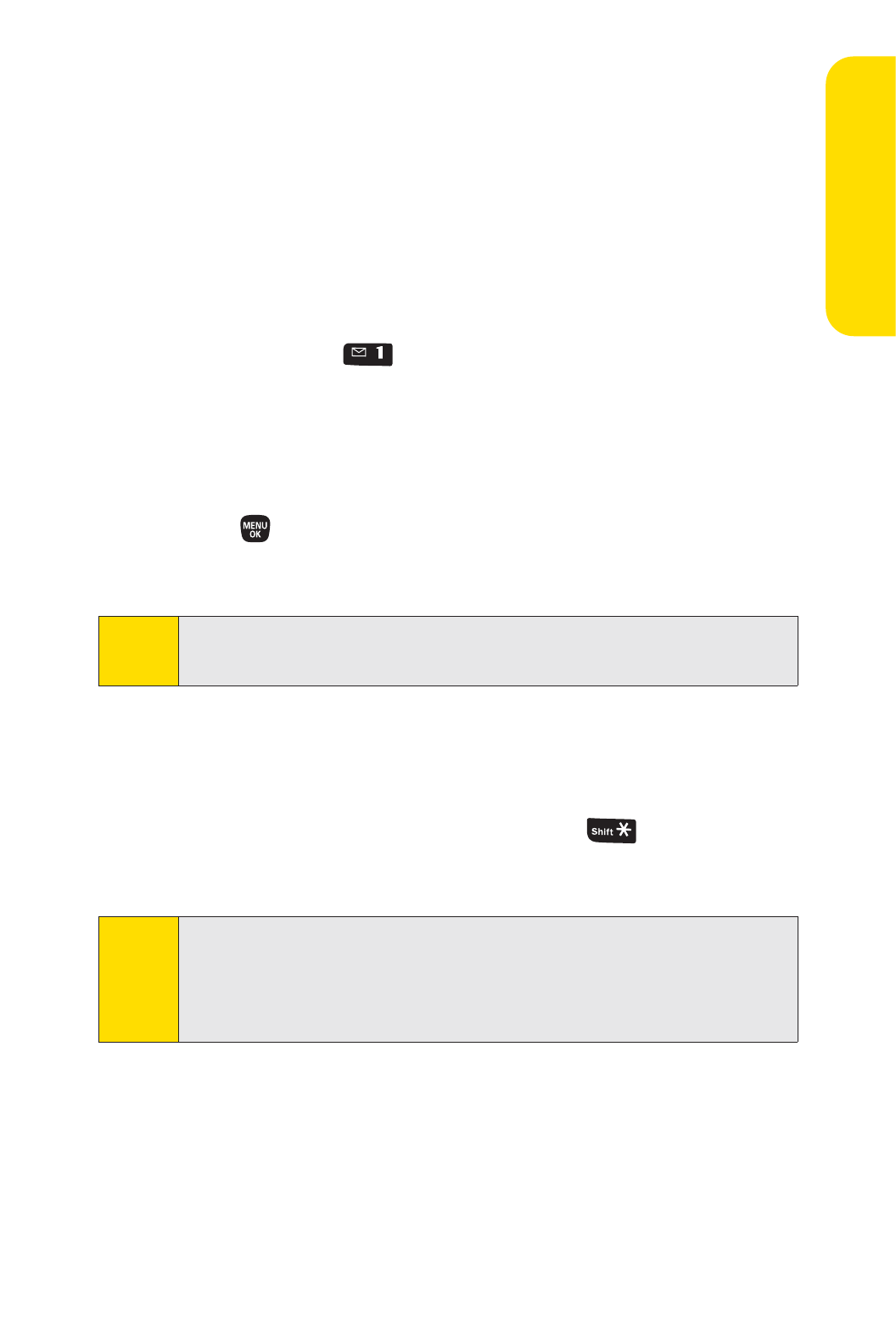
Section 3A: Sprint Service Features – The Basics 163
Retrieving Your Voicemail Messages
You can review your messages directly from your wireless
phone or from any other touch-tone phone. To dial from your
wireless phone, either speed dial your voicemail or use the
menu keys.
Using One-Touch Message Access
䊳Press and hold . (Your phone will dial your voicemail
box.)
Using the Menu Keys on Your Phone to Access Your
Messages
1. Press > Messaging > Voicemail.
2. Select Call Voicemail to listen to your messages.
Using Another Phone to Access Messages
1. Dial your wireless phone number.
2. When your voicemail answers, press .
3. Enter your passcode.
Tip When you call into voicemail, you first hear the header
information (date, time, and sender information) for the
message. To skip directly to the message, press 4 during the
header.
Note You are charged for airtime minutes when you are accessing
your voicemail from your wireless phone.
Sprint Service

164 Section 3A: Sprint Service Features – The Basics
Voicemail Key Guide
Here’s a quick guide to your keypad functions while listening
to voicemail messages. For further details and menu options,
see “Voicemail Menu Key”on page 167.
Date/Time Send Reply Advance
Replay Rewind Forward
Erase Call Back Save
Cancel Help Skip
Voicemail Options
Your phone offers several options for organizing and
accessing your voicemail.
Using Expert Mode
Using the Expert Mode setting for your personal voicemail box
helps you navigate through the voicemail system more quickly
by shortening the voice prompts you hear at each level.
1. Press and hold to access your voicemail. (If your
voicemail box contains any new or saved messages,
press to access the main voicemail menu.)
2. Press to change your Personal Options, following
the system prompts.
3. Press for Expert Mode.
4. Press to turn Expert Mode on or off.

Section 3A: Sprint Service Features – The Basics 165
Setting Up Group Distribution Lists
Create up to 20 separate group lists, each with up to 20
customers.
1. Press and hold to access your voicemail. (If your
voicemail box contains any new or saved messages,
press to access the main voicemail menu.)
2. Press to change your Personal Options, following
the system prompts.
3. Press for Settings.
4. Press for Group Distribution Lists.
5. Follow the voice prompts to create, edit, rename, or
delete group lists.
Sprint Callback
Return a call after listening to a message without
disconnecting from voicemail.
䊳Press after listening to a message. (Once the call is
complete, you’re returned to the voicemail main menu.)
Voicemail-to-Voicemail Message
Record and send a voice message to other SprintVoicemail
users.
1. From the main voicemail menu, press to send a
message.
2. Follow the voice prompts to enter the phone number.
3. Follow the voice prompts to record and send your voice
message.
Sprint Service

166 Section 3A: Sprint Service Features – The Basics
Voicemail-to-Voicemail Message Reply
Reply to a voice message received from any other Sprint
Voicemail user.
1. After listening to a voice message, press .
2. Follow the voice prompts to record and send your reply.
Voicemail-to-Voicemail Message Forwarding
Forward voice messages, except those marked “Private,”to
other SprintVoicemail users.
1. After listening to a message, press .
2. Follow the voice prompts to enter the phone number.
3. Follow the voice prompts to record your introduction
and forward the voice message.
Voicemail-to-Voicemail Receipt Request
Receive confirmation that your voice message has been
listened to when you send or forward messages to, or reply to
messages from other Sprint users.
1. After you have recorded a message, press to listen
to the recorded message.
2. Press for more Options.
3. Press to mark receipt requested.
4. Press to send your voicemail message.

Section 3A: Sprint Service Features – The Basics 167
Extended Absence Greeting
When your phone is turned off or you are off the Sprint
National Network for an extended period, your phone can
play this greeting instead of your normal personal greeting.
1. From the main voicemail menu, press for Personal
Options.
2. Press for Greetings.
3. Press to record an Extended Absence Greeting.
Clearing the Message Icon
Your phone may temporarily continue to display the message
icon after you have checked your voice and text messages.
1. Press > Messaging > Voicemail > Reset Indicator.
2. Press Yes (left softkey).
Voicemail Menu Key
Following the prompts on the voicemail system, you can use
your keypad to navigate through the voicemail menu. The
following list outlines your phone’s voicemail menu structure.
Listen
Envelope Information
Reply
Advance 8 Seconds
Replay
Rewind
Forward Message
Erase
Callback
Save
Options
Sprint Service

168 Section 3A: Sprint Service Features – The Basics
Send a Message
Personal Options
Settings
Skip passcode
Autoplay On/Off
Message Date & Time On/Off
Change passcode
Group Distribution List
Numeric Paging to a Phone On/Off
Return to Personal Options Menu
Greetings
Main Greetings
Recorded Name
Extended Absence Greeting
Return to Personal Options Menu
Expert Mode (On/Off)
Place a Call
Disconnect

Section 3A: Sprint Service Features – The Basics 169
Using SMS Text Messaging
With SMS Text Messaging, you can send and receive instant
text messages between your wireless phone and another
messaging-ready phone. When you receive a new message, it
will automatically display on your phone’s screen.
In addition, SMS Text Messaging includes a variety of preset
messages, such as “Can’t talk right now. Send me a message.”
that make composing messages fast and easy. Use your phone
to customize your own preset messages (up to 50 characters).
Composing SMS Text Messages
1. Press > Messaging > Send Message >Text Message and
select the entry method you prefer:
䡲Go to Contacts to select a recipient from your
Contacts (qualifying Contacts entries must contain a
wireless phone number or an email address).
䡲Phone# to use the keypad to enter a wireless phone
number directly.
䡲Email to enter the recipient’s email address.
2. Press Next (left softkey) when you have finished
entering recipients. (You may include up to 50 recipients
per message.)
3. Enter a message or use the preset messages or smileys
(icons) and press OK (left softkey).
䡲To type a message, use your keypad to enter your
message. Press Mode (right softkey) to select an
input mode. (See “Entering Text”on page 29.)
䡲To use a preset message or a smiley, press Mode
(right softkey), select SMILEYS or Preset Messages,
and then select a message or emoticon and press .
Tip You can also press Others (right softkey) to select recipients
from your desired list.
Sprint Service

170 Section 3A: Sprint Service Features – The Basics
4. Scroll down to select the message priority (Ordinary or
Urgent), set the callback number, set the signature, or
set the delivery receipt.
5. Review your message and press Send (left softkey).
(You may select additional messaging options by
pressing Options [right softkey] to change the recipients
or save to draft.)
Accessing SMS Text Messages
To read an SMS Text message:
䊳When you receive a text message, it will be displayed
automatically on your phone’s screen. Use your
navigation key to scroll down and view the entire
message.
To reply to an SMS Text message:
1. While the message is open, press Reply (left softkey).
– or –
Highlight the message in the Inbox, and press Options
(right softkey) > Reply via > Text Message.
2. Compose your reply or use the preset messages or icons.
䡲To type a message, use your keypad to enter your
message. Press Mode (right softkey) to select an
input mode. (See “Entering Text”on page 29.)
3. Review your reply and press Send (left softkey).
(You may select additional messaging options by
pressing Options [right softkey] to change the recipients
or save to draft.)
Tip You can simply press the Text key to access the Send Text
screen.

Section 3A: Sprint Service Features – The Basics 171
Using Preset Messages
Preset messages make sending text messages to your friends,
family, and co-workers easier than ever. (For information on
preset messages, see “Managing Preset Messages”on
page 75.)
To send preset messages:
1. Press > Settings > Messaging > Preset Messages.
2. Highlight a message you wish to send and press Options
(right softkey) > Send Text.
3. Follow steps 1–5 in “Composing SMS Text Messages”on
page 169.
Sprint Service

172 Section 3A: Sprint Service Features – The Basics
Using SMS Voice Messaging
In addition to SMS Text Messaging, your phone is enabled
with SMS Voice Messaging. With SMS Voice Messaging, you
can send a voice message to other SMS-enabled phones or to
working email addresses without making a phone call. Just
record a message and send it directly to the recipient’s phone
messaging inbox.
Playing an SMS Voice Message
1. Press > Messaging > VoiceSMS.
2. Select the message you want to play and press .
(The message will begin playing.)
3. Press Reply (left softkey) to reply to the message.
(To display the message options, press Options [right
softkey].)
Composing SMS Voice Messages
1. Press > Messaging > Send Message >VoiceSMS.
2. Select Go to Contacts,Phone#, or Email to select a
recipient from the Contacts list or enter a recipient’s
phone number or an email address directly.
3. Press Next (left softkey) when you have finished
selecting and entering recipients.
4. Start recording after the beep. (You can record up to
two minutes.)
5. To finish recording, press Done (left softkey).
6. Press Send (left softkey) to send the voice message.
Tip You can also press Others (right softkey) to select recipients
from your desired list.

Section 3A: Sprint Service Features – The Basics 173
Sending SMS Voice Messages to Group Members
To register a group for SMS Voice Messages:
1. Press > Messaging > VoiceSMS.
2. Press Options (right softkey) > Group Send > Options
(right softkey) > Add New.
3. Enter a name for the group and press OK (left softkey).
4. Select Go to Contacts,Phone#,Email, or Others (right
softkey) to choose members for the group.
5. Press Save (left softkey).
To send SMS Voice Messages to Group Members:
1. Press > Messaging > VoiceSMS.
2. Press Options (right softkey) > Group Send.
3. Select a group to which you would like to send an SMS
Voice Message and press Continue (left softkey).
4. Follow steps 4-6 in “Composing SMS Voice Messages”on
the previous page.
Accessing SMS Voice Messages
䊳When you receive a voice message, a pop-up notification
will automatically be displayed on your phone’s screen.
Use your softkeys to access and play the voice message.
To reply to an SMS Voice message:
1. From the SMS Voice inbox, press Reply (left softkey).
2. Record your reply, and then press Send (left softkey).
Note When no groups are stored, press Options (right softkey) >
Group Send > Yes to create a new group.
Sprint Service

174 Section 3A: Sprint Service Features – The Basics
Using Caller ID
Caller ID allows people to identify a caller before answering
the phone by displaying the number of the incoming call. If
you do not want your number displayed when you make a call,
follow these steps.
1. Press .
2. Enter the number you want to call.
3. Press .
To permanently block your number, call Sprint Customer
Service.
Responding to Call Waiting
When you’re on a call, Call Waiting alerts you to incoming calls
by sounding one beep.Your phone’s screen informs you that
another call is coming in and displays the caller’s phone
number (if it is available).
To respond to an incoming call while you’re on a call:
䊳Press . (This puts the first caller on hold and answers
the second call.)
To switch back to the first caller:
䊳Press again.
Tip For those calls where you don’t want to be interrupted, you
can temporarily disable Call Waiting by pressing *70before
placing your call. Call Waiting is automatically reactivated
once you end the call.

Section 3A: Sprint Service Features – The Basics 175
Making a Three-Way Call
With Three-Way Calling, you can talk to two people at the
same time. When using this feature, the normal airtime rates
will be charged for each of the two calls.
1. Enter a number you wish to call and press .
2. Once you have established the connection, press .
(This puts the first caller on hold.)
3. Select Contacts,Recent History, or Enter Phone# and
press .
4. Choose numbers from your Contacts or Recent History,
or enter them directly, and then press .
5. When you’re connected to the second party, press or
Join (right softkey) to begin your three-way call.
If one of the people you called hangs up during your call, you
and the remaining caller stay connected. If you initiated the
call and are the first to hang up, all other callers are
disconnected.
Sprint Service
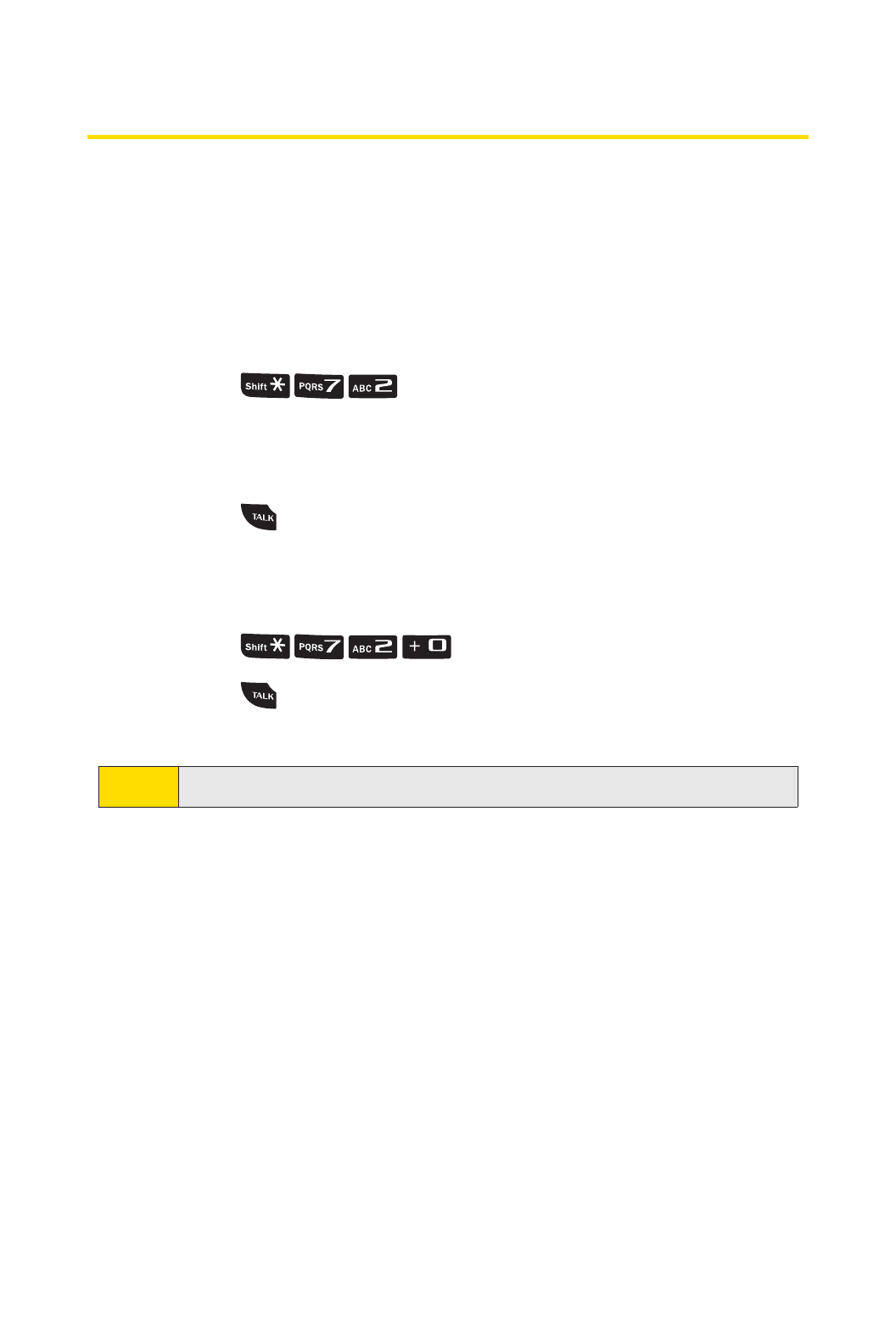
176 Section 3A: Sprint Service Features – The Basics
Using Call Forwarding
Call Forwarding lets you forward all your incoming calls to
another phone number – even when your phone is turned off.
You can continue to make calls from your phone when Call
Forwarding is activated.
To activate Call Forwarding:
1. Press .
2. Enter the area code and phone number to which your
future calls should be forwarded.
3. Press . (You will hear a tone to confirm the activation
of Call Forwarding.)
To deactivate Call Forwarding:
1. Press .
2. Press . (You will hear a tone to confirm the
deactivation.)
Note You are charged a higher rate for calls you have forwarded.

Section 3B: Sprint Power Vision 177
Section 3B
Sprint Power Vision
In This Section
⽧Sprint Power Vision Applications (page 178)
⽧Getting Started With Sprint Power Vision (page 179)
⽧Accessing Messaging (page 185)
⽧Downloading Premium Services Content (page 189)
⽧Exploring the Web (page 193)
⽧Sprint Power Vision FAQs (page 197)
Sprint Power Vision offers easy and amazing data services you
will really use.These features – including messaging, games,
downloadable ringers and screen savers, and portable Web
access – let you have fun, stay in touch, and stay informed no
matter where you go on the Sprint network.
This section introduces these advanced services and walks
you through the necessary steps to start taking advantage
of Sprint Power Vision Services. For complete details and
instructions, visit us online at www.sprint.com.
Sprint PowerVision

178 Section 3B: Sprint Power Vision
Sprint Power Vision Applications
Here is a brief list of the applications available through your
phone. For more information, please visit us online at
www.sprint.com.
Messaging – Send and receive email messages and instant
messages and participate in online chat discussions on your
wireless phone.
Games – Play exciting games with full-color graphics, sound,
and vibration. Choose from hundreds of games to play
anytime.
Ringers – Personalize your phone by downloading and
assigning different ringers to numbers in your Contacts.
Screen Savers –
Download unique images to use as screen
savers, or make it easy to tell who’s calling by assigning specific
images to numbers in your Contacts.
Web – Experience full-color graphic versions of popular Web
sites from your phone.

Section 3B: Sprint Power Vision 179
Getting Started With Sprint Power Vision
With your Sprint service, you are ready to start enjoying the
advantages of Sprint Power Vision. This section will help you
learn the basics of using your Sprint Power Vision services,
including managing your user name, launching a data
connection, and navigating the Web with your phone.
Your User Name
When you buy your phone and sign up for service, you’re
automatically assigned a user name, which is typically based
on your name and a number, followed by “@sprint.com.”(For
example, the third John Smith to sign up for Sprint services
might havejsmith003@sprint.com as his user name.)
When you use Sprint services, your user name is submitted to
identify you to the network. The user name is also useful as an
address for Sprint Mail, as a way to personalize Web services,
and as an online virtual identity.
Your user name will be automatically programmed into your
phone. You don’t have to enter it.
Finding Your User Name
If you aren’t sure what your user name is, you can easily find it
online or on your phone.
䢇At www.sprint.com. Sign on to your account using your
phone number and password. To display your user name,
click on the My Personal Information menu, then click on
Vision User Name.
䢇On your phone. You can find your user name under the
Phone Info option in your phone’s Settings menu ( >
Settings > Phone Info > Phone#/User ID).
Sprint PowerVision
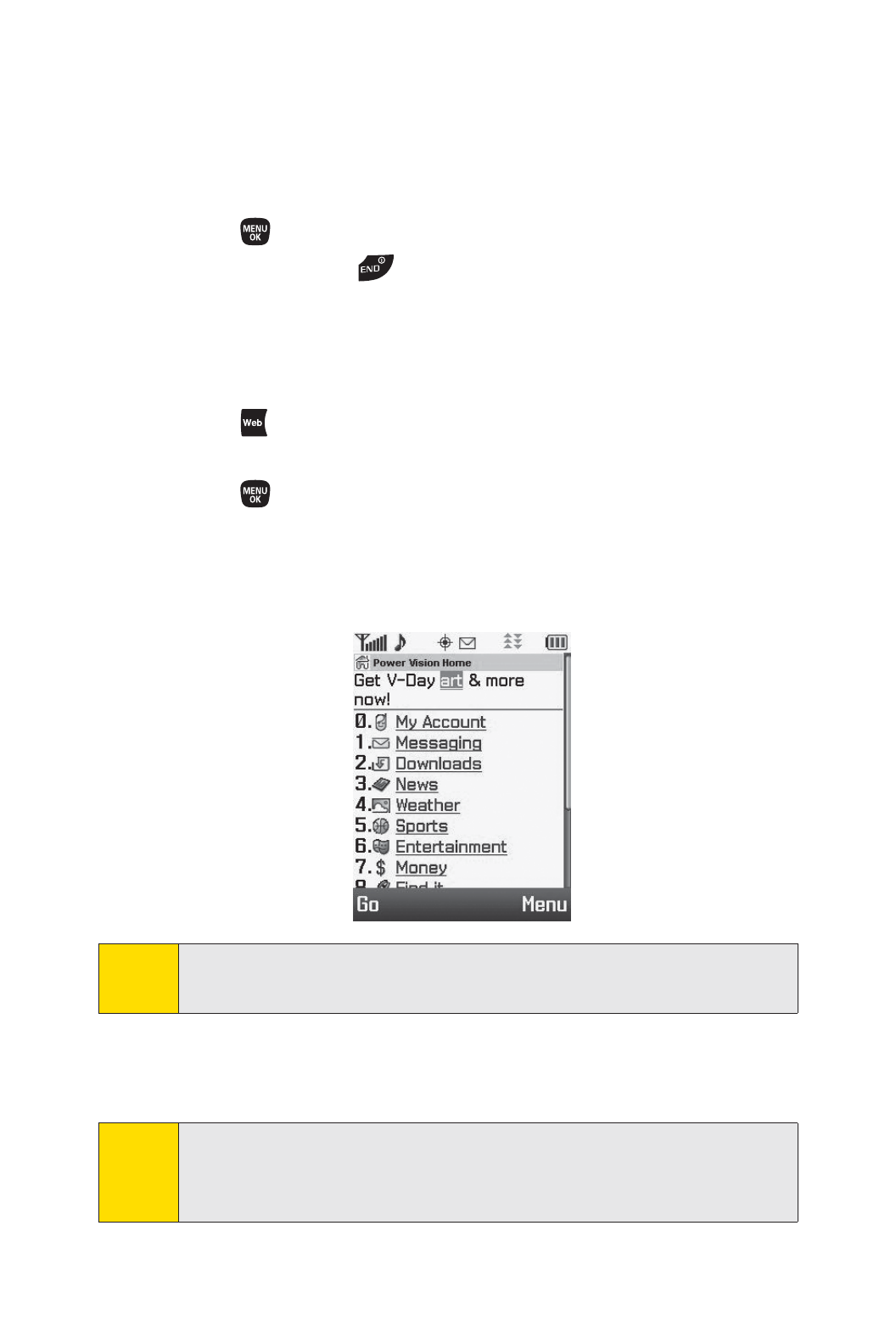
180 Section 3B: Sprint Power Vision
Updating Your User Name
If you choose to change your user name and select a new one
online, you must then update the user name on your phone.
䊳Press > Settings > More... > Data > Update Profile.
(To cancel, press before completing the update.)
Launching a Data Connection
To launch a data connection:
䊳Press .
– or –
Press >Web. (Your data connection will start and the
Sprint Power Vision home page will be displayed.)
The Sprint Power Vision Home Page
While connecting, an animation and a “Connecting”message
may be displayed.
Tip To change the default launch page to the last page you
viewed, from the browser menu press the right softkey >
More... > Preferences > Launch Page and select Last Page.
Note If Net Guard is enabled and displayed (see page 181), press OK
(left softkey) to continue and launch the Web.
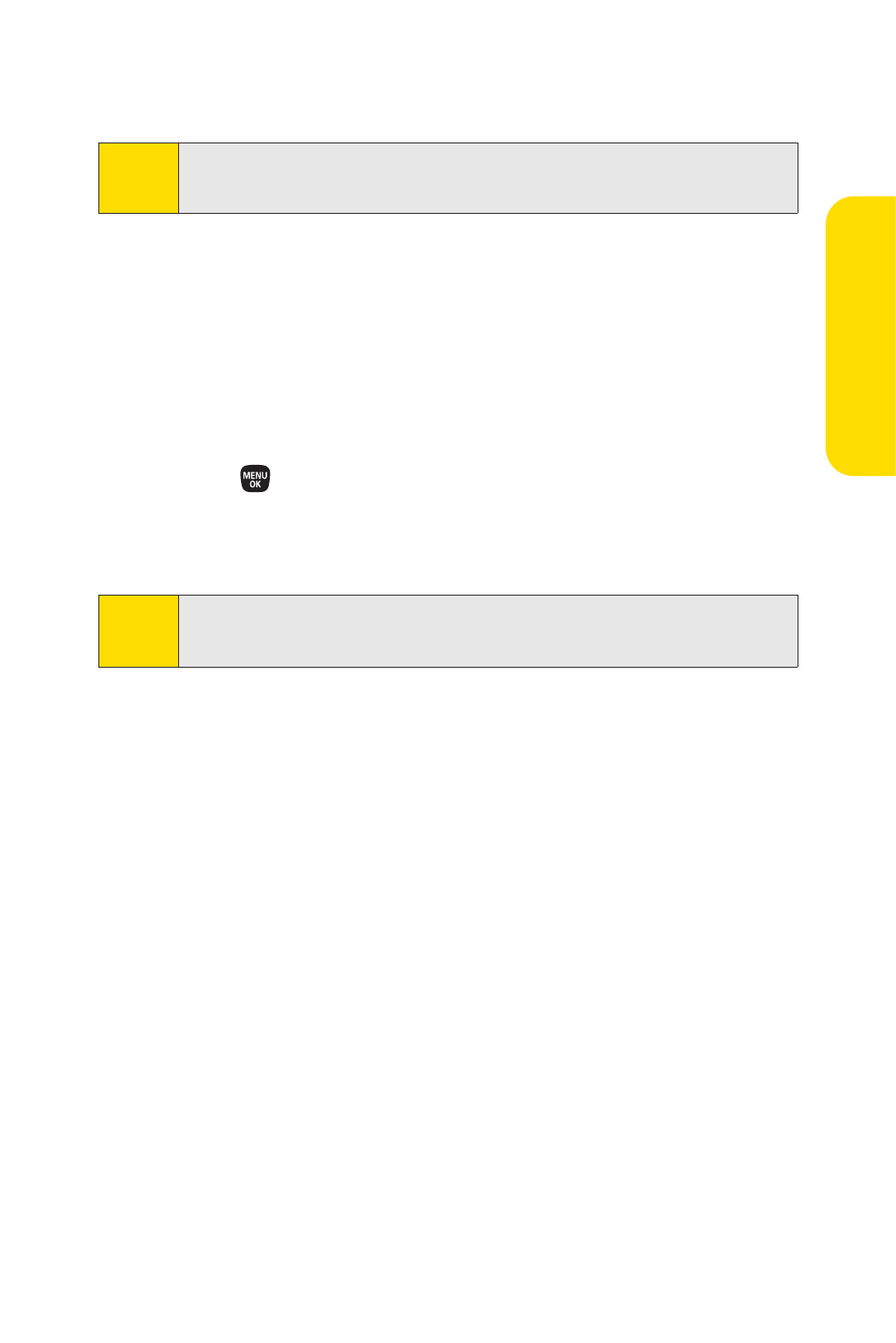
Section 3B: Sprint Power Vision 181
Net Guard
When you first connect to the Web, the Net Guard will be
displayed to confirm that you want to connect. This feature
helps you avoid accidental connections. You can disable the
Net Guard in the future by selecting Always Auto-Connect
when the Net Guard is displayed.
To change your Net Guard settings:
䊳Press > Settings > More... > Data > Net Guard.
䡲Select On to activate the Net Guard.
䡲Select Off to deactivate the Net Guard.
Note When enabled, the Net Guard appears only once as long as
you have not turned the phone off and on.
Note The Net Guard is not available if you have signed up for Nextel
Direct Connect service.
Sprint PowerVision

182 Section 3B: Sprint Power Vision
Data Connection Status and Indicators
Your phone displays the current status of your data
connection through indicators at the top of the screen.
The following symbols are used:
A SprintVision (3G) connection is active (data is being
transferred); the transmit/receive symbol will blink to
indicate data transmission. Incoming voice calls go
directly to voicemail; outgoing voice calls can be made,
but the Sprint Vision connection will terminate.
A SprintVision connection is dormant (no data is being
sent or received). Though not currently active, when
dormant the phone can restart an active connection
quickly; voice calls can be made and received.
Your phone is not currently able to access Sprint Vision
service features.
A Sprint Power Vision (EVDO) connection is active (data is
being transferred); the transmit/receive symbol will
animate to indicate data transmission. Voice calls can be
made and received. When you make or receive a call, the
Sprint Power Vision connection will automatically be
interrupted.
A Sprint Power Vision connection is available but no data
is currently being transferred.
A Sprint Power Vision service is dormant. (No data is
being sent or received.)
If no indicator is displayed, your phone does not have a current
data connection. To launch a connection, see “Launching a
Data Connection”on page 180.

Section 3B: Sprint Power Vision 183
Navigating the Web
Navigating through menus and Web sites during a Sprint
Power Vision session is easy once you’ve learned a few basics.
Here are some tips for getting around:
Softkeys
During a Sprint Power Vision session, the bottom line of your
phone’s display contains one or more softkeys. These keys are
shortcut controls for navigating around the Web, and they
correspond to the softkeys directly below the phone’s display
screen.
To use softkeys:
䊳Press a softkey. (If an additional pop-up menu is
displayed when you press the softkey, select the menu
items using your keypad [if they’re numbered], or by
highlighting the option and pressing .)
Scrolling
As with other parts of your phone’s menu, you’ll have to scroll
up and down to see everything on some Web sites.
To scroll line by line through Web sites:
䊳Press the navigation key up and down.
To scroll page by page through Web sites:
䊳Press the side volume key.
Tip Depending on which Web sites you visit, the labels on the
softkeys may change to indicate their function.
Sprint PowerVision
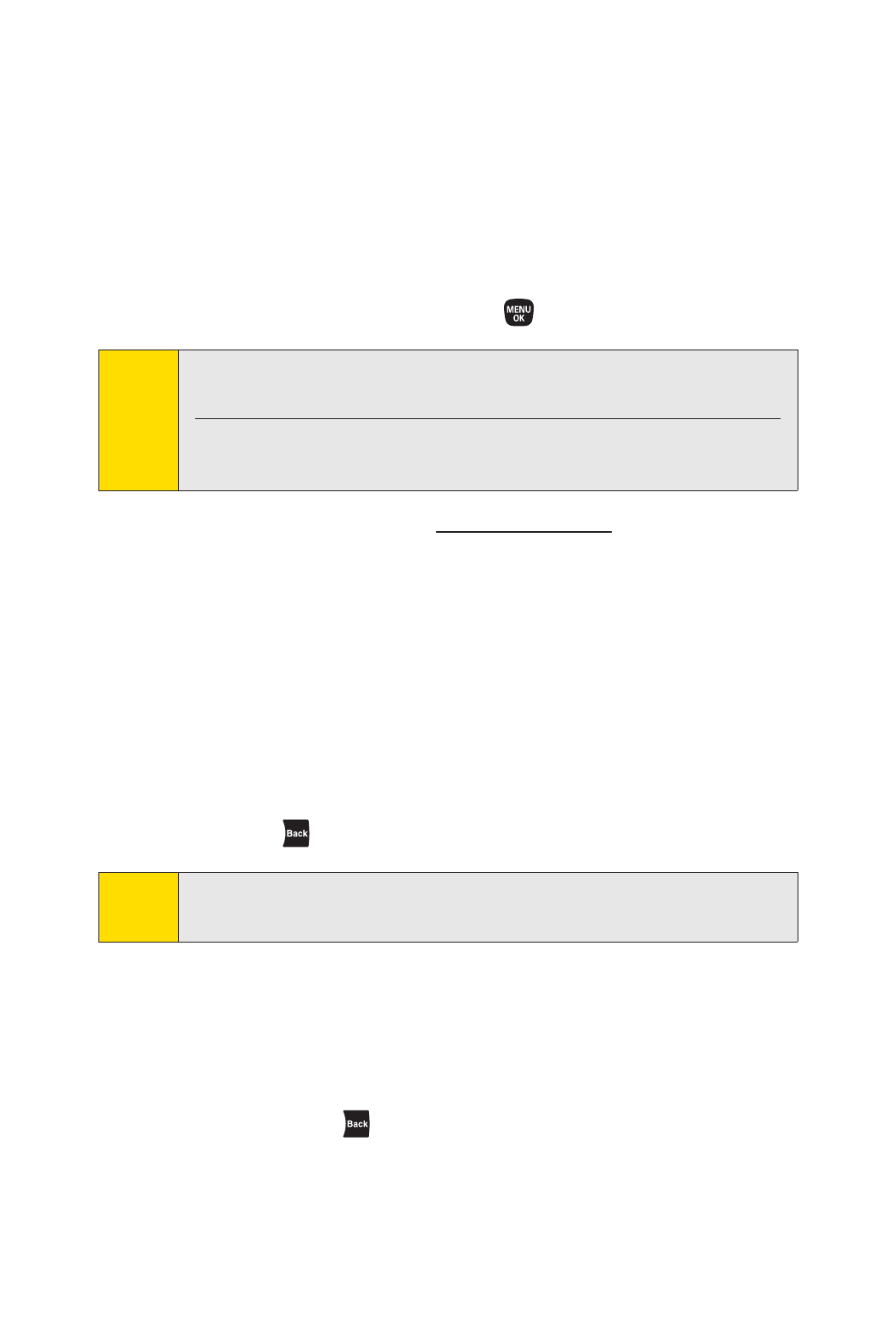
184 Section 3B: Sprint Power Vision
Selecting
Once you’ve learned how to use softkeys and scroll, you can
start navigating the Web.
To select onscreen items:
䊳
Use the
navigation
key to highlight an item, and then
press the left softkey (or press
)
.
Links, which are displayed as underlined text, allow you to
jump to Web pages, select special functions, or even place
phone calls.
To select links:
䊳Highlight the link and press the appropriate softkey.
Going Back
To go back one page:
䊳Press the key on your phone.
Going Home
To return to the Sprint Power Vision home page from any other
page:
䊳Press and hold .
– or –
Press the right softkey> Home > OK (left softkey).
Note The Back key is also used for deleting text (like a BACKSPACE
key) when you are entering text.
Tip You’ll find that the left softkey is used primarily for selecting
items. This softkey is often labeled “OK.”
If the items on a page are numbered, you can use your keypad
(number keys) to select an item.

Section 3B: Sprint Power Vision 185
Accessing Messaging
You can send and receive email messages, instant messages,
and text messages and participate in Web-based chat rooms
right from your phone. Messaging allows you to stay
connected 24 hours a day anywhere on the Sprint network.
Message Types
There are many types of text messaging available on your
phone. These include SMS Text Messaging, Sprint Instant
Messaging, Email, and Chat.
(SprintVoicemail provides voicemail-to-mailbox messaging.
For information on using your phone’s voicemail feature, see
“Using Voicemail”on page 161.)
Using Sprint Mail
Sprint Mail allows you to perform many of the typical email
functions from your phone that you can from your personal
computer.You can manage your Sprint Mail account from
your phone or online at www.sprint.com.
To access Sprint Mail from your phone:
1. Press > Messaging > IM > Sprint Mail. (The browser will
start and go to the Sprint Mail page.)
2. If you’re a first-time user, your phone will prompt you to
set up your Sprint Mail account by establishing a user
name and password.
3. Select the folder you wish to view, such as Inboxor
Compose .
Sprint PowerVision
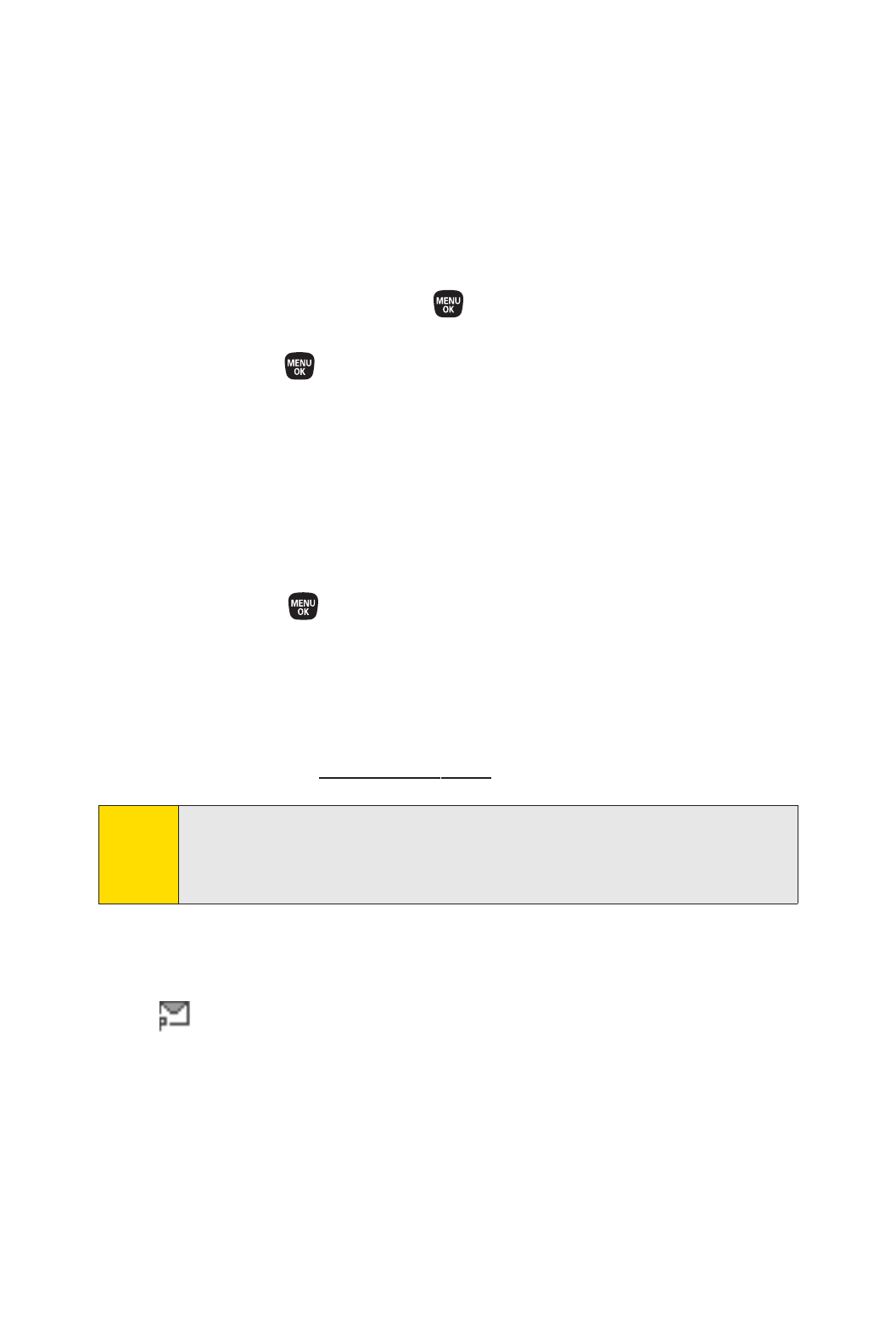
186 Section 3B: Sprint Power Vision
Sending Sprint Mail
1. From the Sprint Mail display (see the previous page),
select Compose (or Reply or Reply All if you’re viewing
a message).
2. Enter a recipient or recipients for your email:
䡲Select To and pres
s
to display your Sprint Mail
address book. To add a recipient, select it and
pres
s
.
– or –
䡲Select the addressee box (under or adjacent to To)
and enter an email address.
3. Repeat as necessary for CCs and BCCs.
4. Enter the Subject and your Message. (Select each field
and pres
s to enter text.)
5. Press Send (left softkey) to send your Sprint Mail message.
For information and instructions about reading, replying to,
and managing Sprint Mail (including setting up your address
book), please visit www.sprint.com.
Viewing Sprint Picture Mail
When a new Sprint Picture Mail message arrives, you will see
the icon on your display screen. You can view picture
messages from the message notification screen or from the
Messaging menu.
To view a new Sprint Picture Mail message from the notification
screen:
䊳Press Go (left softkey).
Tip You can also access Sprint Mail from the Sprint Power Vision
home page. From the home page, select Messaging > Email >
PCS Mail to display your inbox.

Section 3B: Sprint Power Vision 187
To view Sprint Picture Mail messages from the main menu:
1. Press > Messaging > Picture Mail. (The Sprint Picture
Mail list appears.)
2. Select a picture message and press .
3. Press Go (left softkey) to display the picture mail.
(The browser will start and display the Picture Mail
message.)
Accessing Additional Email Providers
With Sprint Power Vision, you can use popular email services
such as AOL® Mail, AIM® Mail, MSN® Mail, and Yahoo!® Mail
to keep in touch, even while you’re on the go.
1. From the Sprint Power Vision home page, select
Messaging > Email.
2. Select an email provider, such as AOL,MSN,orYahoo!.
3. Use your keypad to enter the required sign-in
information for the selected provider, such as user
name, email address, or password, and select Sign In.
(Your mailbox for the selected provider will be
displayed.)
4. Follow the onscreen instructions to read, reply to,
compose, send, and manage your email account.
Tip You can also access the Email and Instant Messaging options
from the main menu. Press Menu > Messaging > Email orIM
and select an option.
Note The information required to sign in will vary depending on the
email provider you are accessing.
Sprint PowerVision

188 Section 3B: Sprint Power Vision
Accessing Sprint Instant Messaging
Sprint Power Vision also provides you with access to popular
instant messaging (IM) clients, including AOL® Instant
MessengerTM, MSN® Messenger, and Yahoo!® Messenger.
1. From the Sprint Power Vision home page, select
Messaging > Instant Messaging.
2. Select an IM provider, such as AOL Instant Messenger,
MSN Messenger, or Yahoo! Messenger.
3. Use your keypad to enter the required sign-in
information for the selected provider, such as user name
or password, and select Sign In. (Your IM screen for the
selected provider will be displayed.)
4. Follow the onscreen instructions to read, reply to,
compose, send, and manage your IM account.
Accessing Wireless Chatrooms
Sprint Power Vision gives you the ability to join wireless
chatrooms from your phone.
1. From the Sprint Power Vision home page, select
Messaging > Chat & Dating.
2. Select a chat provider and follow the onscreen
instructions to sign up and begin chatting.
Note Chat & Dating options change frequently, so check back often
to see what’s new.
Note The information required to sign in will vary depending on the
instant messaging provider you are accessing.

Section 3B: Sprint Power Vision 189
Downloading Premium Services Content
With Sprint Power Vision, you have access to a dynamic
variety of Premium Services content, such as downloadable
Games, Ringers, Screen Savers, and other applications.
(Additional charges may apply.) The basic steps required to
access and download Premium Services content are outlined
below.
Accessing the Download Menus
1. Press >My Content.
2. Select the type of file you wish to download (Games,
Ringers,Screen Savers,Applications, or IM & Email) and
then select Get New. (The browser will start and take you
to the corresponding download menu.)
To access the download menus from the Web browser:
1. From the Sprint Power Vision home page, select
Downloads.
2. Select Games,Ringers,Screen Savers,or Applications to go
to the corresponding download menu. (For more
information on navigating the Web, see “Navigating the
Web”on page 183.)
Sprint PowerVision

190 Section 3B: Sprint Power Vision
Selecting an Item to Download
You can search for available items to download in a number of
ways:
䢇Featured displays a rotating selection of featured items.
䢇Categories allows you to narrow your search to a general
category, such as Country or Pop/Rock for Ringers or For
the Ladies for Screen Savers. (There may be several pages
of available content in a list. Select Next 9 to view
additional items.)
䢇Search allows you to use your keypad to enter search
criteria to locate an item. You may enter an entire word or
title or perform a partial-word search.
Downloading an Item
Once you’ve selected an item you wish to download, highlight
it and press , or press OK (left softkey). You will see a
summary page for the item including its title, the vendor, the
download details, the file size, and the cost. Links allow you to
view the License Details page, which outlines the price, license
type, and length of license for the download, and the Terms of
Use page, which details the Premium Services Terms of Use
and your responsibility for payment.
To download a selected item:
1. From the information page, select Buy. (The item will
download automatically. When the New Download
screen is displayed, the item has been successfully
downloaded to your phone.)
Note If you have not previously purchased an item, you will be
prompted to create your purchasing profile.

Section 3B: Sprint Power Vision 191
2. Once the item has been successfully downloaded and
the completed screen appears, select an option to assign
the ringer or screen saver, run the application, play the
game, etc.
Using My Content Manager
Whether you purchase your Premium Services content from
your phone or from your online account management page at
www.sprint.com, all of your purchases are stored in My Content
Manager and may be downloaded to your phone from there.
My Content Manager is a storage area on the Sprint network
that allows you to store all your Premium Services
downloadable files. The files remain in My Content Manager
until their license terms have expired – even after you have
downloaded the content to your phone. This provides you with a
convenient place to access information about your downloaded
files without having to store the information in your phone’s
memory.
To access My Content Manager:
䊳From the Sprint Power Vision home page, select
Downloads > My Content Manager. (A list of your
purchased items will be displayed.)
To download purchased content from My Content Manager:
1. From the My Content Manager display (see above),
highlight the item you wish to download, and
press . (The information page for the selected
item will be displayed.)
2. Select Download and press . (The item will download
automatically. When the NewDownload screen is
displayed, the item has been successfully downloaded
to your phone.)
Sprint PowerVision
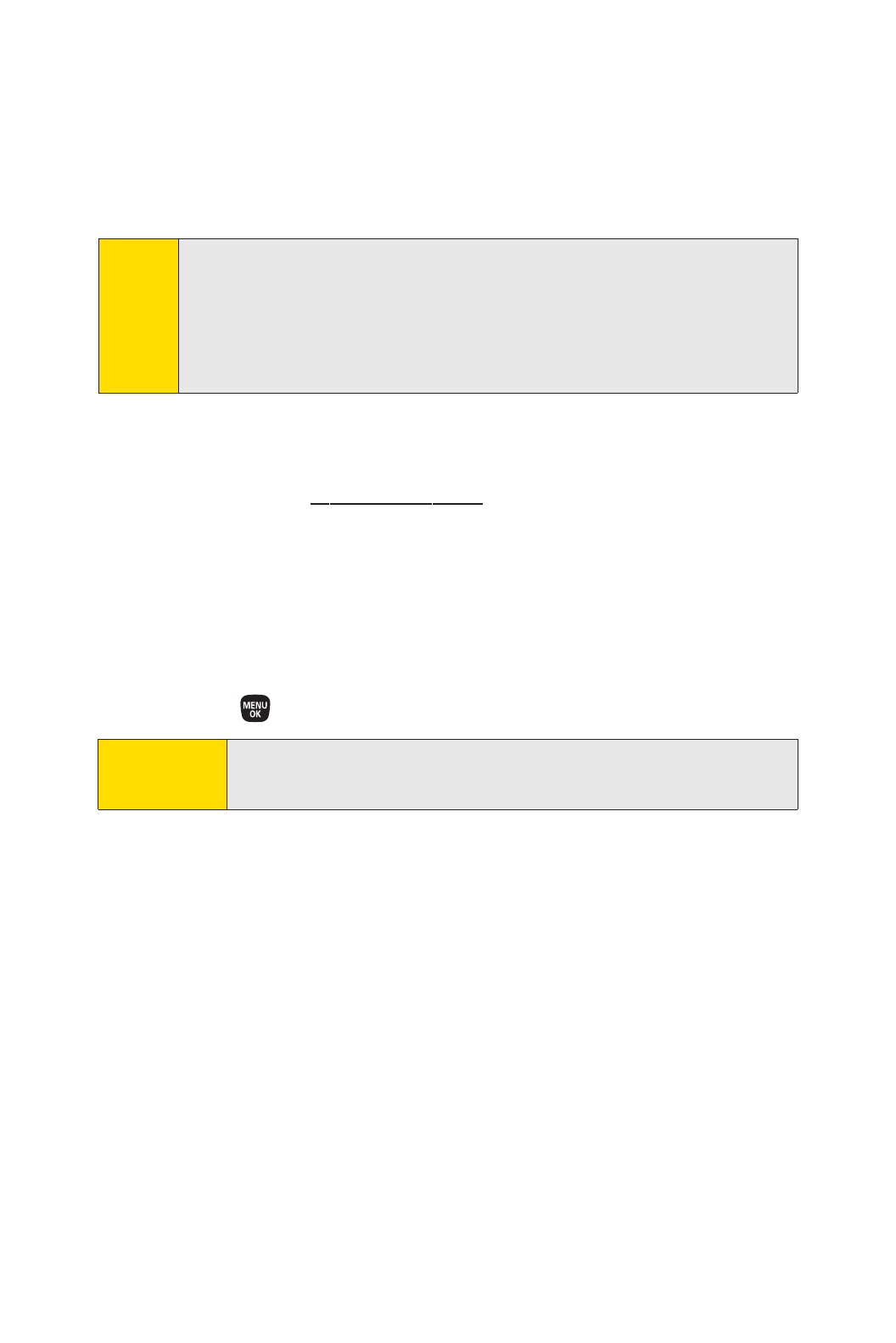
192 Section 3B: Sprint Power Vision
3. Once the item has been successfully downloaded and
the completed screen appears, select an option to assign
the ringer or screen saver, run the application, play the
game, etc.
For complete information and instructions on downloading
Games,Ringers,Screen Savers, and Applications, visit the
Digital Lounge at www.sprint.com.
Using Application Manager
The application manager lets you run applications in the
background while accessing other items in your phone’s
menu.
1. Press > My Content > Application Mgr.
2. Select an application or an alert and press Options (right
softkey) to display the following options:
䡲View Alert to display an alert screen.
䡲Ignore Alert to ignore the alert.
䡲Bring to Front to display the application screen in the
foreground.
䡲Exit Application to close the application.
䡲Launch New App to launch a new application.
Shortcut You can also press App Mgr. (left softkey) in standby
mode while the application is running in the background.
Tip You can also access My Content Manager through the phone’s
main menu. Press Menu > My Content > [Games,Ringers,
Screen Savers,Applications,or IM & Email] > My Content Manager.
The browser will open and take you to the corresponding
content.

Section 3B: Sprint Power Vision 193
Exploring the Web
With Web access on your phone, you can browse full-color
graphic versions of your favorite Web sites, making it easier
than ever to stay informed while on the go. Follow sports
scores, breaking news, and weather, and shop on your phone
anywhere on the Sprint network.
In addition to the features already covered in this section, the
Sprint Power Vision home page offers access to these colorful,
graphically rich Web categories, including News, Weather,
Entertainment, Sports, Money, Travel, Shopping, and Tools,as
well as useful management options including My Account and
Search. Many sites are available under more than one menu –
choose the one that’s most convenient for you.
Using the Browser Menu
Navigating the Web from your phone using the Sprint Power
Vision home page is easy once you get the hang of it. For
details on how to navigate the Web, select menu items, and
more, see “Navigating the Web”on page 183.
Although the Sprint Power Vision home page offers a broad
and convenient array of sites and services for you to browse,
not all sites are represented, and certain functions, such as
going directly to specific Web sites, are not available. For these
and other functions, you will need to use the browser menu.
The browser menu offers additional options to expand your
use of the Web on your phone.
Sprint PowerVision

194 Section 3B: Sprint Power Vision
Opening the Browser Menu
The browser menu may be opened anytime you have an active
Sprint Power Vision session, from any page you are viewing.
To open the browser menu:
䊳Press the right softkey from any page during an active
Sprint Power Vision session. (The browser menu will be
displayed.)
Options available under the browser menu include:
䢇Home. Returns the browser to the Sprint Power Vision
home page.
䢇Forward. Returns you to a previously viewed page (after
having used the ).
䢇Mark this page. Allows you to bookmark the current site.
䢇View Bookmarks. Allows you to access and manage your
bookmarks.
䢇Search. Launches a Web search.
䢇Send page. Allows you to send a URL via SMS.
䢇Go to URL.... Allows you to navigate directly to a Web site
by entering its URL (Web site address).
䢇History. Keeps a list of links to your most recently visited
sites. To navigate to a site, highlight it and press .
䢇Refresh this page. Reloads the current Web page.
䢇More.... Displays additional options:
䡲Show URL. Displays the URL (Web site address) of the
site you’re currently viewing.
䡲Restart Browser. Refreshes the current browser
session.
䡲Script Log. Lets you display the script log.
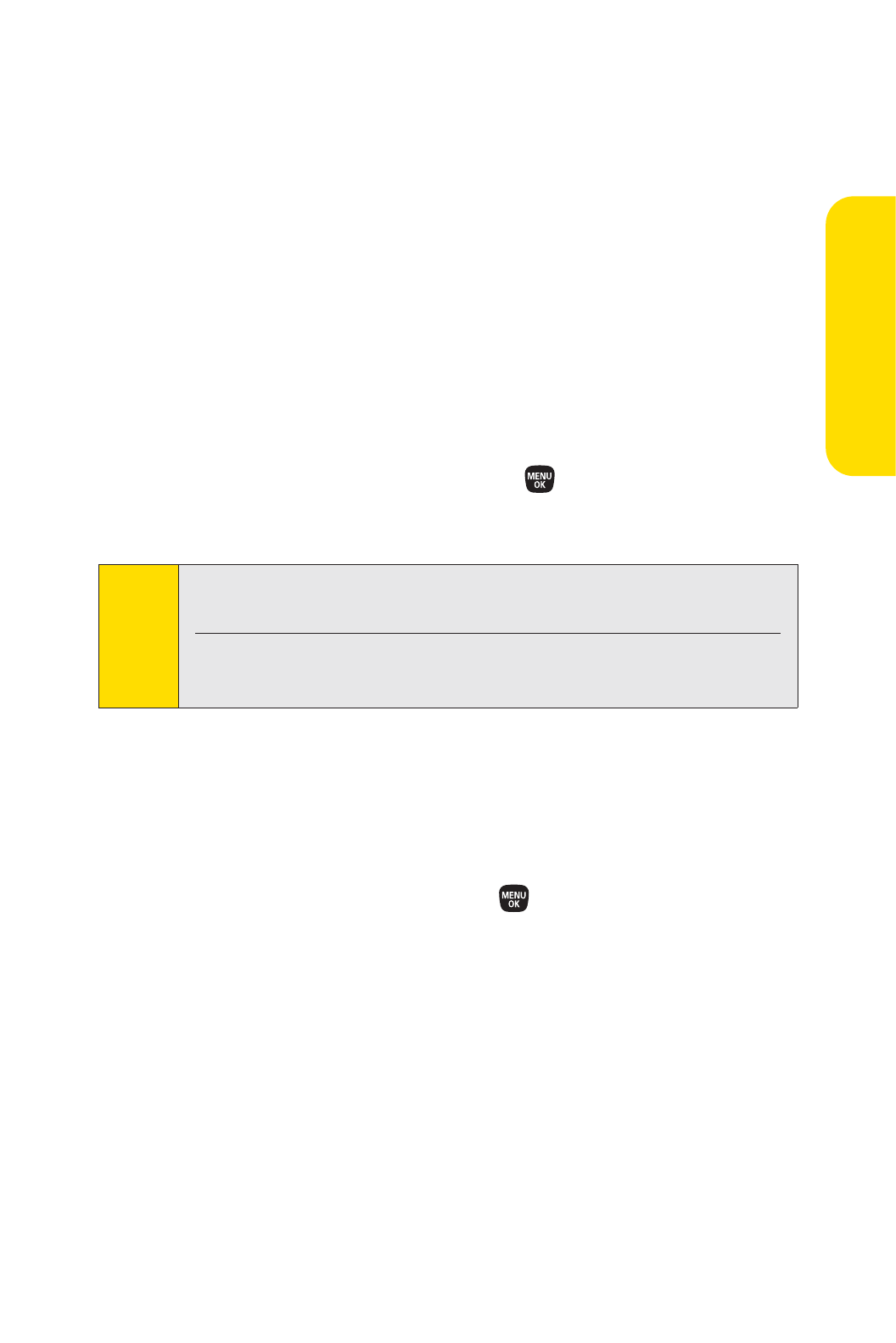
Section 3B: Sprint Power Vision 195
䡲About Browser. Allows you to display information
about your browser.
䡲Preferences. Lets you configure and manage your
browser settings.
Creating a Bookmark
Bookmarks allow you to store the address of your favorite
Web sites for easy access at a later time.
1. Go to the Web page you want to mark.
2. Press the right softkey to open the browser menu.
3. Select Mark this page and press .
4. Press Save (left softkey) to save the bookmark.
Accessing a Bookmark
1. Press the right softkey to open the browser menu.
2. Select View Bookmarks.
3. Select a bookmark and press (or press the number
corresponding to the bookmark you wish to access).
Note Bookmarking a page does not store the page contents, just its
address.
Some pages cannot be bookmarked. Whether a particular
Web page may be marked is controlled by its creator.
Sprint PowerVision

196 Section 3B: Sprint Power Vision
Deleting a Bookmark
1. Press the right softkey to open the browser menu.
2. Select View Bookmarks.
3. Select a bookmark and press the right softkey.
4. Select Delete. (A confirmation will be displayed.)
5. Press Yes (right softkey) to remove the bookmark.
Going to a Specific Web site
To go to a particular Web site by entering a URL (Web site
address):
1. Press the right softkey to open the browser menu.
2. Select Go to URL....
3. Select the Input Address and press .
4. Use your keypad to enter the URL of the Web site you
wish to go to and press .
Reloading a Web Page
To reload (refresh) a Web page:
1. Press the right softkey to open the browser menu.
2. Select Refresh this page. (The browser will reload the
current Web page.)
Note Not all Web sites are viewable on your phone.

Section 3B: Sprint Power Vision 197
Restarting the Web Browser
If the Web browser seems to be malfunctioning or stops
responding, you can usually fix the problem by simply
restarting the browser.
1. Press the right softkey to open the browser menu.
2. Select More... > Restart Browser.
Sprint Power Vision FAQs
How will I know when my phone is ready for Sprint Power
Vision service?
Your user name (for example, bsmith001@sprint.com) will be
displayed when you access > Settings > Phone Info >
Phone#/User ID.
How do I sign in for the first time?
You are automatically signed in to access Sprint Power Vision
services when you turn on your phone.
How do I know when my phone is connected to Sprint services?
Your phone automatically connects when Sprint service is
used or an incoming message arrives. Your phone will also
display the indicator. When you enter an area in which
Sprint Power Vision service is available, you will see the icon.
Can I make calls and use Sprint Power Vision services at the
same time?
You cannot use voice and Sprint Power Vision services
simultaneously. If you receive a call while a Sprint Power Vision
service is active, the call may be forwarded to voicemail or the
call is received and Sprint Power Vision session may be
interrupted. You can place an outgoing call anytime, but it will
interrupt any in-progress Sprint Power Vision session.
Sprint PowerVision

198 Section 3B: Sprint Power Vision
When is my data connection active?
Your connection is active when data is being transferred.
Outgoing calls are allowed; incoming calls may go to
voicemail. When active, the or indicator flashes on your
phone’s display screen.
When is my data connection dormant?
If no data is received for 10 seconds, the connection goes
dormant. When the connection is dormant, voice calls are
allowed. (The connection may become active again quickly.)
If no data is received for an extended period of time, the
connection will terminate.
Can I sign out of data services?
You can sign out without turning off your phone; however, you
will not be able to browse the Web or use other Sprint Power
Vision services. While signed out, you can still place or receive
phone calls, check voicemail, and use other voice services. You
may sign in again at any time. To sign out, go to Settings >
More... > Data> Disable Data in your phone’s menu.

Section 3C: Sprint Voice Command 199
Section 3C
Sprint Voice Command
In This Section
⽧Getting Started With SprintVoice Command (page 200)
⽧Creating Your Own Address Book (page 201)
⽧Making a Call With Sprint Voice Command (page 202)
⽧Accessing Information Using SprintVoice Command
(page 203)
With Sprint, reaching your friends, family, and co-workers has
never been easier – especially when you’re on the go. You can
even listen to Web-based information, such as news,
weather, and sports. Your voice does it all with SprintVoice
Command.
This section outlines the Sprint Voice Command service.
Voice Command

200 Section 3C: Sprint Voice Command
Getting Started With Sprint
Voice Command
With Sprint Voice Command:
䢇You can store all your contacts’phone numbers, so you can
simply say the name of the person you want to call.
䢇There’s no need to punch in a lot of numbers, memorize
voicemail passwords, or try to dial while you’re driving.
䢇You can call anyone in your address book – even if you
don’t remember their phone number.
䢇You don’t need to worry about losing your contacts or
address book. This advanced service is network-based, so
if you switch or happen to lose your phone, you won’t lose
your contacts or address book.
It’s Easy to Get Started
There are two easy ways to sign up for SprintVoice Command:
䊳Sign up when you purchase and activate your phone.
䊳Press from your phone to contact Sprint
Customer Service and sign up.
There is a monthly charge for Sprint Voice Command.

Section 3C: Sprint Voice Command 201
Creating Your Own Address Book
You can program up to 500 names into your personal address
book, with each name having up to five phone numbers.
That’s 2500 phone numbers, and with the advanced
technology of Sprint Voice Command, you can have instant
access to all of them.
There are four ways to update your address book:
䢇On the Web. Go to www.talk.sprintpcs.com and sign on with
your phone number and password to access a fully
functional Web-based address book to create and update
your contacts.
䢇Use an Existing Address Book. Automatically merge
address books from desktop software applications
with Sprint SyncSM Services for no additional charge.
Click the “Click to synchronize”button within your
SprintVoice Command personal address book at
www.talk.sprintpcs.com.
䢇Use Voice Recordings. Press and say, “Add name.”
You will then be asked to say the name and number you
want to add to your personal address book. Your address
book can store up to 20 voice recorded names at once.
䢇Call Sprint 411. If you don’t have a computer or Internet
access handy, you can have Sprint 411 look up phone
numbers for you and automatically add them to your
address book. Press and say “Call operator” and
we’ll add two names and all the numbers associated with
those names to your address book for our standard
directory assistance charge.
Voice Command

202 Section 3C: Sprint Voice Command
Making a CallWith Sprint Voice Command
To make a call with SprintVoice Command:
1. Press and you’ll hear the “Ready”prompt.
2. After the “Ready”prompt, say, in a natural voice, “Call”
and the name of the person or the number you’d like to
call. (For example, you can say, “Call Jane Smith at work,”
“Call John Baker on the mobile phone,” “Call 555-1234,” or
“Call Bob Miller.”)
3. Your request will be repeated and you will be asked to
verify. Say “Yes” to call the number or person.
(The number will automatically be dialed.) Say “No” if
you wish to cancel.
For more helpful hints on Sprint Voice Command, including a
list of recognized commands and an interactive tutorial, visit
www.talk.sprintpcs.com.
Tip Keep in mind that Sprint Voice Command recognizes not only
your voice, but any voice, so that others can experience the
same convenience if they use your phone.

Section 3C: Sprint Voice Command 203
Accessing Information Using
SprintVoice Command
To access information using Sprint Voice Command:
1. Press .
2. Say “Call the Web” and choose from a listing of
information categories like news, weather, and sports.
– or –
Say “Call news room,” “Call the weather,” “Call Sports
Central,” etc.
Note SprintVoice Command is not available while roaming off the
Sprint National Network.
Voice Command


Safety and Warranty
Information
Section 4

Section 4A
Important Safety Information
In This Section
⽧General Precautions (page 207)
⽧Maintaining Safe Use of and Access to Your Phone (page 208)
⽧Using Your Phone With a Hearing Aid Device (page 210)
⽧Caring for the Battery (page 212)
⽧Radio Frequency (RF) Energy (page 213)
⽧Owner’s Record (page 216)
⽧Phone Guide Proprietary Notice (page 216)
This phone guide contains important operational and safety
information that will help you safely use your phone. Failure
to read and follow the information provided in this phone
guide may result in serious bodily injury, death, or property
damage.
206 Section 4A: Important Safety Information

General Precautions
There are several simple guidelines to operating your phone properly and
maintaining safe, satisfactory service.
䢇To maximize performance, do not touch the upper and bottom portion
of the back of the phone where the internal antenna is located while
using the phone.
䢇Speak directly into the mouthpiece.
䢇Avoid exposing your phone and accessories to rain or liquid spills.
If your phone does get wet, immediately turn the power off and
remove the battery.
䢇Do not expose your phone to direct sunlight for extended periods of
time (such as on the dashboard of a car).
䢇Although your phone is quite sturdy, it is a complex piece of equipment
and can be broken. Avoid dropping, hitting, bending, or sitting on it.
䢇Any changes or modifications to your phone not expressly approved in
this document could void your warranty for this equipment and void
your authority to operate this equipment.
Note For the best care of your phone, only Sprint-authorized personnel
should service your phone and accessories. Failure to do so may be
dangerous and void your warranty.
Section 4A: Important Safety Information 207
Important Safety Information

Maintaining Safe Use of and Access to
Your Phone
Do Not Rely on Your Phone for Emergency Calls
Mobile phones operate using radio signals, which cannot guarantee
connection in all conditions. Therefore you should never rely solely upon
any mobile phone for essential communication (e.g., medical
emergencies). Emergency calls may not be possible on all cellular networks
or when certain network services or mobile phone features are in use.
Check with your local service provider for details.
Using Your Phone While Driving
Talking on your phone while driving (or operating the phone without a
hands-free device) is prohibited in some jurisdictions. Laws vary as to
specific restrictions. Remember that safety always comes first.
Following Safety Guidelines
To operate your phone safely and efficiently, always follow any special
regulations in a given area. Turn your phone off in areas where use is
forbidden or when it may cause interference or danger.
Using Your Phone Near Other Electronic Devices
Most modern electronic equipment is shielded from radio frequency (RF)
signals. However, RF signals from wireless phones may affect inadequately
shielded electronic equipment.
RF signals may affect improperly installed or inadequately shielded
electronic operating systems or entertainment systems in motor vehicles.
Check with the manufacturer or their representative to determine if these
systems are adequately shielded from external RF signals. Also check with
the manufacturer regarding any equipment that has been added to your
vehicle.
Consult the manufacturer of any personal medical devices, such as
pacemakers and hearing aids, to determine if they are adequately shielded
from external RF signals.
Note Always turn off the phone in healthcare facilities, and request
permission before using the phone near medical equipment.
Tip Purchase an optional hands-free accessory at your local Sprint Store, or
call Sprint at 1-800-974-2221 or by dialing #222on your phone.
208 Section 4A: Important Safety Information

Turning Off Your Phone Before Flying
Turn off your phone before boarding any aircraft. To prevent possible
interference with aircraft systems, the U.S. Federal Aviation Administration
(FAA) regulations require you to have permission from a crew member to
use your phone while the plane is on the ground. To prevent any risk of
interference, FCC regulations prohibit using your phone while the plane is
in the air.
Turning Off Your Phone in Dangerous Areas
To avoid interfering with blasting operations, turn your phone off when in a
blasting area or in other areas with signs indicating two-way radios should
be turned off. Construction crews often use remote-control RF devices to
set off explosives.
Turn your phone off when you’re in any area that has a potentially explosive
atmosphere. Although it’s rare, your phone and accessories could generate
sparks. Sparks can cause an explosion or fire, resulting in bodily injury or
even death. These areas are often, but not always, clearly marked. They
include:
䢇Fueling areas such as gas stations.
䢇Below deck on boats.
䢇Fuel or chemical transfer or storage facilities.
䢇Areas where the air contains chemicals or particles such as grain, dust,
or metal powders.
䢇Any other area where you would normally be advised to turn off your
vehicle’s engine.
Restricting Children’s Access to Your Phone
Your phone is not a toy. Do not allow children to play with it as they could
hurt themselves and others, damage the phone or make calls that increase
your Sprint invoice.
Note Never transport or store flammable gas, flammable liquids, or
explosives in the compartment of your vehicle that contains your
phone or accessories.
Section 4A: Important Safety Information 209
Important Safety Information

Using Your Phone With a Hearing Aid
Device
A number of Sprint phones have been tested for hearing aid device
compatibility. When some wireless phones are used with certain hearing
devices (including hearing aids and cochlear implants), users may detect a
noise which can interfere with the effectiveness of the hearing device.
Some hearing devices are more immune than others to this interference
noise, and phones also vary in the amount of interference noise they may
generate. ANSI standard C63.19 was developed to provide a standardized
means of measuring both wireless phone and hearing devices to determine
usability rating categories for both.
Ratings have been developed for mobile phones to assist hearing device
users find phones that may be compatible with their hearing device. Not all
phones have been rated for compatibility with hearing devices. Phones that
have been rated have a label located on the box. Your PRO-200 by SANYO
has an M4 and a T4 rating.
These ratings are not guarantees. Results will vary depending on the user’s
hearing device and individual type and degree of hearing loss. If a hearing
device is particularly vulnerable to interference noise; even a phone with a
higher rating may still cause unacceptable noise levels in the hearing
device. Trying out the phone with your hearing device is the best way to
evaluate it for your personal needs.
M-Ratings: Phones rated M3 or M4 meet FCC requirements for hearing aid
compatibility and are likely to generate less interference to hearing devices
than unrated phones. (M4 is the better/higher of the two ratings.)
T-Ratings: Phones rated T3 or T4 meet FCC requirements and are likely to be
more usable with a hearing device’s telecoil (“T Switch”or “Telephone
Switch”) than unrated phones. (T4 is the better/higher of the two ratings.
Note that not all hearing devices have telecoils in them.)
210 Section 4A: Important Safety Information

Hearing aid devices may also be measured for immunity to interference
noise from wireless phones and should have ratings similar to phones. Ask
your hearing healthcare professional for the rating of your hearing aid. Add
the rating of your hearing aid and your phone to determine probable
usability:
䢇Any combined rating equal to or greater than six offers excellent use.
䢇Any combined rating equal to five is considered normal use.
䢇Any combined rating equal to four is considered usable.
Thus, if you pair an M3 hearing aid with an M3 phone, you will have a
combined rating of six for “excellent use.”This is synonymous for T ratings.
SprintNextel further suggests you experiment with multiple phones (even
those not labeled M3/T3 or M4/T4) while in the store to find the one that
works best with your hearing aid device. Should you experience
interference or find the quality of service unsatisfactory after purchasing
your phone, promptly return it to the store within 30 days of purchase. With
the Sprint 30-day Risk-Free Guarantee, you may return the phone within 30
days of purchase for a full refund. More information about hearing aid
compatibility may be found at: www.fcc.gov,www.fda.gov, and
www.accesswireless.org.
Getting the Best Hearing Device Experience
With Your Phone
To further minimize interference:
䢇Set the phone’s Display and Keypad backlight settings to ensure the
minimum time interval:
1. Press > Settings > Display > Main Screen or Outer Screen >
Backlight.
– or –
Press > Settings> Display > Keypad Light.
2. Select the minimum time interval setting and press .
䢇Position the phone so the internal antenna is farthest from your
hearing aid.
䢇Move the phone around to find the point with least interference.
Section 4A: Important Safety Information 211
Important Safety Information

Caring for the Battery
Protecting Your Battery
The guidelines listed below help you get the most out of your battery’s
performance.
䢇Recently there have been some public reports of wireless phone
batteries overheating, catching fire or exploding. It appears that many,
if not all, of these reports involve counterfeit or inexpensive,
aftermarket-brand batteries with unknown or questionable
manufacturing standards. Sprint is not aware of similar problems with
Sprint phones resulting from the proper use of batteries and accessories
approved by Sprint or the manufacturer of your phone. Use only Sprint-
approved or manufacturer-approved batteries and accessories found at
Sprint Stores or through your phone’s manufacturer, or call 1-866-343-
1114 to order. They’re also available at www.sprint.com — click
Accessories. Buying the right batteries and accessories is the best way
to ensure they’re genuine and safe.
䢇In order to avoid damage, charge the battery only in temperatures that
range from 32° F to 113° F (0° C to 45° C).
䢇Don’t use the battery charger in direct sunlight or in high humidity
areas, such as the bathroom.
䢇Never dispose of the battery by incineration.
䢇Keep the metal contacts on top of the battery clean.
䢇Don’t attempt to disassemble or short-circuit the battery.
䢇The battery may need recharging if it has not been used for a long period
of time.
䢇It’s best to replace the battery when it no longer provides acceptable
performance. It can be recharged hundreds of times before it needs
replacing.
䢇Don’t store the battery in high temperature areas for long periods of
time. It’s best to follow these storage rules:
Less than one month:
-4° F to 140° F (-20° C to 60° C)
More than one month:
-4° F to 113° F (-20° C to 45° C)
212 Section 4A: Important Safety Information

Disposal of Lithium Ion (Li-Ion) Batteries
Do not handle a damaged or leaking Li-Ion battery as you can be burned.
For safe disposal options of your Li-Ion batteries, contact your nearest
Sprint authorized service center.
Special Note: Be sure to dispose of your battery properly. In some areas, the
disposal of batteries in household or business trash may be prohibited.
Radio Frequency (RF) Energy
Understanding How Your Phone Operates
Your phone is basically a radio transmitter and receiver. When it’s turned
on, it receives and transmits radio frequency (RF) signals. When you use
your phone, the system handling your call controls the power level. This
power can range from 0.006 watt to 0.2 watt in digital mode.
Knowing Radio Frequency Safety
The design of your phone complies with updated NCRP standards described
below.
In 1991–92, the Institute of Electrical and Electronics Engineers (IEEE) and
the American National Standards Institute (ANSI) joined in updating ANSI’s
1982 standard for safety levels with respect to human exposure to RF
signals. More than 120 scientists, engineers and physicians from
universities, government health agencies and industries developed this
updated standard after reviewing the available body of research. In 1993,
the Federal Communications Commission (FCC) adopted this updated
standard in a regulation. In August 1996, the FCC adopted hybrid standard
consisting of the existing ANSI/IEEE standard and the guidelines published
by the National Council of Radiation Protection and Measurements (NCRP).
Body-Worn Operation
To maintain compliance with FCC RF exposure guidelines, if you wear a
handset on your body, use the Sprint supplied or approved carrying case,
holster or other body-worn accessory. If you do not use a body-worn
accessory, ensure the antenna is at least 2.3 centimeters from your body
when transmitting. Use of non-Sprint-approved accessories may violate
FCC RF exposure guidelines.
For more information about RF exposure, visit the FCC Web site at
www.fcc.gov.
Section 4A: Important Safety Information 213
Important Safety Information

Specific Absorption Rates (SAR) for Wireless Phones
The SAR is a value that corresponds to the relative amount of RF energy
absorbed in the head of a user of a wireless handset.
The SAR value of a phone is the result of an extensive testing, measuring
and calculation process. It does not represent how much RF the phone
emits. All phone models are tested at their highest value in strict laboratory
settings. But when in operation, the SAR of a phone can be substantially
less than the level reported to the FCC. This is because of a variety of factors
including its proximity to a base station antenna, phone design and other
factors. What is important to remember is that each phone meets strict
federal guidelines. Variations in SARs do not represent a variation in safety.
All phones must meet the federal standard, which incorporates a
substantial margin of safety. As stated above, variations in SAR values
between different model phones do not mean variations in safety. SAR
values at or below the federal standard of 1.6 W/kg are considered safe for
use by the public.
The highest reported SAR values of the PRO-200 by SANYO®are:
Cellular CDMA mode (Part 22):
Head: 0.405 W/kg; Body-worn: 0.218 W/kg
PCS mode (Part 24):
Head: 1.210 W/kg; Body-worn: 0.544 W/kg
FCC Radio Frequency Emission
This phone meets the FCC Radio Frequency Emission Guidelines.
FCC ID number: AEZSCP-PRO200.
More information on the phone’s SAR can be found from the following FCC
Web site: http://www.fcc.gov/oet/fccid.
214 Section 4A: Important Safety Information

FCC Notice
This device complies with Part 15 of the FCC Rules. Operation is subject to
the following two conditions: (1) this device may not cause harmful
interference, and (2) this device must accept any interference received,
including interference that may cause undesired operation.
Changes or modifications not expressly approved by the party responsible
for compliance could void the user’s authority to operate the equipment.
These limits are designed to provide reasonable protection against harmful
interference in a residential installation. This equipment generates, uses
and can radiate radio frequency energy and, if not installed and used in
accordance with the instructions, may cause harmful interference to radio
communications.
However, there is no guarantee that interference will not occur in a
particular installation.
If this equipment does cause harmful interference to radio or television
reception, which can be determined by turning the equipment off and on,
the user is encouraged to try to correct the interference by one or more of
the following measures:
䢇Reorient the direction of the internal antenna.
䢇Increase the separation between the equipment and receiver.
䢇Connect the equipment into an outlet on a circuit different from that to
which the receiver is connected.
䢇Consult the dealer or an experienced radio/TV technician for help.
Note This equipment has been tested and found to comply with the limits
for a Class B digital device, pursuant to Part 15 of the FCC Rules.
Section 4A: Important Safety Information 215
Important Safety Information

Owner’s Record
The model number, regulatory number, and serial number are located on a
nameplate inside the battery compartment. Record the serial number in
the space provided below. This will be helpful if you need to contact us
about your phone in the future.
Model: PRO-200 by SANYO®
Serial No.:
Phone Guide Proprietary Notice
CDMA Technology is licensed by QUALCOMM Incorporated under one or
more of the following patents:
4,901,307 5,109,390 5,267,262 5,416,797
5,506,865 5,544,196 5,657,420 5,101,501
5,267,261 5,414,796 5,504,773 5,535,239
5,600,754 5,778,338 5,228,054 5,337,338
5,710,784 5,056,109 5,568,483 5,659,569
5,490,165 5,511,073
T9 Text Input is licensed by Tegic Communications and is covered by U.S. Pat.
5,818,437, U.S. Pat. 5,953,541, U.S. Pat. 6,011,554 and other patents
pending.
Phone Guide template version 7A-VI (June 2007)
216 Section 4A: Important Safety Information

Section 4B
Manufacturer’s Warranty
In This Section
⽧Manufacturer’s Warranty (page 218)
Your phone has been designed to provide you with reliable,
worry-free service. If for any reason you have a problem with
your equipment, please refer to the manufacturer’s
warranty in this section.
For information regarding the terms and conditions of
service for your phone, please visit www.sprint.com or call
Sprint Customer Service at 1-800-SPRINT1 (1-800-777-4681).
Note In addition to the warranty provided by your phone’s
manufacturer, which is detailed on the following pages,
Sprint offers a number of optional plans to cover your
equipment for non-warranty claims. SprintTotal Equipment
Protection provides the combined coverage of the Sprint
Equipment Replacement Program and the Sprint Equipment
Service and Repair Program, both of which are available
separately. Each of these programs may be signed up for
within 30 days of activating your phone. For more details,
please visit your nearest Sprint Store or call Sprint at
1-800-584-3666.
Section 4B: Warranty 217
Warranty

Manufacturer’s Warranty
Manufacturer’s Limited Warranty
SANYO FISHER COMPANY (“SANYO”) offers you, the original purchaser
who has purchased the enclosed subscriber unit (“Product”) only from an
authorized dealer in the United States, a limited warranty that the Product,
including accessories in the Product’s package, will be free from defects in
material or workmanship as follows:
A. ONE (1) YEAR LIMITED WARRANTY: For a period of one (1) year from
the date of original purchase, SANYO will, at its option, either repair or
replace a defective Product (with new or rebuilt parts/replacements).
B. LIMITED WARRANTY ON REPAIRED/REPLACED PRODUCTS: For a
period equal to the remainder of the limited warranty period on the
original Product or, on warranty repairs which have been effected on
Products for 90 days after the date of its repair or replacement, whichever is
longer, SANYO will repair or replace (with new or rebuilt
parts/replacements) defective parts or Products used in the repair or
replacement of the original Product under the Limited Warranty on it.
Proof that the Product is within the warranty period in the form of a bill of
sale or warranty repair document that includes the date of purchase,
Product serial number and the authorized dealer’s name and address, must
be presented to obtain warranty service. This limited warranty is not
transferable to any third party, including but not limited to any subsequent
purchaser or owner of the Product. Transfer or resale of a Product will
automatically terminate warranty coverage with respect to it.
This limited warranty covers batteries only if battery capacity falls below
80% of rated capacity or the battery leaks. Also this limited warranty does
not cover any battery if (i) the battery has been charged by a battery charger
not specified or approved by SANYO for charging the battery, (ii) any of the
seals on the battery are broken or show evidence of tampering, or (iii) the
battery has been used in equipment other than the SANYO phone for which
it is specified.
218 Section 4B: Warranty

This limited warranty does not cover and is void with respect to the
following: (i) Products which have been improperly installed, repaired,
maintained or modified (including the antenna); (ii) Products which have
been subjected to misuse (including Products used in conjunction with
hardware electrically or mechanically incompatible or Products used with
software, accessories, goods or ancillary or peripheral equipment not
supplied or expressly authorized by SANYO for use), abuse, accident,
physical damage, abnormal use or operation, improper handling or storage,
neglect, exposure to fire, water or excessive moisture or dampness or
extreme changes in climate or temperature, (iii) Products operated outside
published maximum ratings; (iv) cosmetic damage; (v) Products on which
warranty stickers or Product serial numbers have been removed, altered, or
rendered illegible; (vi) customer instruction; (vii) cost of installation, set up,
removal or reinstallation; (viii) signal reception problems (unless caused by
defect in material or workmanship); (ix) damage as the result of fire, flood,
acts of God or other acts which are not the fault of SANYO and which the
Product is not specified to tolerate, including damage caused by
mishandling and blown fuses; (x) consumables (such as memory cards,
fuses, etc.); or (xi) any Products which have been opened, repaired,
modified or altered by anyone other than SANYO or a SANYO authorized
service center.
This warranty is valid only in the United States.
REPAIR OR REPLACEMENT, AS HEREINABOVE PROVIDED, IS YOUR
SOLE AND EXCLUSIVE REMEDY FOR BREACH OF THE LIMITED
WARRANTY. SANYO SHALL HAVE NO LIABILITY FOR ANY INCIDENTAL
OR CONSEQUENTIAL DAMAGES, INCLUDING, BUT NOT LIMITED TO
LOSS OF PROFITS, LOST SALES, LOSS OF DATA, LOSS OF USE OF THE
PRODUCT, OR ANTICIPATED PROFITS ARISING OUT OF USE OR
INABILITY TO USE ANY PRODUCT (FOR EXAMPLE, WASTED AIRTIME
CHARGES DUE TO THE MALFUNCTION OF A PRODUCT). THIS
WARRANTY DOES NOT COVER PRODUCTS SOLD “AS IS” OR “WITH ALL
FAULTS”. SANYO MAKES NO OTHER EXPRESS WARRANTY WITH
RESPECT TO THE PRODUCTS. THE DURATION OF IMPLIED
WARRANTIES, INCLUDING IMPLIED WARRANTIES OF
MERCHANTABILITY AND FITNESS FOR A PARTICULAR PURPOSE IS
LIMITED TO THE DURATION OF THIS EXPRESS WARRANTY.
Section 4B: Warranty 219
Warranty

220 Section 4B: Warranty
Some States do not allow the exclusion or limitation of incidental or
consequential damages, or allow limitations on how long an implied
warranty lasts, so the above limitations or exclusions may not apply to you.
This limited warranty gives you specific legal rights, and you may have
other rights which vary from State to State.
To obtain warranty service, contact
SANYO Fisher Company
Attention : Customer Services for Wireless Products
Phone : 866-SANYOWC (866-726-9692)
Web : http://www.sanyowireless.com
This product contains NetFront Browser of ACCESS CO., LTD. ACCESS and NetFront are trademarks or
registered trademarks of ACCESS CO., LTD. in Japan and other countries. This software is based in
part on the work of the Independent JPEG Group.
Copyright © 2007 InnoPath Software. All rights reserved.
The Bluetooth word mark and logos are owned by the Bluetooth SIG, Inc. and any use of such marks
by SANYO is under license. Other trademarks and trade names are those of their respective owners.
© 2007 Sprint Nextel. All rights reserved. SPRINT and other trademarks are trademarks of Sprint
Nextel. SANYO is a registered trademark of SANYO Electric Co., Ltd.

Index 221
Index
A
Abbreviated Dialing 47, 83
Airplane Mode 78
Alarm Clock 136
Alert Notification 64, 76
Animation 67
Answering Calls 40, 52, 55
Audio Quality 146
Auto-Answer 82
B
Background 68
Backlight 66
Battery
Capacity 23
Charging 25
Installing and removing 24
Bluetooth 150
Browser Menu 193
Browser Settings 84
C
Calculator 138
Calendar 130
Call Alarm 133
Call Alert 53
Call Answer 81
Call Forwarding 176
Call Guard 99
Call Memo 44, 144
Call Waiting 174
Caller ID 174
Clock Display 68
Contacts
Adding a Phone Number
118
Creating an Entry 113
Deleting an Entry 121
Dialing From 48
Editing an Entry 118
Finding Entries 115
Menu 122
Secret 125
Viewing History From 117
Contrast 68
Countdown Timer 137
D
Data Roam Guard 101
Dialing Options 39
Display Settings 66
Domain Name 117
E
Entering Text 29
Alphabet Mode 33
Emoticons 34
Number 30
Preset Messages 34, 75,
171
Select Language 30
Smileys 34
Symbols 34
T9 TextInput 31
Index

222 Index
G
Group Connect
Adding Members to 118
Answering Call 55
Creating 114
Deleting 121
Making Call 55
Removing Members from
122
H
History
Deleting 110
Making a Call From 107
Making a Group From 109
Menu 106
Prepending a Phone
Number From 109
Saving a Phone Number
From 108
Thread 104
Holster 26
I
Icon Indication 17, 104, 139
L
Language
Display 70
Input 30
Preset Message 75
Location Settings 71
Lock Code 87
Locking
Sprint Data Service 94
Your Phone 87
M
Making Calls 37, 50
Menu iii-viii
Style 68
Messaging Settings
Auto Delete 77
Delivery Receipt 74
Signature 73
Missed Call Notification 42
Mobile Sync 127
My Content
Deleting 91
My Favorites 81
Resetting 92
N
Navigation 35
Navigation Key 14, 80
Nextel Direct Connect Call
Answering 52
Making 50
P
Phone (Illus.) 13
Phone Number
Displaying 28
Finding 46
Saving 45
With Pauses 46
Plus(+) Code Dialing 48
Power Save Mode 70

Index 223
R
Recording Guard 145
Recording Mode 146
Resetting Your Phone 93
Restricting Calls 89
Ringer Types 60, 120
Roaming 95
S
Screen Call 147
Screen Saver 67
Security 86
Side Key Guard 83
Silence All 65
Sleep Mode 70
SMS Text Messaging 73, 169
SMS Voice Messaging 76,
172
Sound Settings 60
Special Numbers 90
Speed Dialing 49
Assigning Numbers 119
Sprint Customer Service 8
Sprint Service
Account Passwords 7
Dialing Sprint Services
126
Operator Services 10
Setting Up 2
Sprint 411 9
SprintVoice Command 199
Address Book 201
Making a Call 202
Stopwatch 137
T
T9 TextInput 31
Team DC
Joining Call 58
Making Call 57
Removing Yourself from
122
Setting Up 56
Text Greeting 66
Three-Way Calling 175
To Do List 134
TTY Use 79
Turning Your Phone On and
Off 22
U
Unlocking Your Phone 5, 87
Updating Your Phone 140
V
Voice Memos 144
Voice-Activated Dialing 142
Voice Guide 63
Voicemail 161
Menu Key 167
Options 164
Retrieving 163
Setting Up 6
While Roaming 97
Volume 63
W
World Clock 138
Index

Notes
________________________________________________________
________________________________________________________
________________________________________________________
________________________________________________________
________________________________________________________
________________________________________________________
________________________________________________________
________________________________________________________
________________________________________________________
________________________________________________________
________________________________________________________
________________________________________________________
________________________________________________________
________________________________________________________
________________________________________________________
________________________________________________________
________________________________________________________